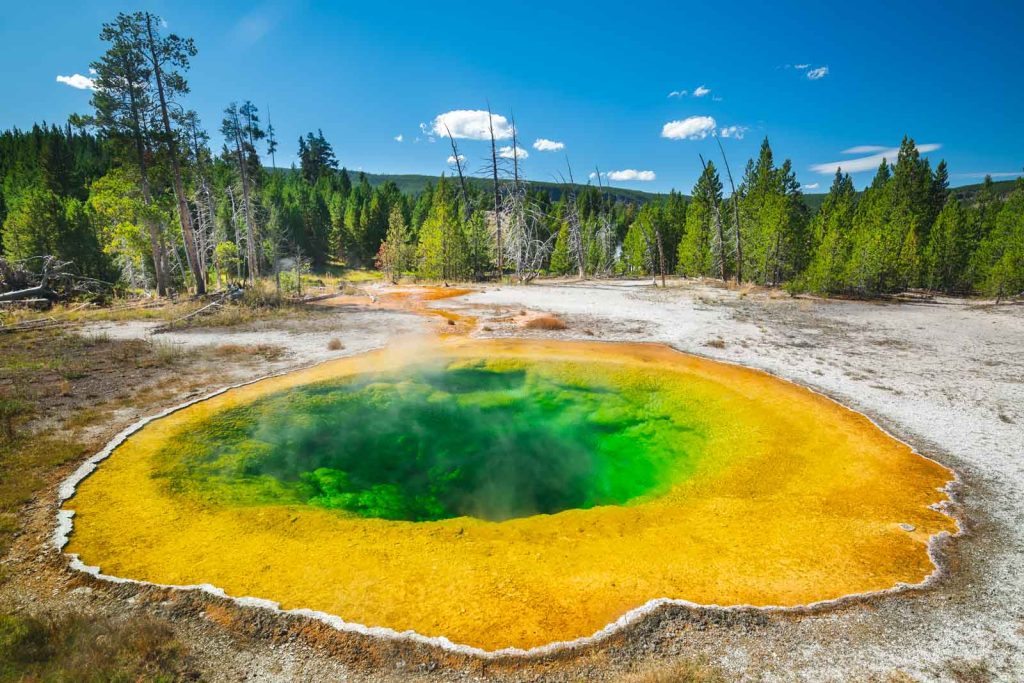[ad_1]
Choosing what to see on your first visit to Yellowstone can be overwhelming. It’s vast, it’s beautiful, and it’s filled with beautiful landmarks. In this article, we show you the best things to do in Yellowstone National Park that you simply cannot miss. We start with the top Yellowstone attractions that you must see in one day, and then continue on for those who have two or three days in Yellowstone NP.
When planning your trip to Yellowstone, we also give you recommendations on where to stay and a handy map for your reference of where things are located. I know that when Dave and I looked at the map before planning our trip to Yellowstone, we felt intimidated. How could we ever cover so much ground to see everything we wanted? Don’t worry, it can be done.
Best Things to do in Yellowstone National Park
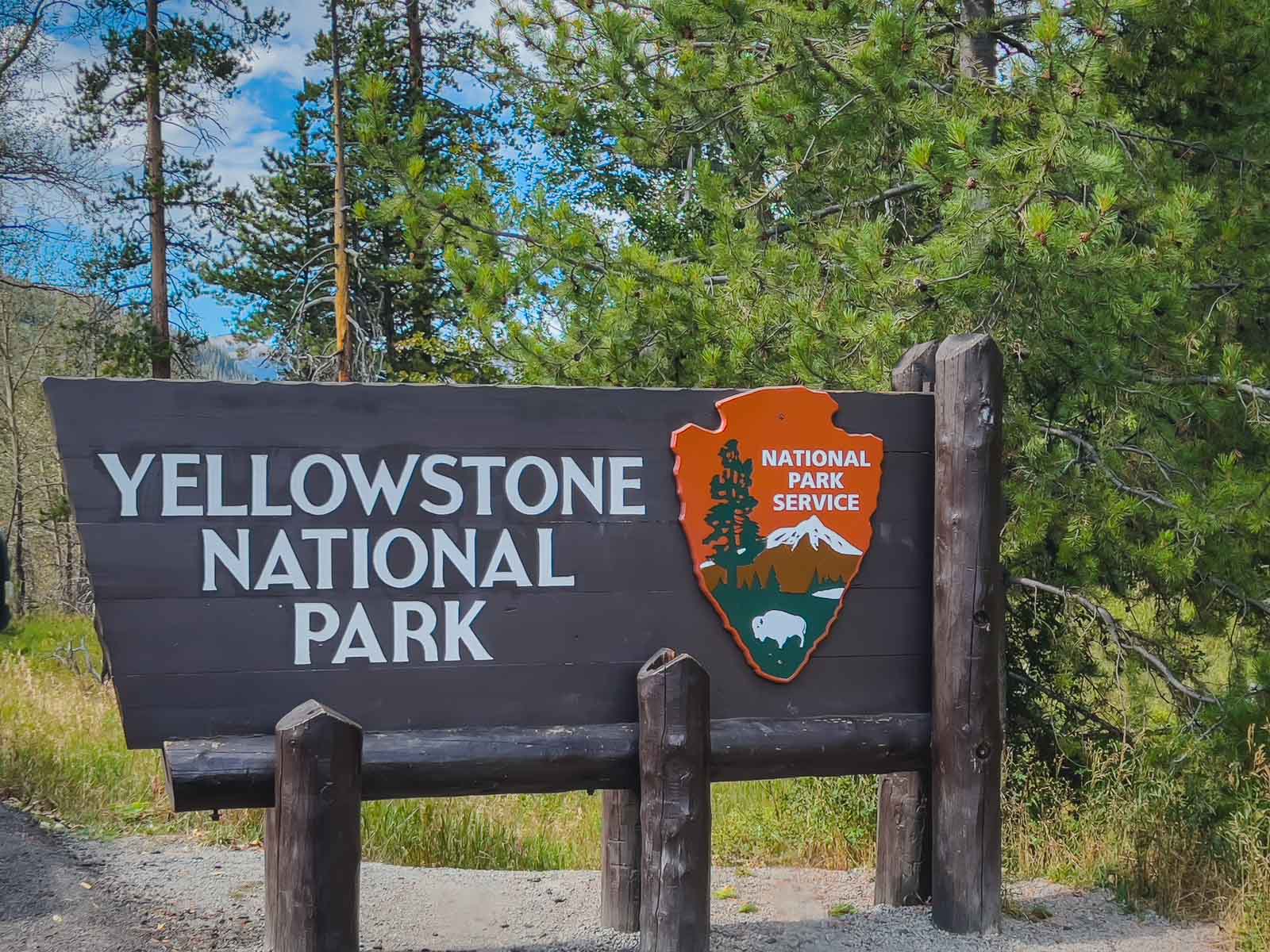
Yellowstone was the first national park in the world, and it is very easy to get around and see its top attractions quickly. With the greatest concentration of geysers on earth, mud pools, waterfalls, and abundant wildlife, you’ll fall in love with Yellowstone.
It costs $35 to enter Yellowstone, but if you plan on visiting any other National Parks in the United States this year, we recommend getting a National Park Pass from the National Park Service for a cost of $80. It’s a significant saving. Make sure to also download the Travel Stories App before visiting Yellowstone. It is an excellent guide highlighting top attractions while driving through the park.
Things to do in Yellowstone NP in One Day
1. Mammoth Hot Springs
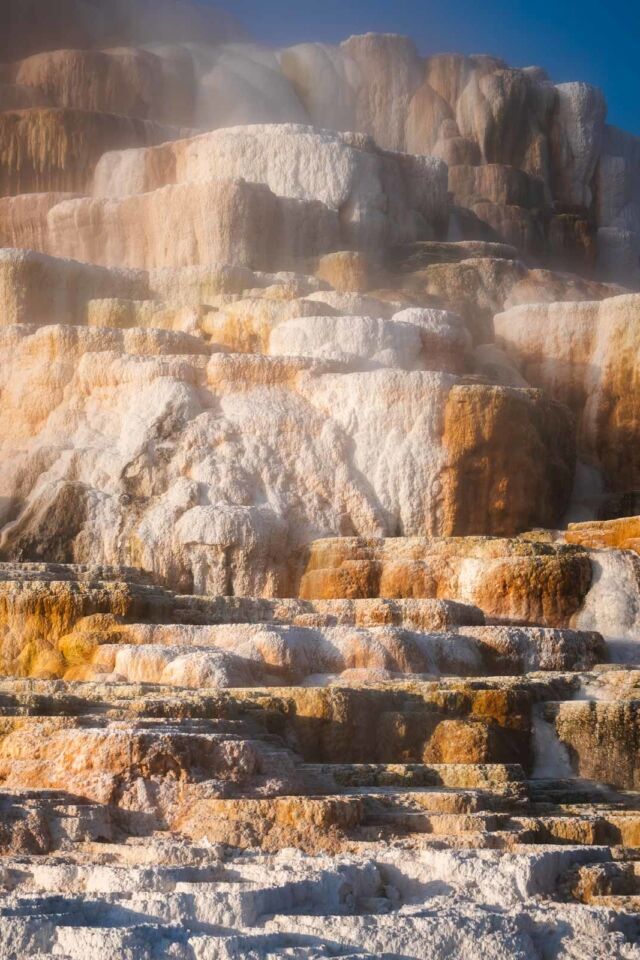
Mammoth Hot Springs was our favorite place to visit in Yellowstone and is rated as one of the best things to see at Yellowstone.
These hot springs aren’t your average geothermal features – they’re a masterpiece of travertine formations, growing at a pace that outstrips any other thermal wonder. Imagine rain and snow melting into the earth, getting superheated by fiery magma below, and then bursting through cracks and crevices, fizzing with carbon dioxide. That’s the magic of Mammoth Hot Springs!
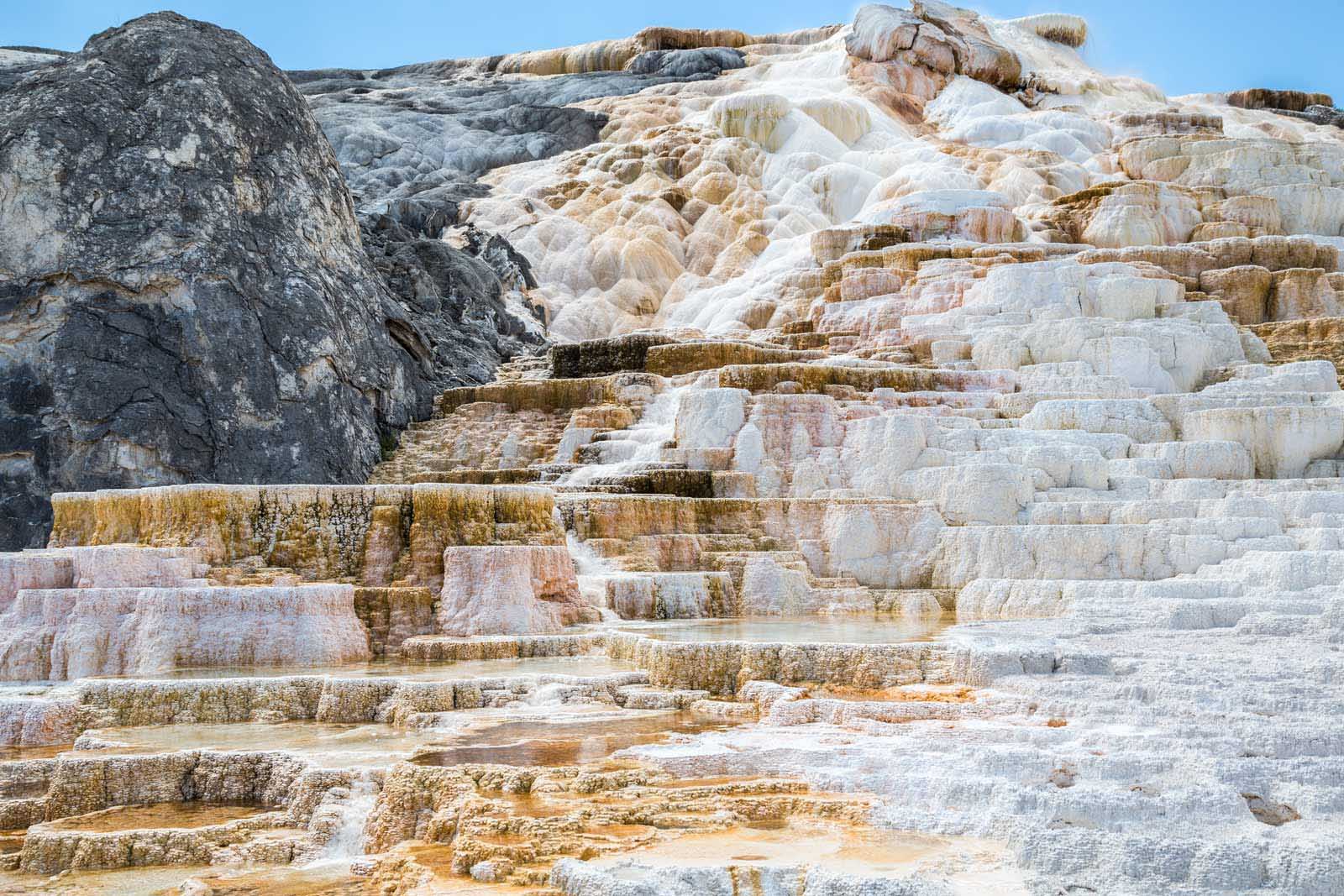
As this scorching, acidic brew dissolves limestone in the depths of the earth, it emerges on the surface, releasing carbon dioxide and creating the stunning travertine terraces that are a signature of this place.
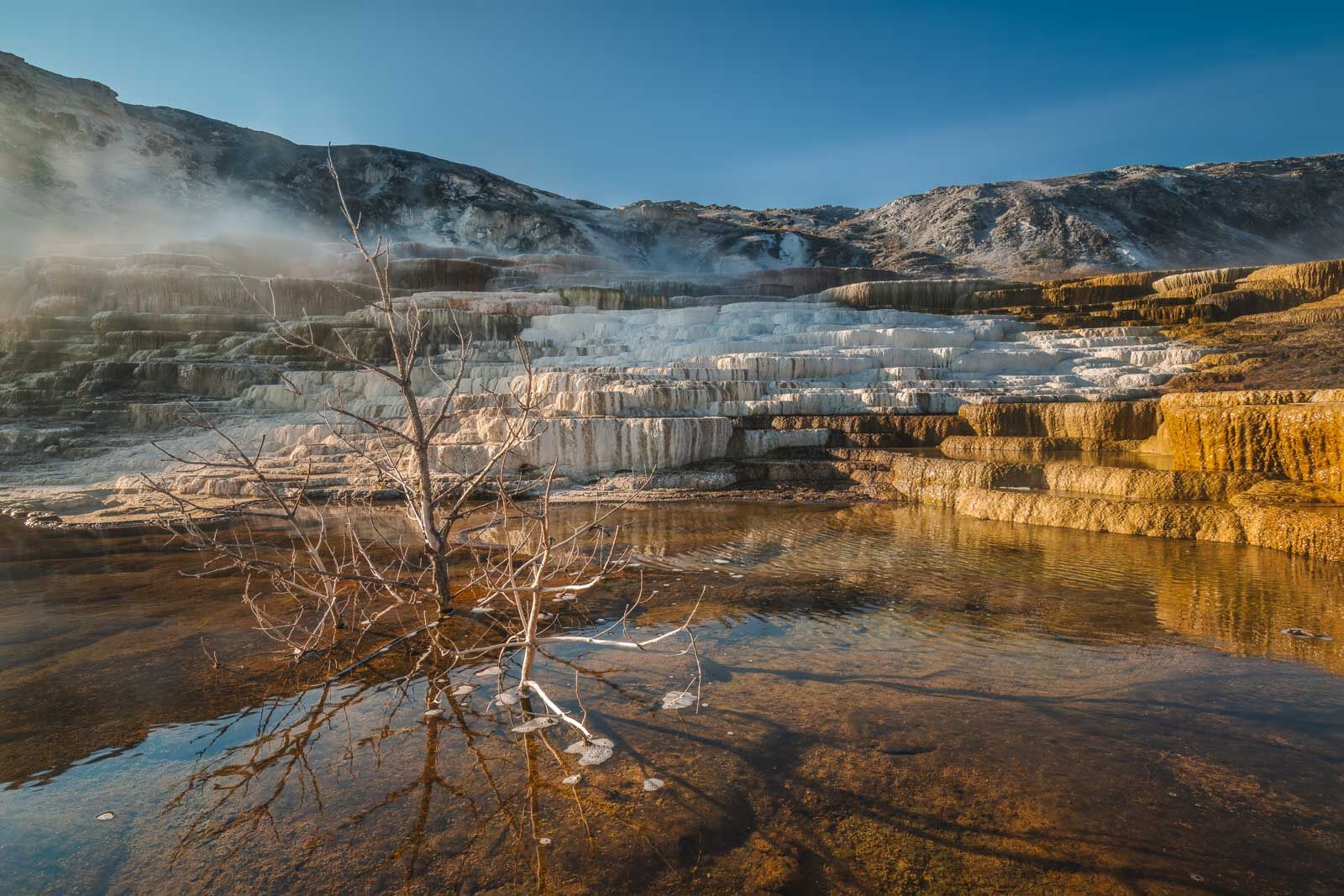
Stroll along the upper and lower terrace boardwalks, and you’ll be greeted by a tapestry of around 50 hot springs. We were expecting a quick look at a tiered waterfall of hot thermal pools, but it was so much more. It is entirely different from other landmarks in Yellowstone National Park, with a vast area of limestone rock created by gases escaping the earth, forming mountains of white chalky terraces.
We started at the lower terrace boardwalk from the parking lot located directly on the Grand Loop. Here, we walked out to the most famous formation, The Liberty Cap, a towering 37-foot hot spring cone, and then continued along the boardwalk to see the beautiful terraces. You can continue upward along the boardwalks from the Lower Terrace Boardwalk to see the Upper Terraces.
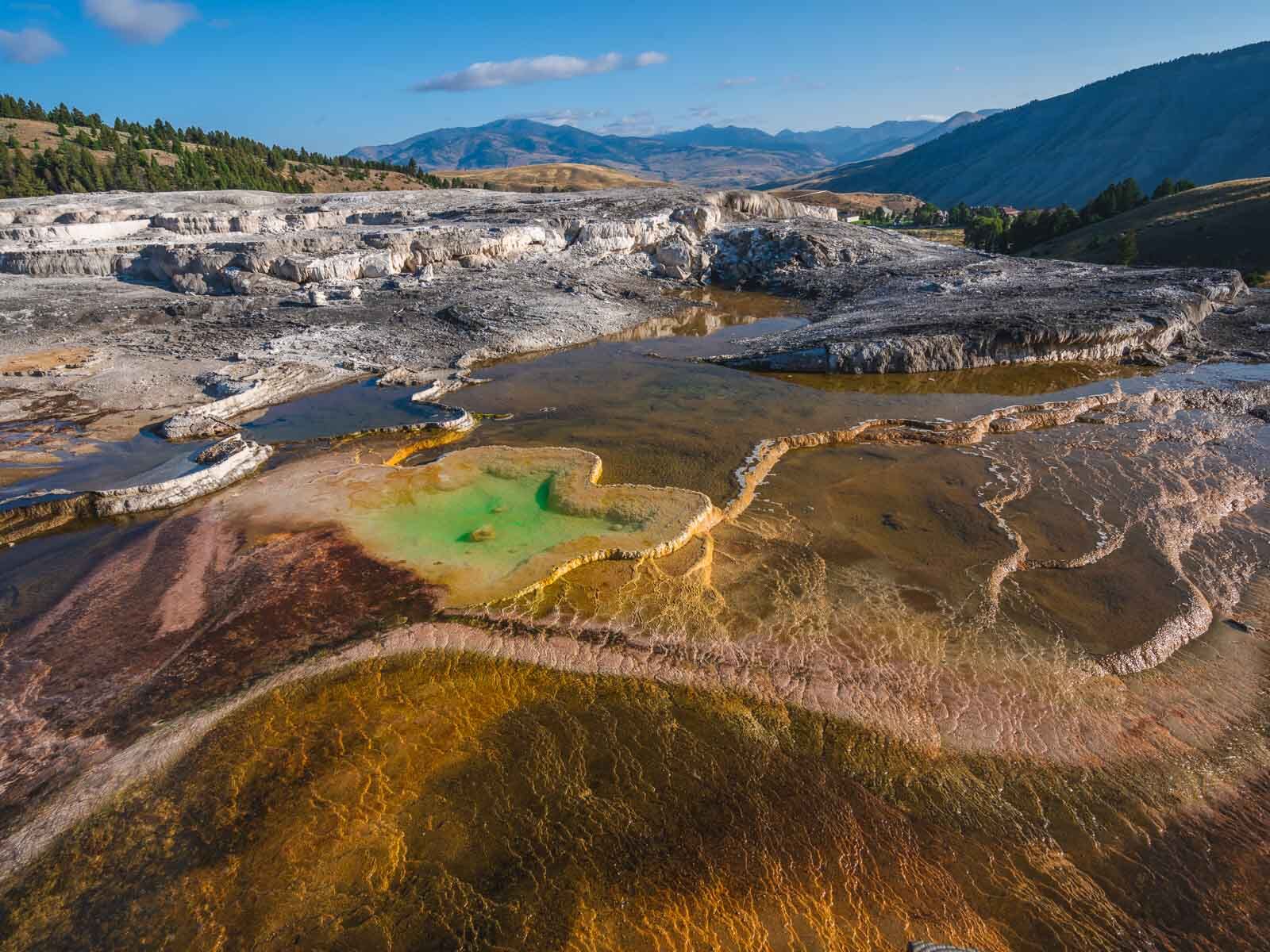
If you don’t want to walk too much, there are parking lots near different sections of the hot springs where you can park and walk out for closer looks. The parking lots fill up quickly, so if you see a spot, take it.
At the Upper Terrace, you are in for more surprises. Here, you’ll find Prospect Terrace, New Highland Terrace, and Orange Spring Mound, along with Bath Lake, White Elephant Back Terrace, and the ethereal Angel Terrace. Each spot is a world unto itself, adorned with vivid microorganisms that paint the landscape in surreal hues.
When to visit Mammoth Hot Springs
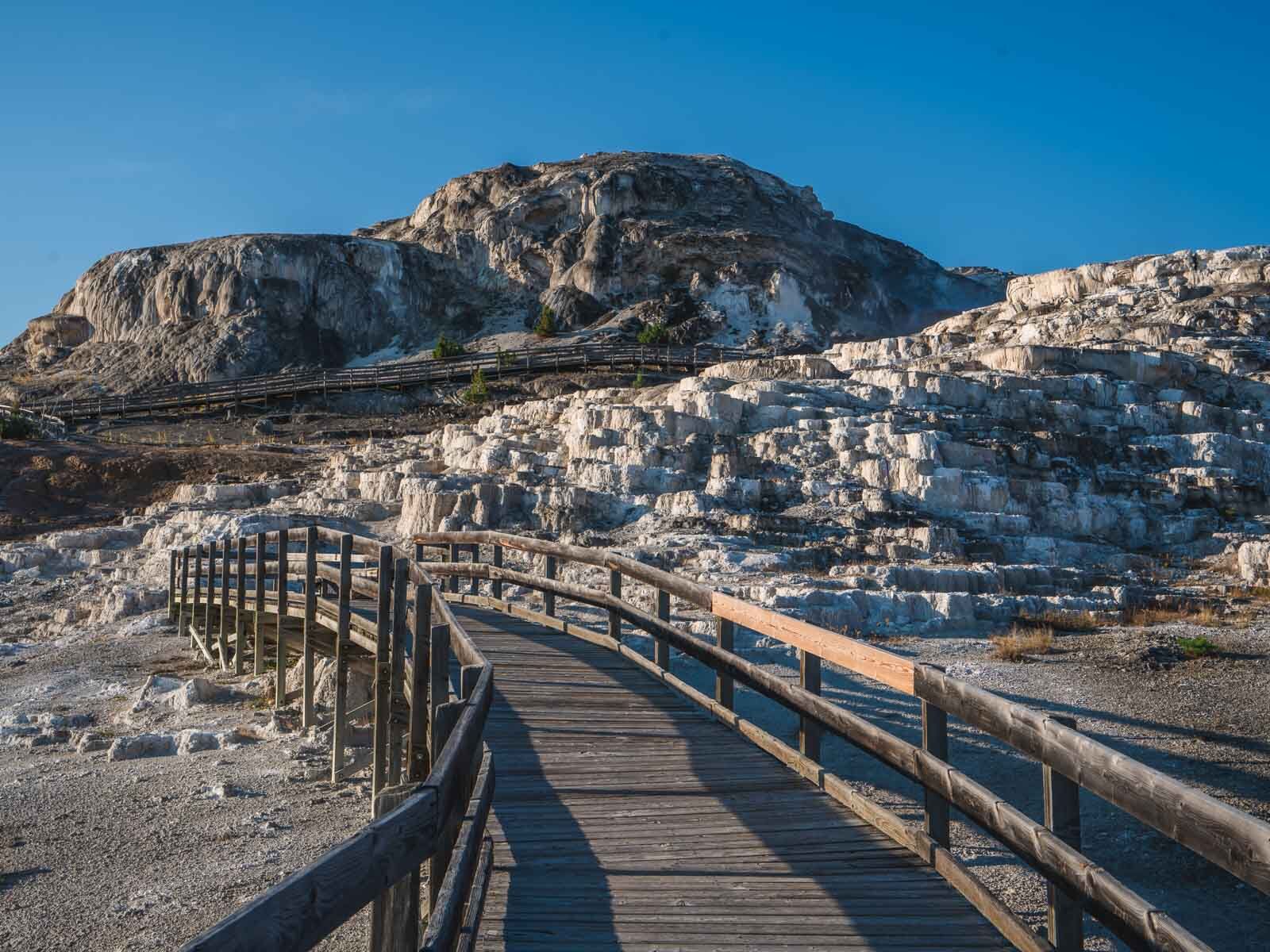
The best time to visit Mammoth Hot Springs is early in the morning. In September, we had very few crowds to deal with. We were often the only ones on the boardwalk and had gorgeous views. In the morning, the sunrise was beautiful coming over the mountains. If you can’t make it in the morning, another good time to visit Mammoth is late afternoon.
Where is Mammoth Hot Springs
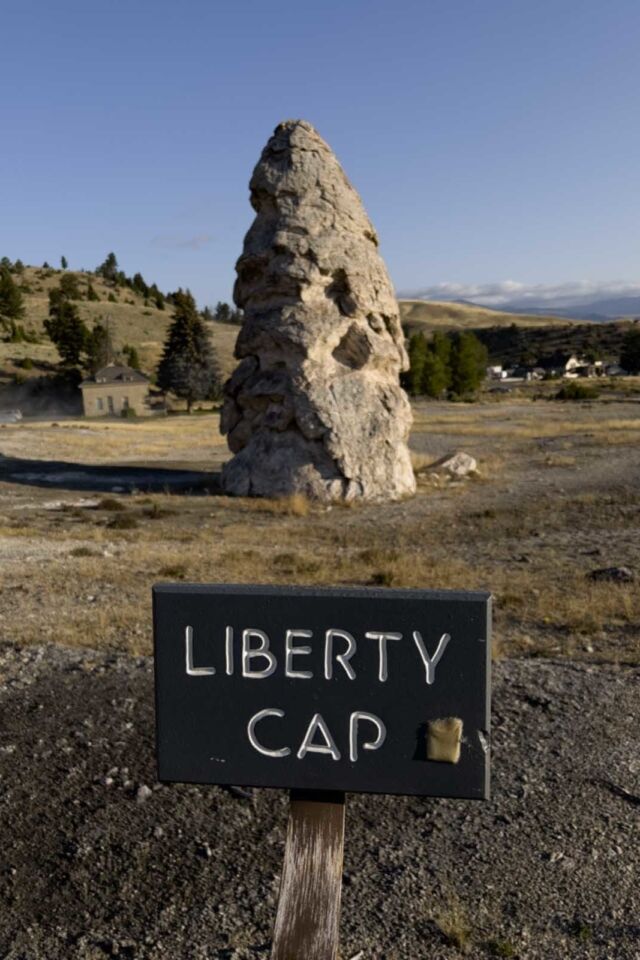
Nestled near Gardiner, Montana, Mammoth Hot Springs is a year-round wonder accessible by car. The well-laid boardwalks span about 1.75 miles around the terraces, offering an easy yet awe-inspiring hike that’ll take roughly an hour.
Mammoth Hot Springs is located near the North Entrance of Mammoth Hot Springs Village. In the village, there is a gas station and a general store where you can buy coffee, souvenirs, and snacks, and there are clean public washrooms to use.
2. Grand Prismatic Spring at Midway Geyser Basin
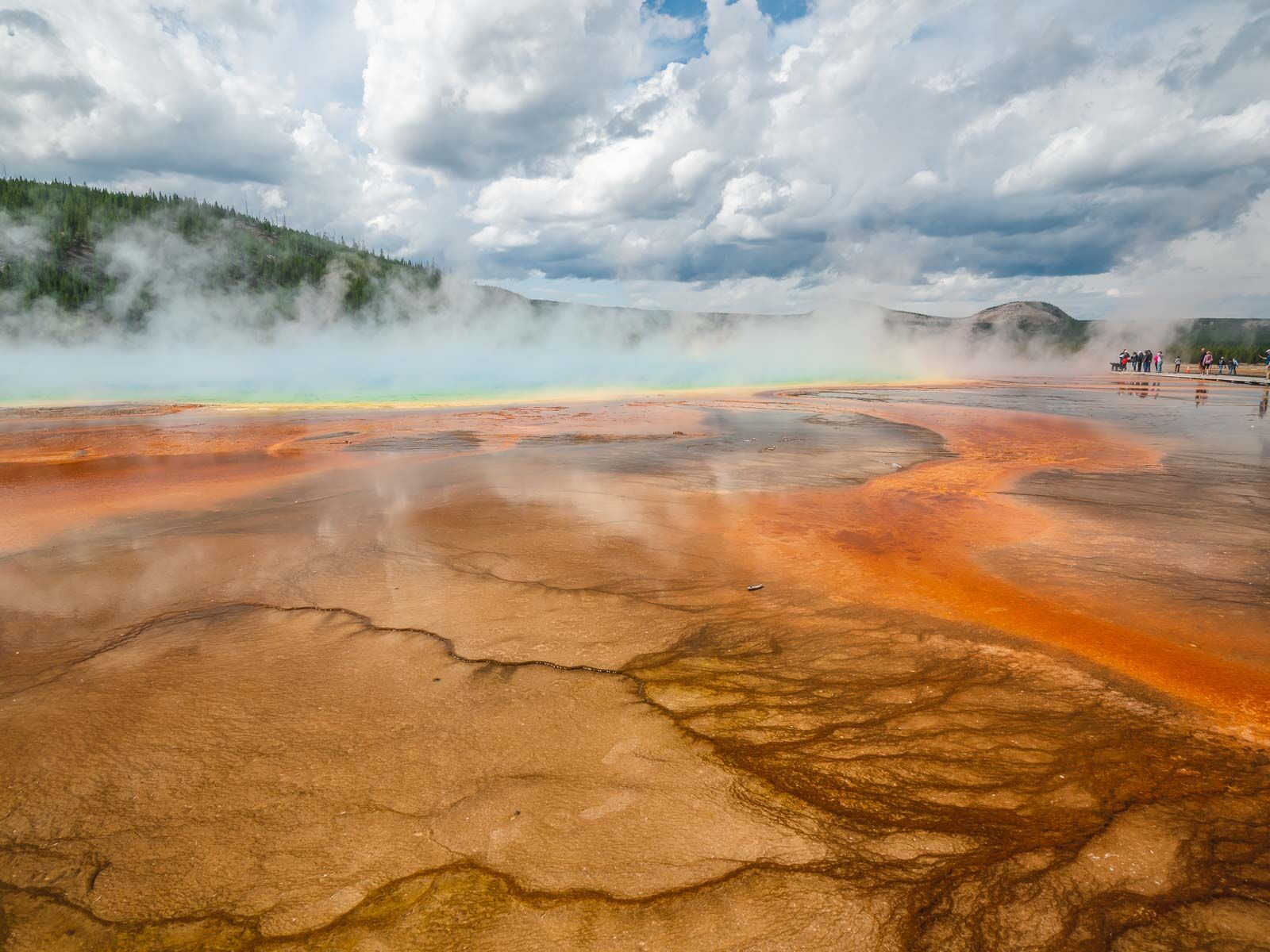
The next place we suggest visiting after Mammoth Hot Springs is Grand Prismatic Spring. This is the “wow destination” in Yellowstone that is on all the brochures and travel websites; when you visit Yellowstone, it is not to be missed. Most people have this as number one on their things to do in Yellowstone list, and for us, it is a close second. This is an incredibly beautiful spring.
Grand Prismatic Spring is the largest hot spring in the United States, and its vivid colors will take your breath away. The colors are made up of microorganisms that band together, creating a mass of color. Read more: The Essential Guide to Grand Prismatic Spring, Yellowstone
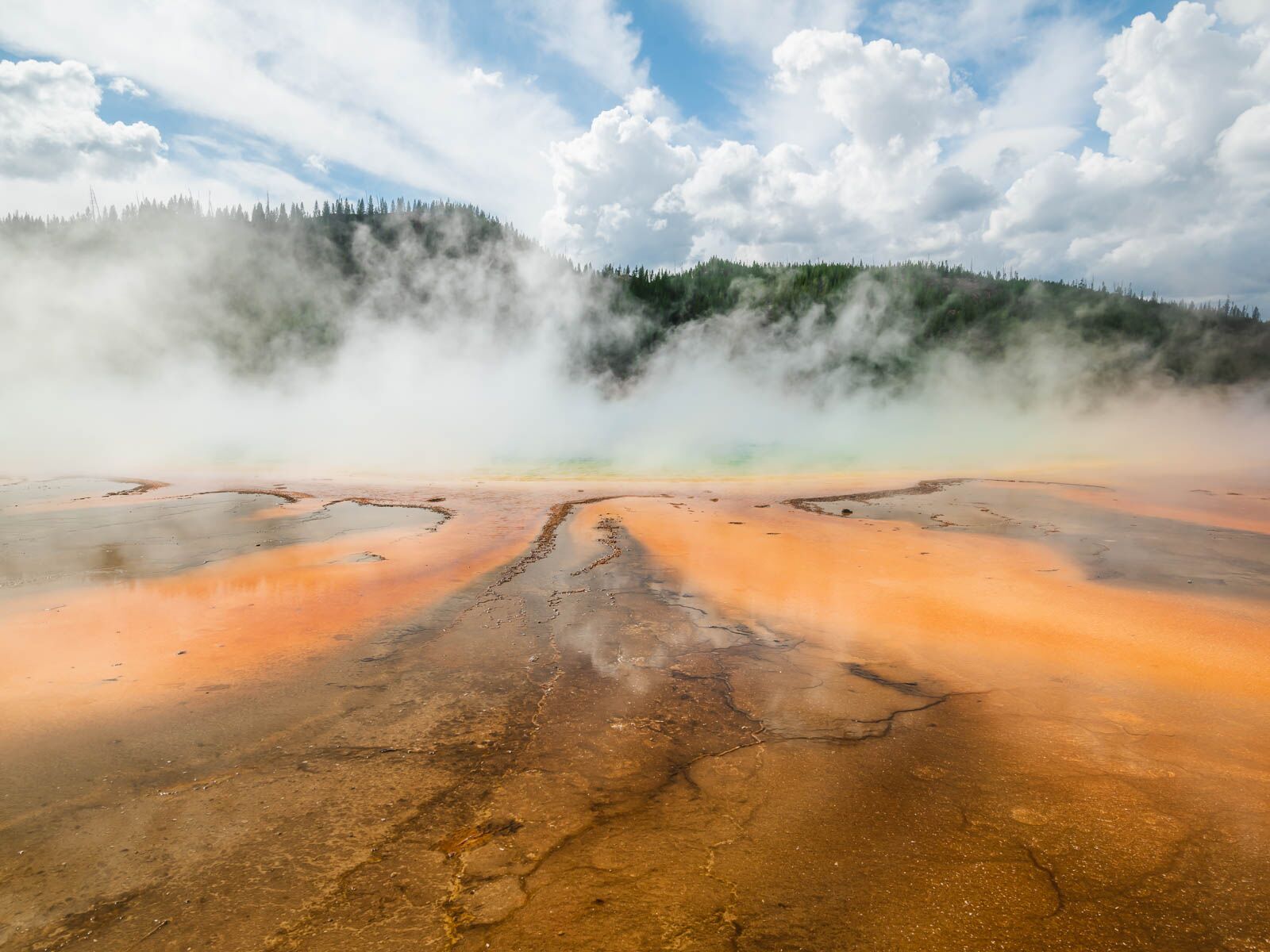
The best time to visit Grand Prismatic is midday when the sun is higher (that is why we have this as our second stop on your Yellowstone Itinerary). When it is bright outside, the color of the spring really pops. It may be busier and crowded, but mid-day is the best time to view Grand Prismatic Spring. It doesn’t matter too much if it is crowded as you must stay on the designated boardwalks, so you have unobstructed views of the spring anyway.
Parking: It will be busy at Grand Prismatic when you arrive, so if you see a parking spot on the road before the parking lot, take it. We stayed in line to park in the lot and spent about 20 minutes stuck in our car.
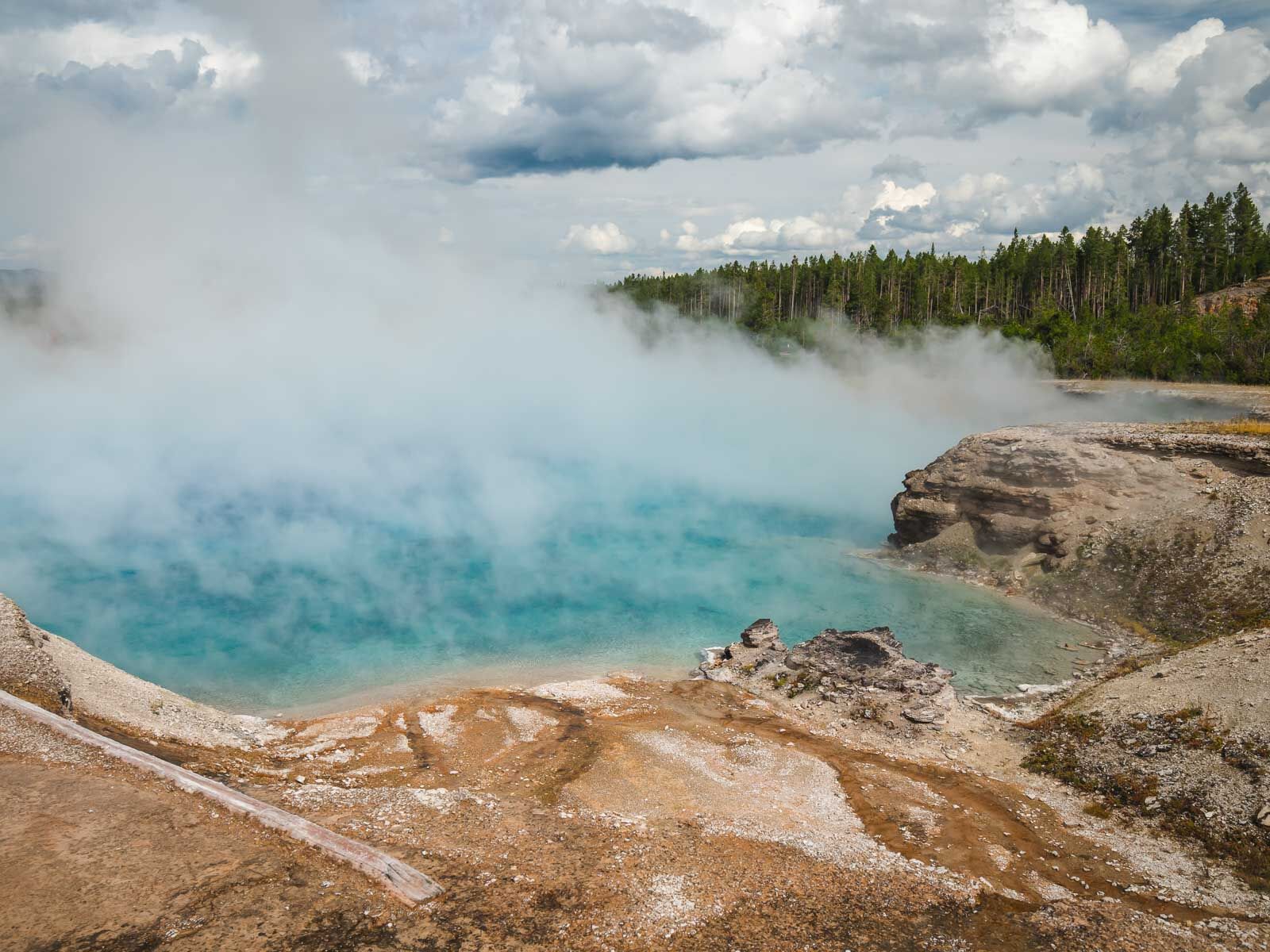
A visit to the Grand Prismatic Spring takes you along a series of boardwalks through different hot springs. Make sure to stop at the deep cavern of Excelsior Geyser, look for the mineral deposits along Yellowstone River, and on your way out, stop at Opal Pool. It was a stunning small pool that is often overlooked.
Bison are often roaming around the hot springs, and we saw some ourselves. Also, the steam shooting out of the ground near the Firehole River is impressive. We spent about an hour here taking in all the views and could have spent longer.
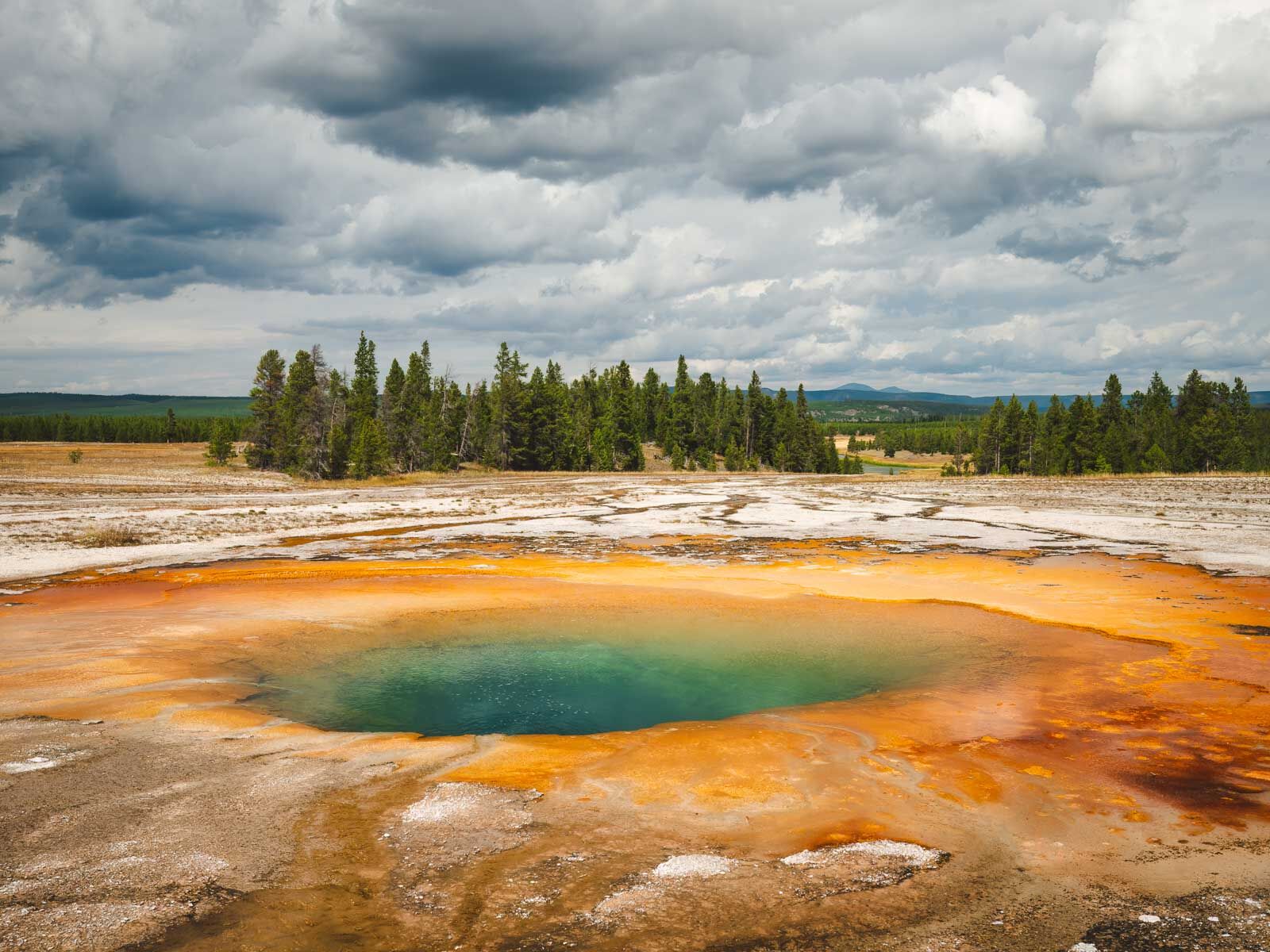
Accessibility: The pathways at Grand Prismatic Spring are accessible, making it easy for everyone to see Yellowstone National Park’s star attraction. The trailhead to Midway Geyser Basin begins at the parking lot, so it is very easy to find.
The surface is flat and even making it easy to walk around. Many of the attractions in Yellowstone are accessible (or at least partially accessible). The park has done an amazing job of making it possible for everyone to see these natural wonders.
3. Grand Prismatic Spring Overlook
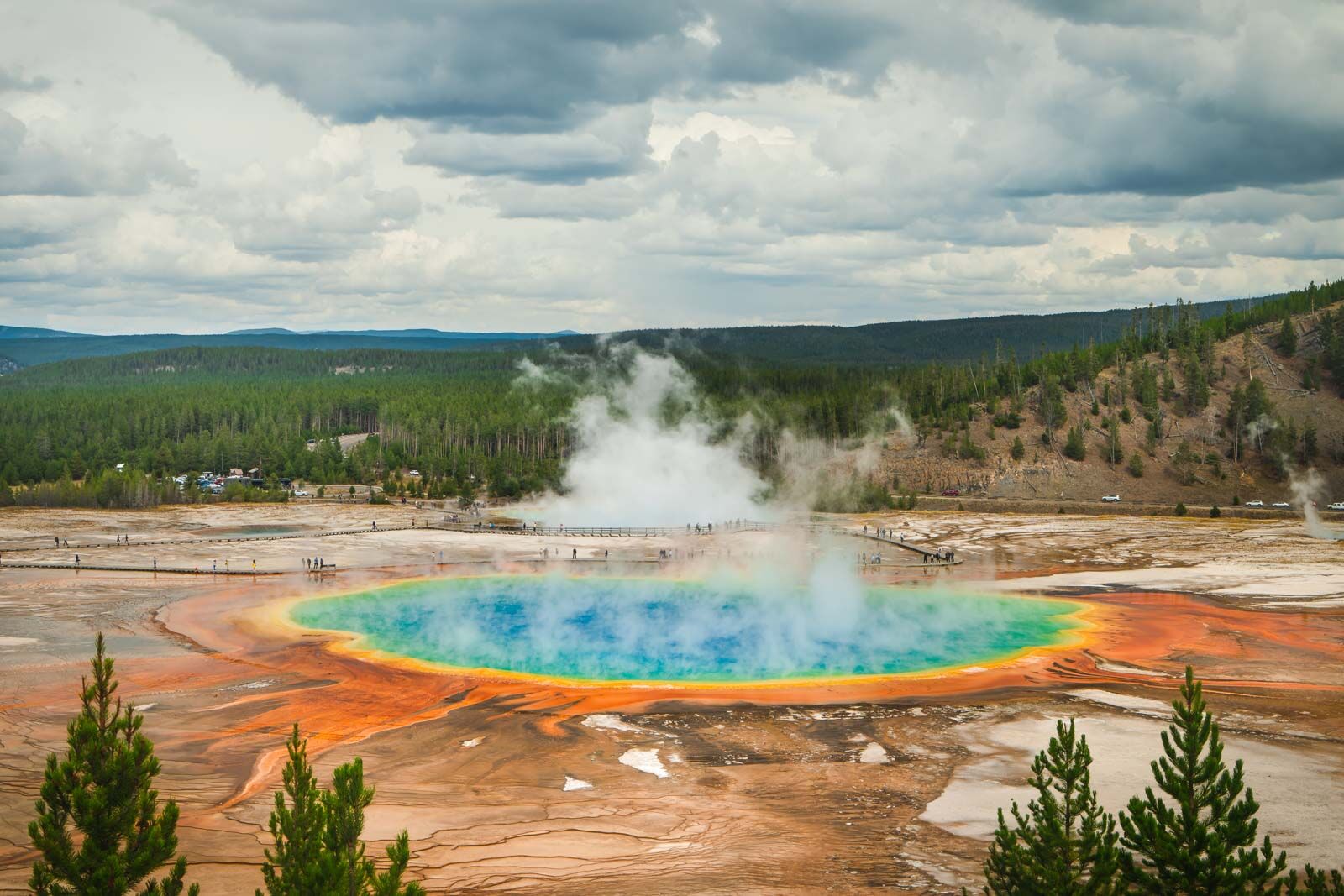
If the sun is out when you arrive at the Mid Geyser Basin, we suggest going directly to the Grand Prismatic Spring Overlook before taking the walk around the Grand Prismatic Hot Spring below. This is the best view of Grand Prismatic Spring and the surrounding colorful hot springs from above without doing a helicopter tour.
The Walk out to Grand Prismatic Overlook takes about 20 minutes and is uphill. The path is well-marked and easy to follow.
The platform at the overlook is small and there is really only one place with unobstructed views, so make a beeline to the center to take photos of the colors of Grand Prismatic Spring below. You can capture the entire hot spring with a wide-angle camera lens or with your iPhone.
4. Fairy Falls Trail
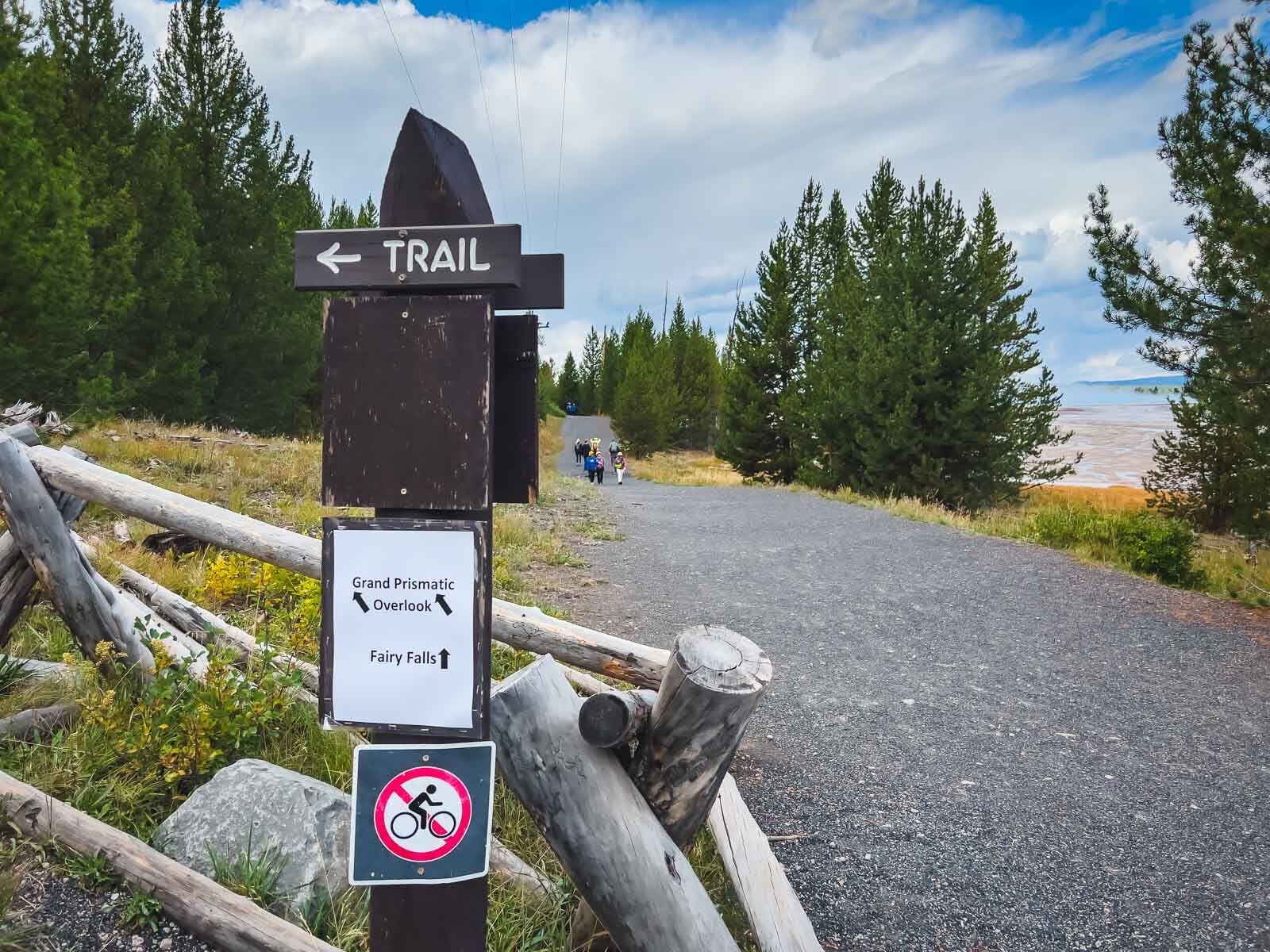
When you come to a fork, you can also veer off to see Fairy Falls—another one of the popular things to do in Yellowstone. If you only have one day, we don’t recommend hiking to Fariy Falls, but if you spend more than a few days in Yellowstone National Park, you can continue to hike the Fairy Falls Trail. The trail to Fairy Falls itself is about 5.4 miles (8.7 km) round trip. However, there are options to extend the hike to include other points of interest.
Fairy Falls are approximately 197 feet (60 meters) high, cascading in a thin veil, giving them a delicate, “fairy-like” appearance. Read more: 12 Best Hikes in Yellowstone National Park
5. Old Faithful Geyser
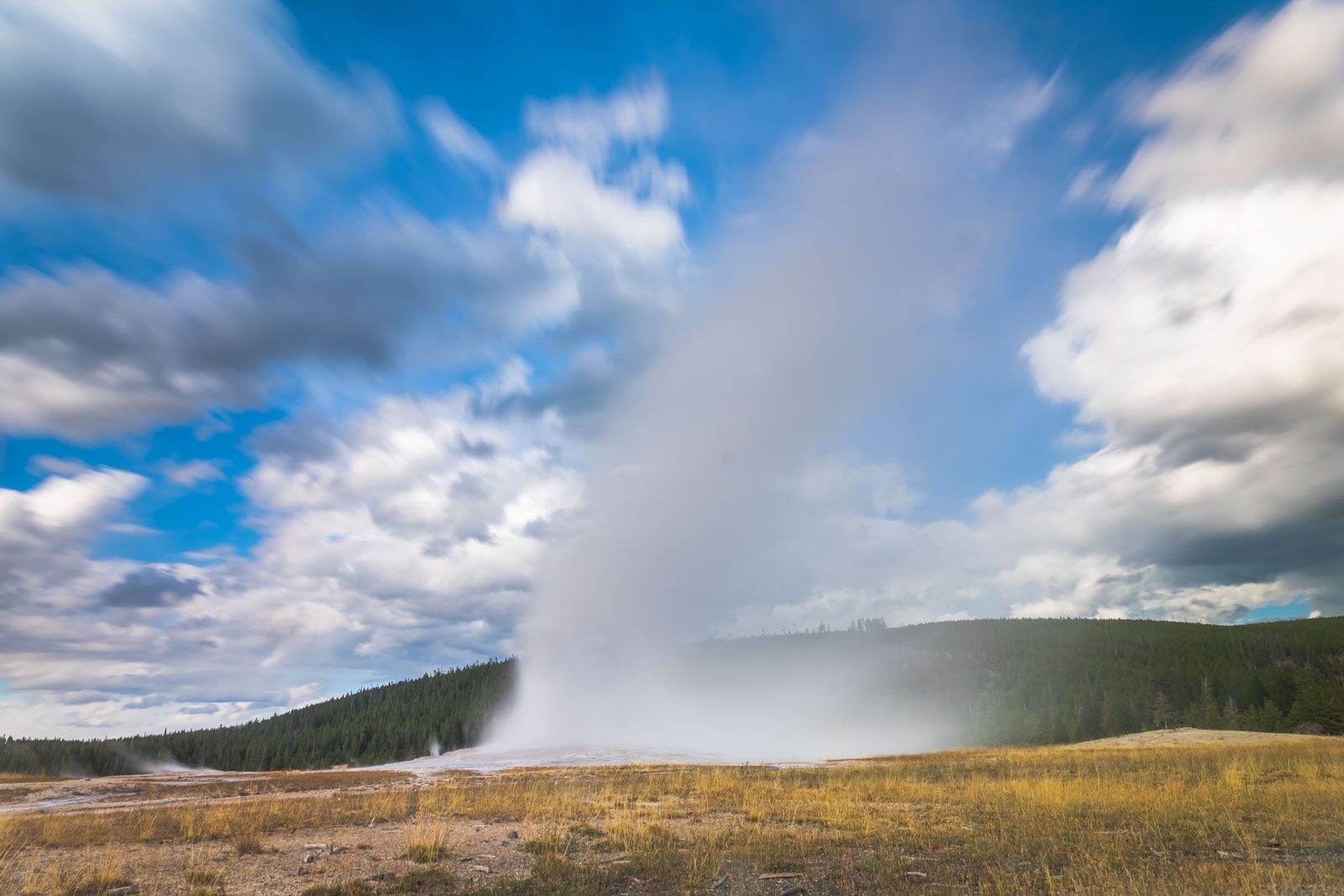
Okay, it is the most famous of things to do in Yellowstone National Park, and no trip to Yellowstone would be complete without seeing Old Faithful. The reason it is called Old Faithful Geyser is that it is a predictable geyser; they can predict when it will erupt throughout the day.
Without fail, Old Faithful erupts every 60 to 110 minutes, and the National Park Service can predict its eruption within 10 minutes on either side.
To find out when the next eruption will be, pop into the Visitor Center, Old Faithful Inn, or Old Faithful Lodge for information on when the geyser is expected to erupt. Or ask the park ranger who is walking around and offers updates as well.
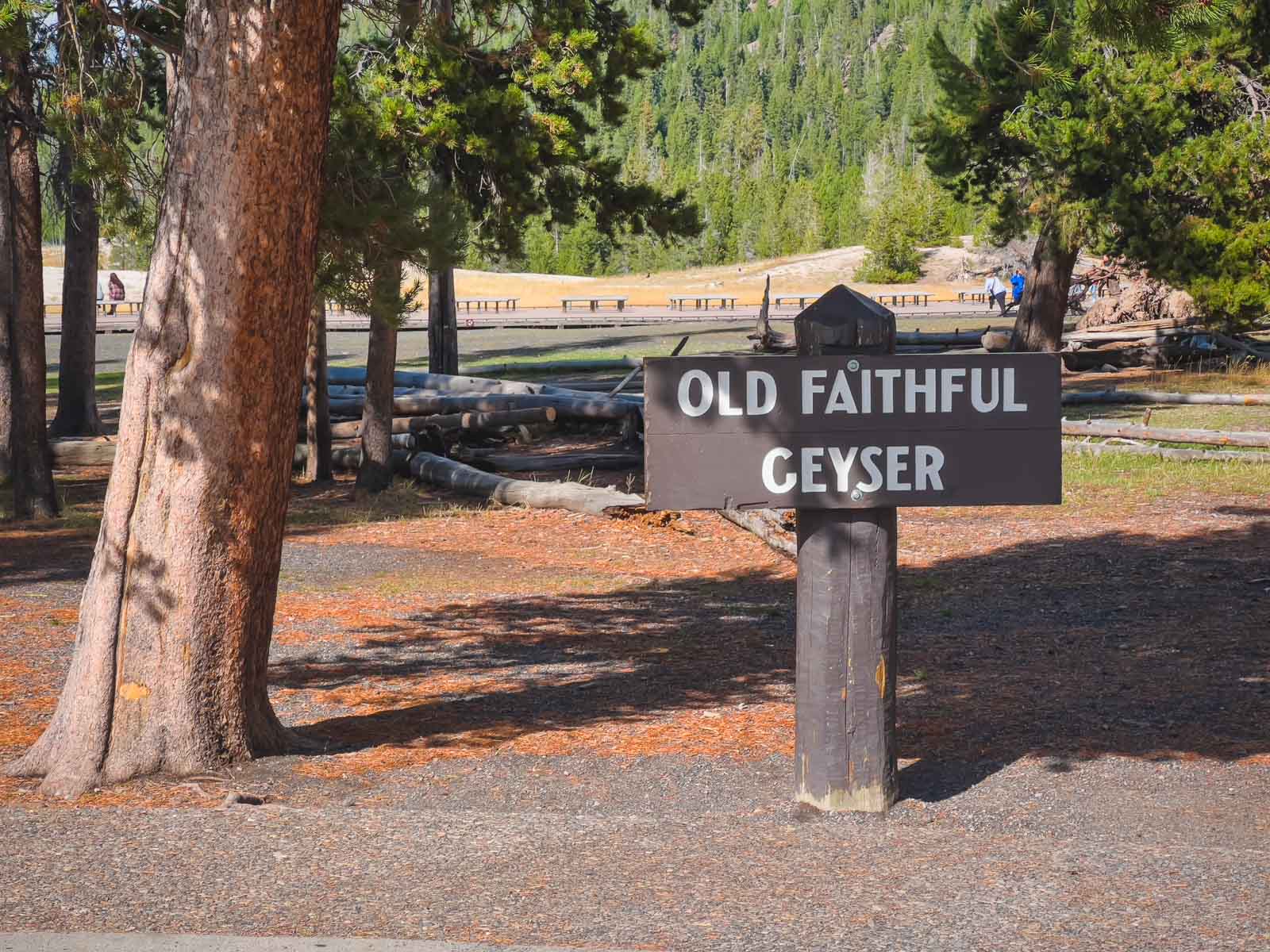
True to form, Old Faithful erupted almost precisely as predicted. The eruption lasted for about five minutes and reached about 120 feet into the air. I was impressed as, for one, I can’t believe it is so predictable, and two, I thought it was so cool to see steam and water shooting into the air. Even if you aren’t impressed by that (like Dave), you must see Old Faithful erupt when you visit Yellowstone National Park.
When to visit Old Faithful
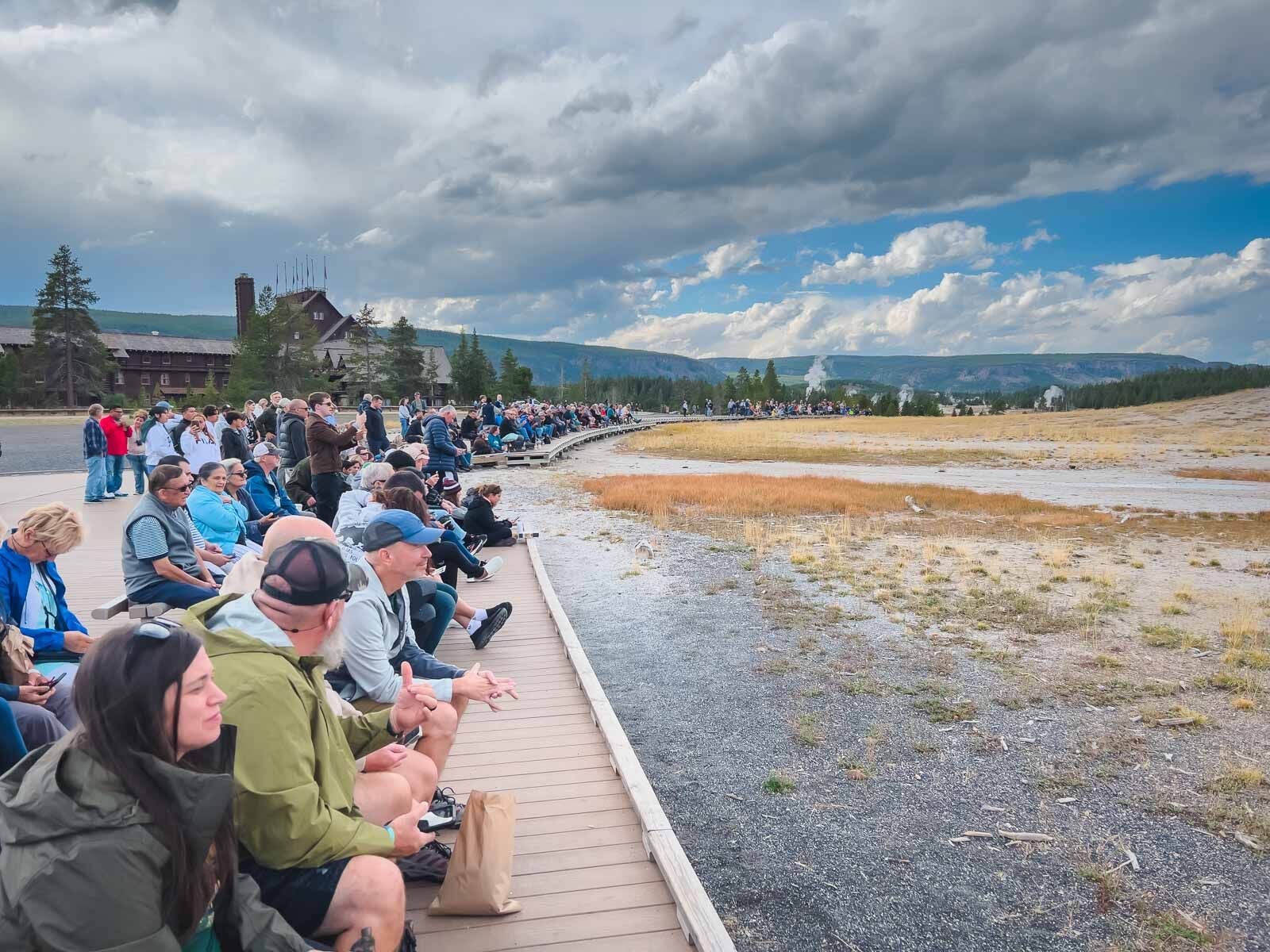
Old Faithful is the most popular attraction in Yellowstone National Park, so you will see crowds regardless of the time of day, but it really doesn’t matter. There is a seating area around the geyser to watch Old Faithful erupt, so most of the crowd sits down. Even if you are standing, Old Faithful Geyser shoots 120 feet into the air so you will see it.
Apparently, 6 pm is the busiest time for bus tours, so the only suggestion we have is to avoid that time. Besides, you’ll definitely want to be somewhere else at 6 pm (more on that later)
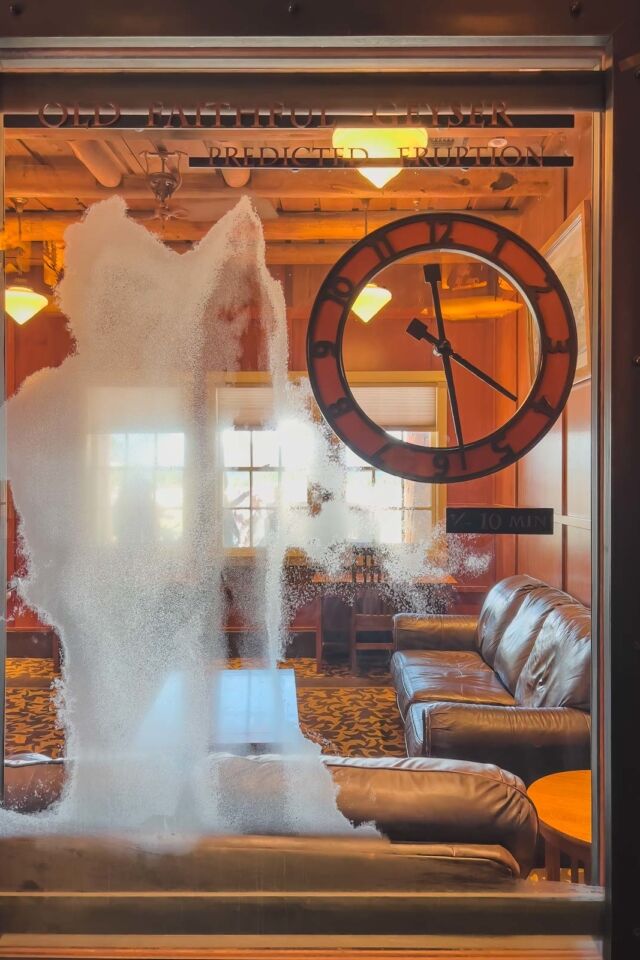
We visited Old Faithful just a little after lunch at about 2 pm, and the crowds weren’t bad. We took a seat in the front row and spread our bags out in front of us so nobody would walk through or side down to obstruct our view.
Since no one can walk directly on the Upper Geyser Basin grounds and must stick to the boardwalks and designated hiking trails, there are completely unobstructed views all around this amazing wonder.
Lunch at Old Faithful
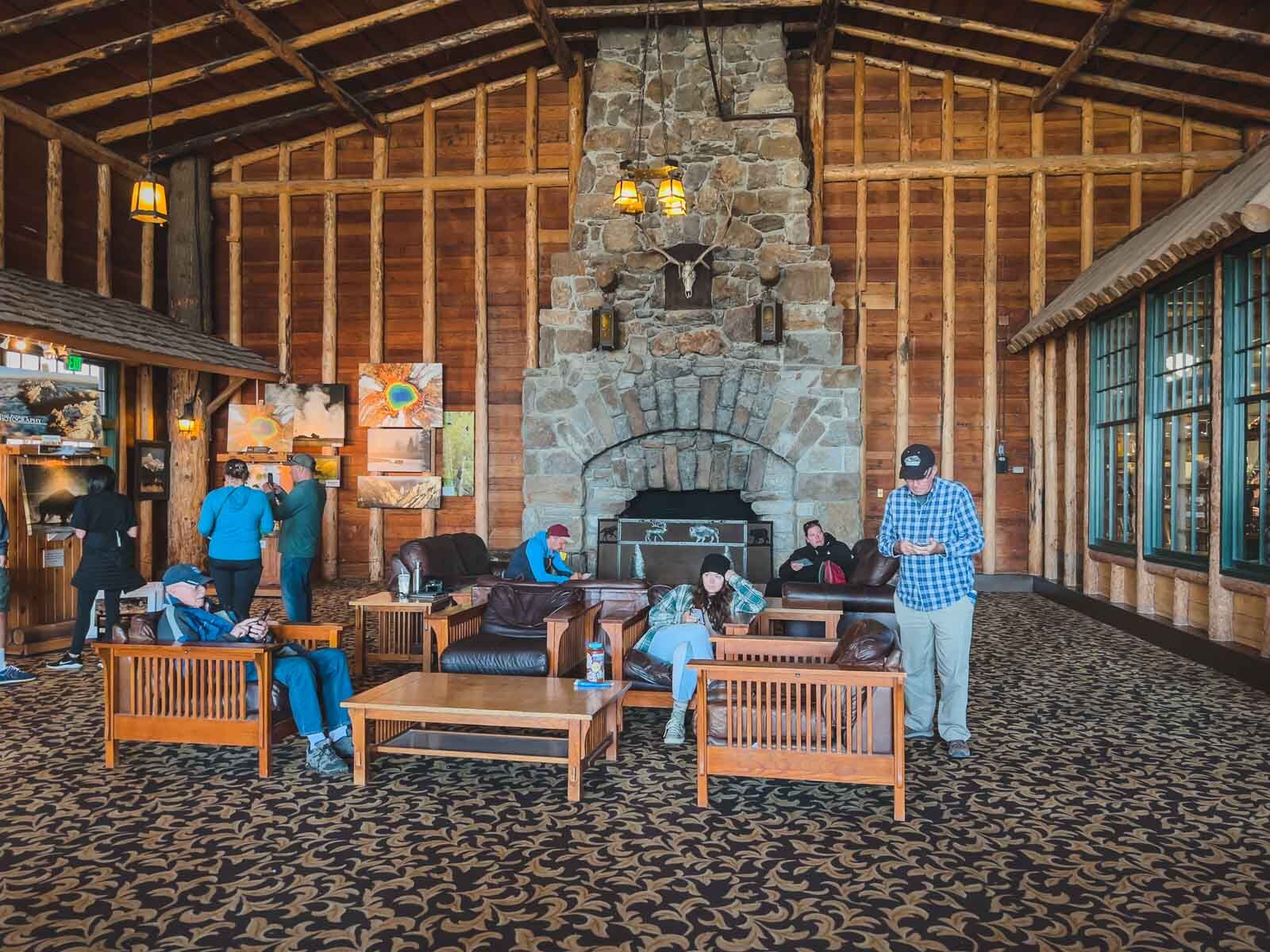
When we arrived, we saw that we had about a little over an hour until the next eruption. This was the perfect time for us to settle in for lunch while we waited.
Around Old Faithful Geyser and Upper Geyser Basin, there are plenty of places to eat, hotels, and a visitor center. Old Faithful Inn has a fantastic outdoor terrace overlooking Upper Geyser Basin and Old Faithful, or you can grab a drink at the Bear Pit Lounge inside. Old Faithful Lodge has a cafeteria-style restaurant looking out over Old Faithful and there is food at the Old Faithful Snow Lodge.
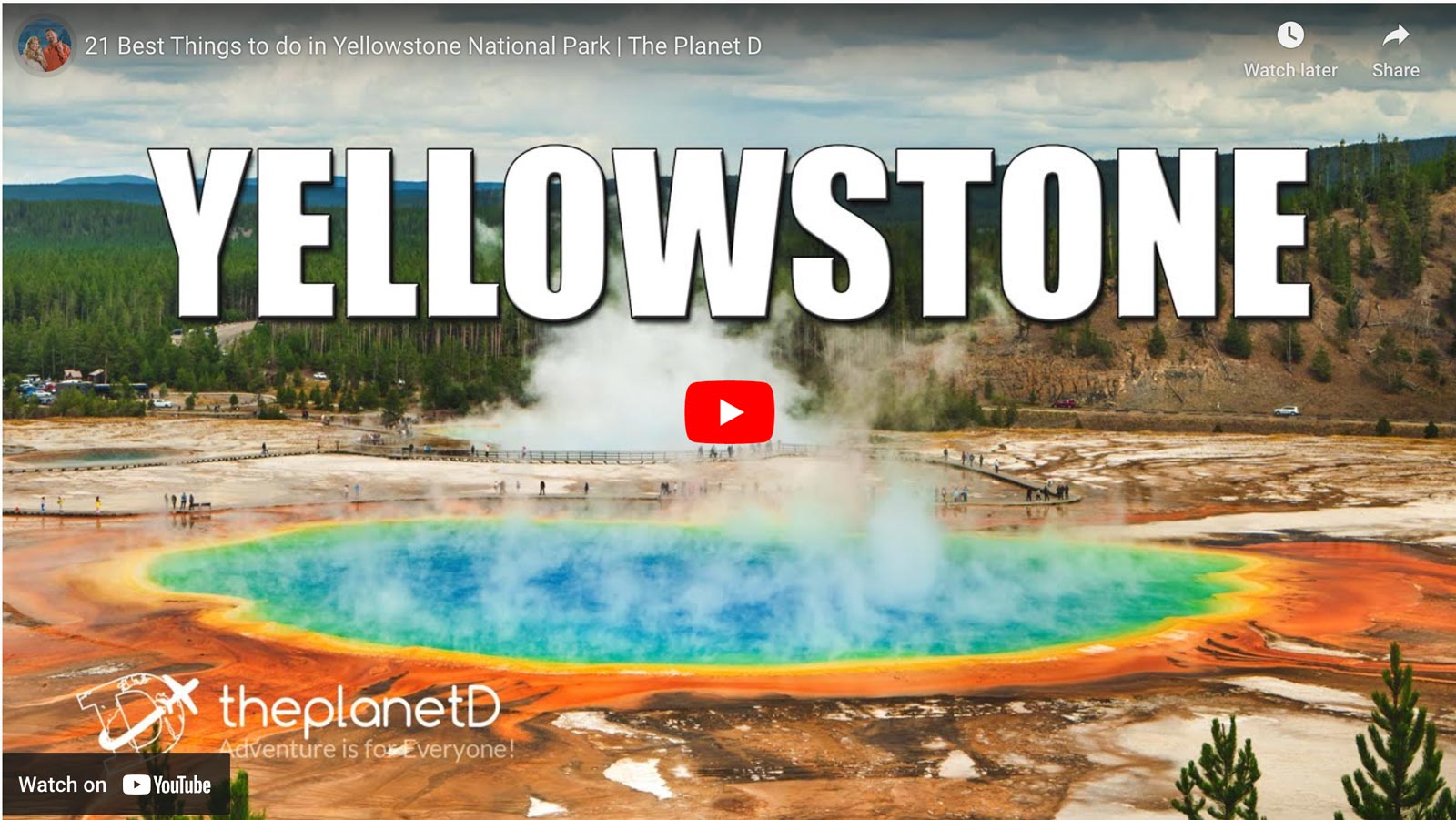
Just remember, if you do go for lunch, make sure to be back for the eruption at least 20 minutes before the scheduled prediction or you may not get a seat if that is important to you. Otherwise, you can watch it from the terrace of Old Faithful Inn or the Old Faithful Lodge, and you can stand.
6. Upper Geyser Basin
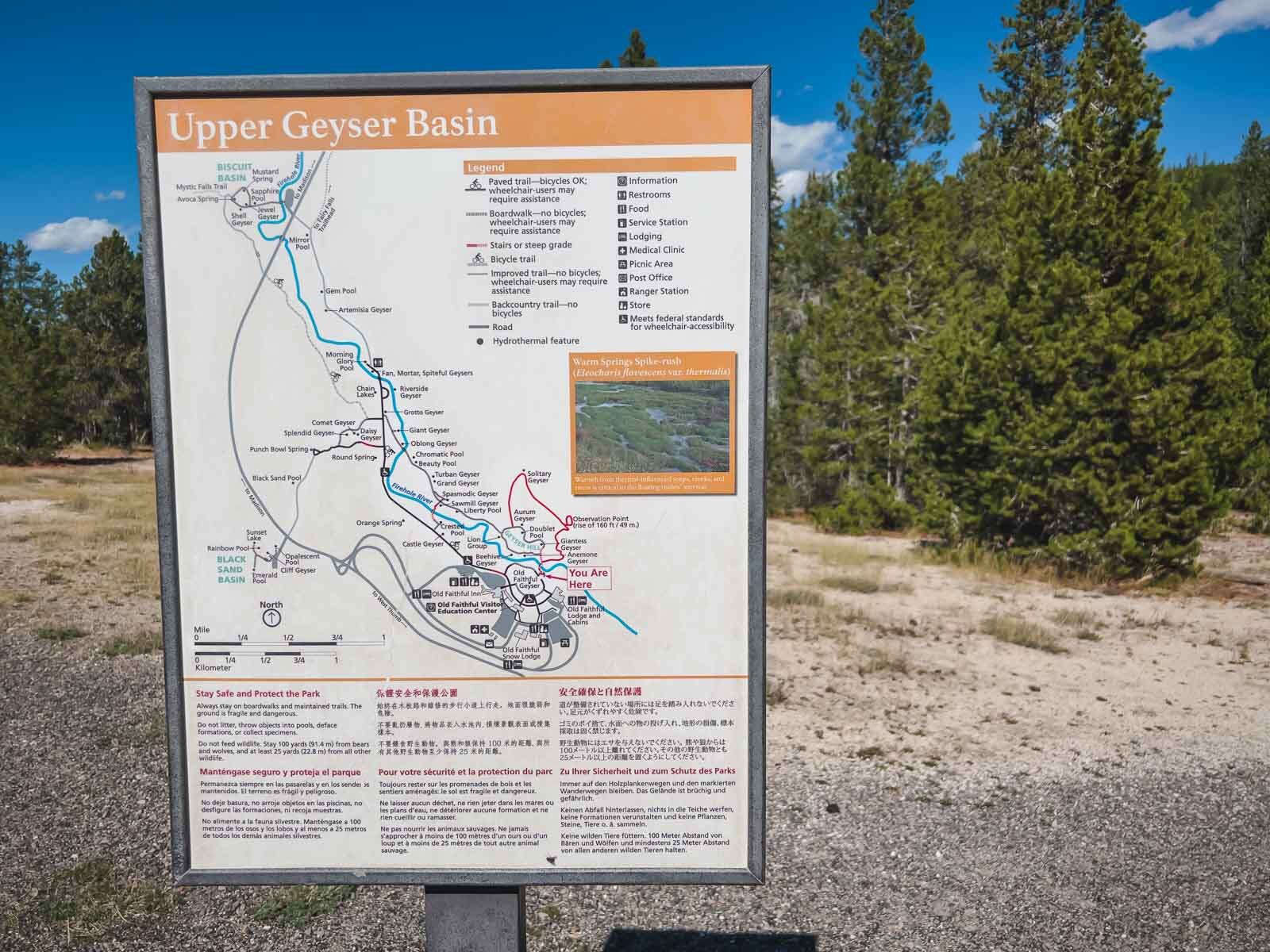
Once we watched Old Faithful erupt, most of the crowd disappeared and returned to their car or tour bus, but they were truly missing out on one of the best things to do in Yellowstone National Park. Exploring the Upper Geyser Basin was a highlight for us.
There are 150 geysers in the Upper Geyser Basin of Yellowstone. It has the largest concentration of geysers and geothermal features in the world, it houses the tallest active geyser on earth and the famous Morning Glory pool.
How to Get Around Upper Geyser Basin
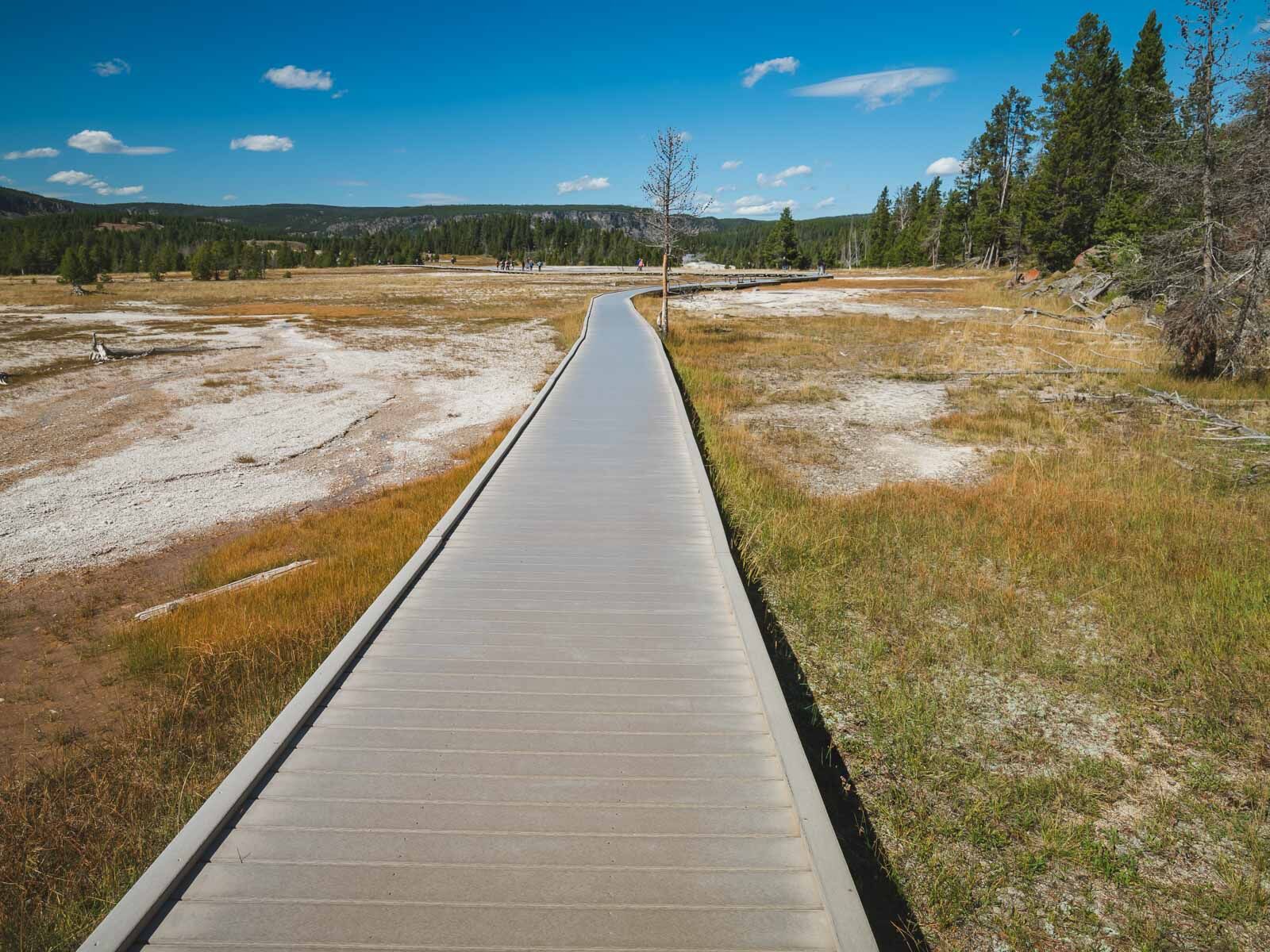
There are hiking trails, bike paths, and boardwalks all around the Upper Geyser Basin area. The entire loop is about six miles, and to see it all can take a full day, especially if you stop to take photographs and videos every spring like us! At least half a day is good, though.
From Old Faithful, you can follow the trails all around the geysers. You can walk around the Geyser Hill Loop, where a path leads to Observation Point, which is one of the best vantage points to watch Old Faithful erupt, and even hike out to Biscuit Basin.
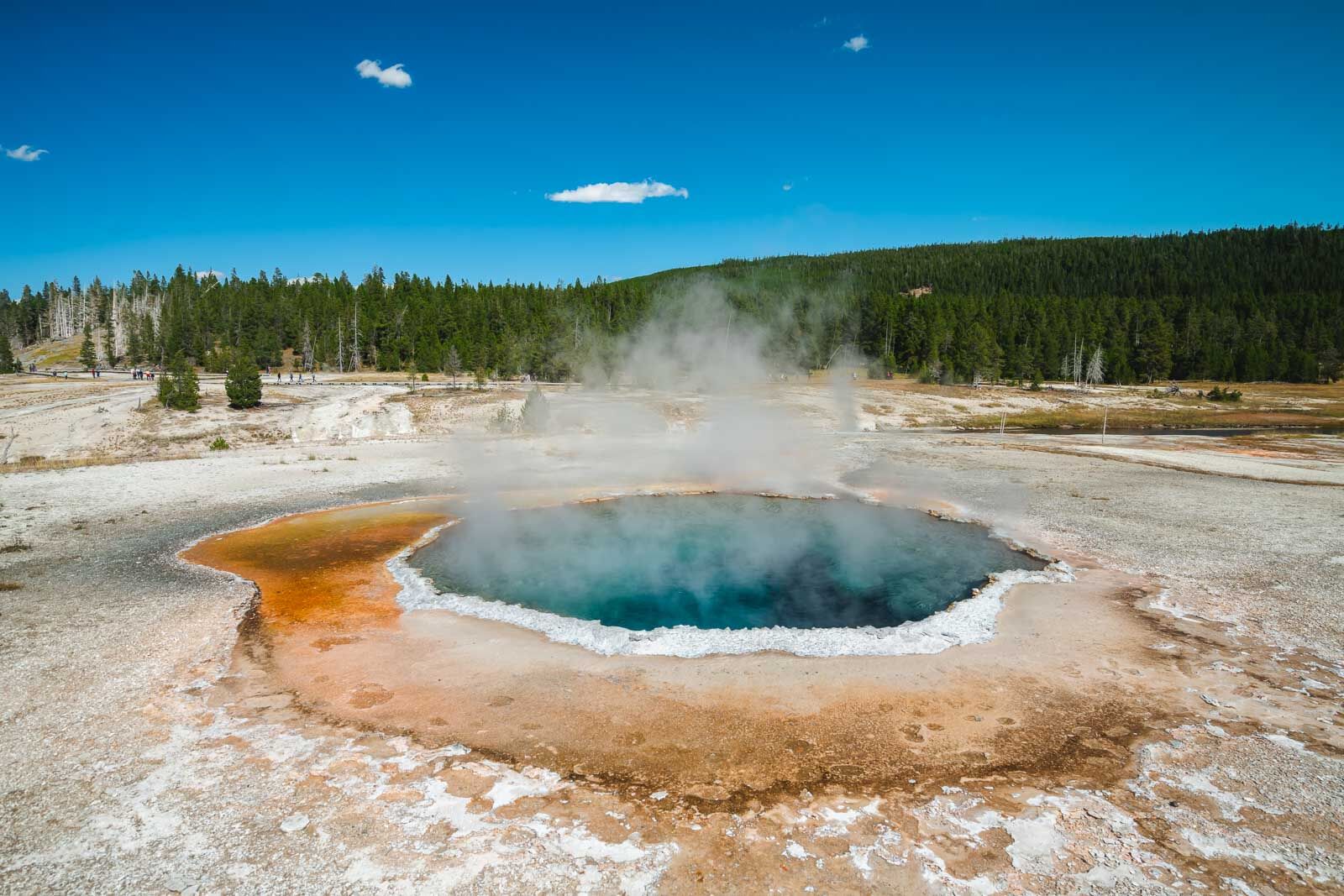
It’s an easy walk around the Upper Geyser Basin, and most of the basin is accessible for wheelchairs and scooters. Another great way to cover the ground quickly is to rent a bicycle. You can rent bikes at Old Faithful Snowlodge for $10 for an hour, $30 for four hours, or $40 for 8-hours.
We took one path along the boardwalk out and the cycling path back. You can spend a short time just visiting a couple of sections, or you can spend an entire day exploring it all. Here are a few things not to miss.
Castle Geyser
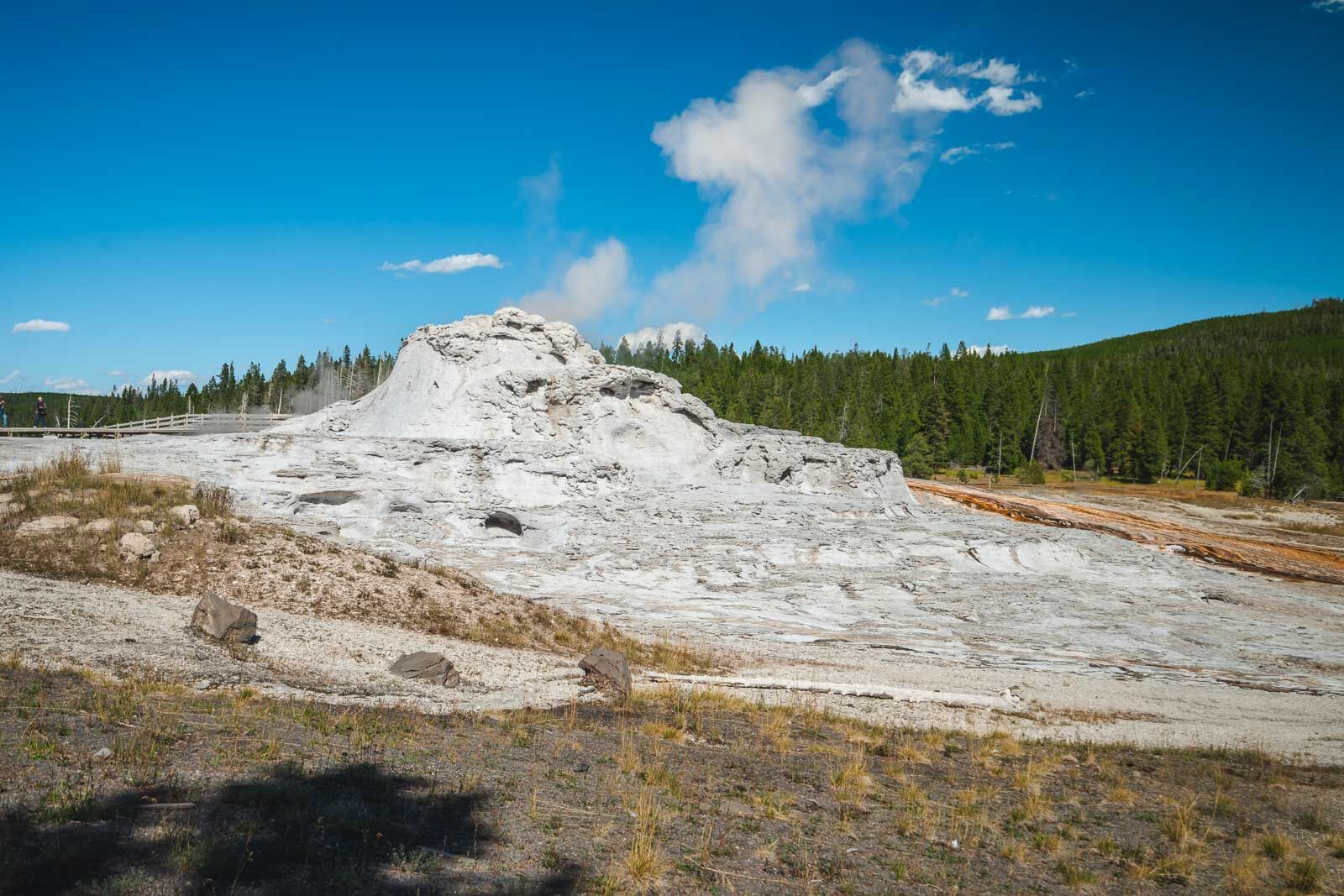
Castle Geyser is a lovely geyser along the trails at Upper Geyser Basin. It can be reached by taking the paved walkway from the Old Faithful Inn. This pure white formation resembles a castle, thus giving it its name. In the 1800s, when it got its name, it truly did look like a medieval castle, but like all-natural structures over time, its appearance has changed. But it is no less impressive.
Grand Geyser
When it’s not erupting, Grand Geyser doesn’t look like much more than a hole in the ground, but this is the largest predictable geyser in the world. The park rangers can predict the geyser’s eruption within two hours. If you are lucky, you may be nearby when it goes off. You can find it along the wooden boardwalk, either walking directly from Geyser Hill or crossing the river from Castle Geyser.
Chromatic Pool
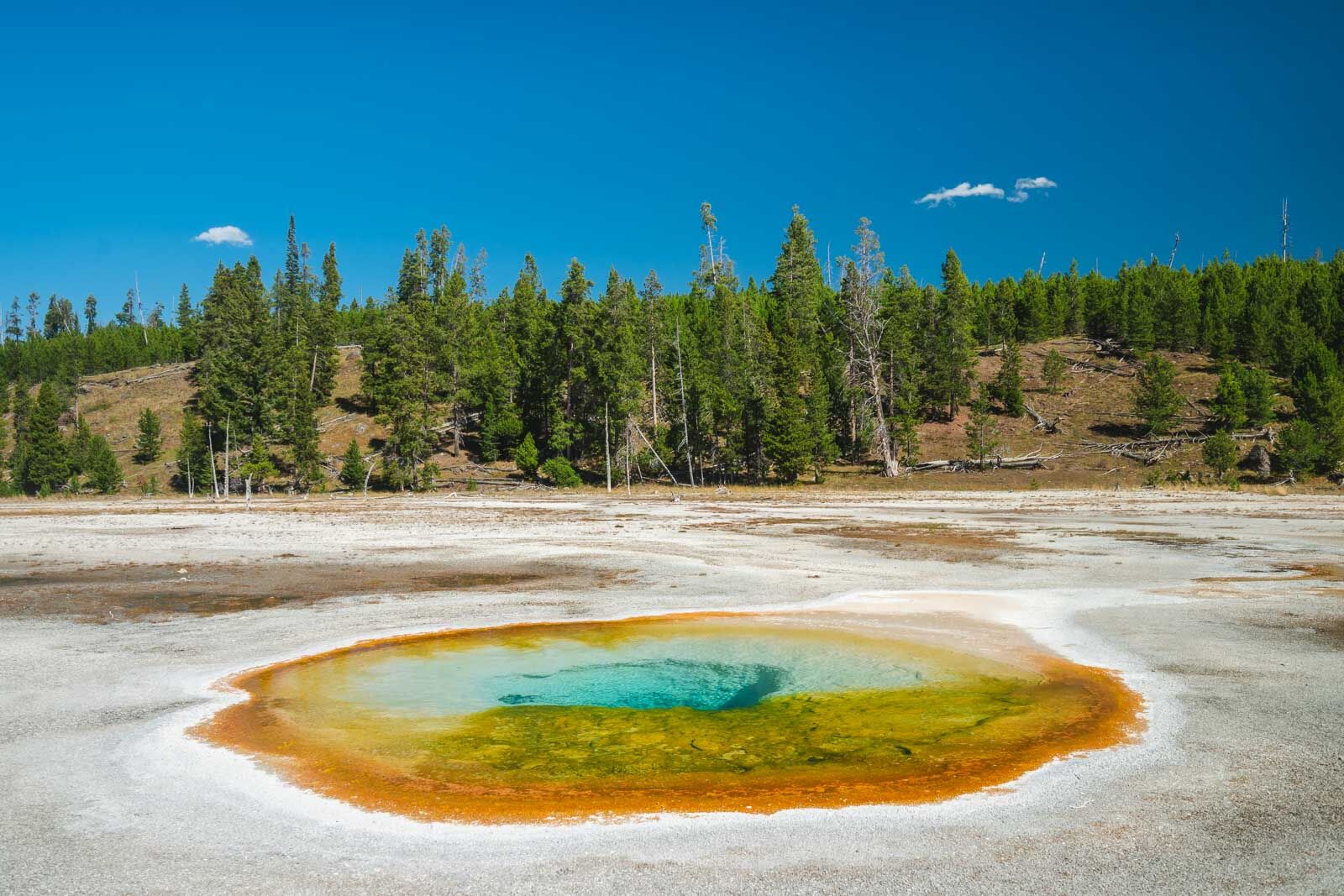
As you continue along to Morning Glory, there are some colorful pools as well. Each is unique, with vivid turquoise waters, deep rust and yellow minerals, and plenty of steam and bubbling. Beauty Pool and Chromatic Pool are beside each other and are lovely. This walk to Morning Glory says it is about 30 minutes, but I would give it about an hour if you really want to stop to take in the views.
Giant Geyser
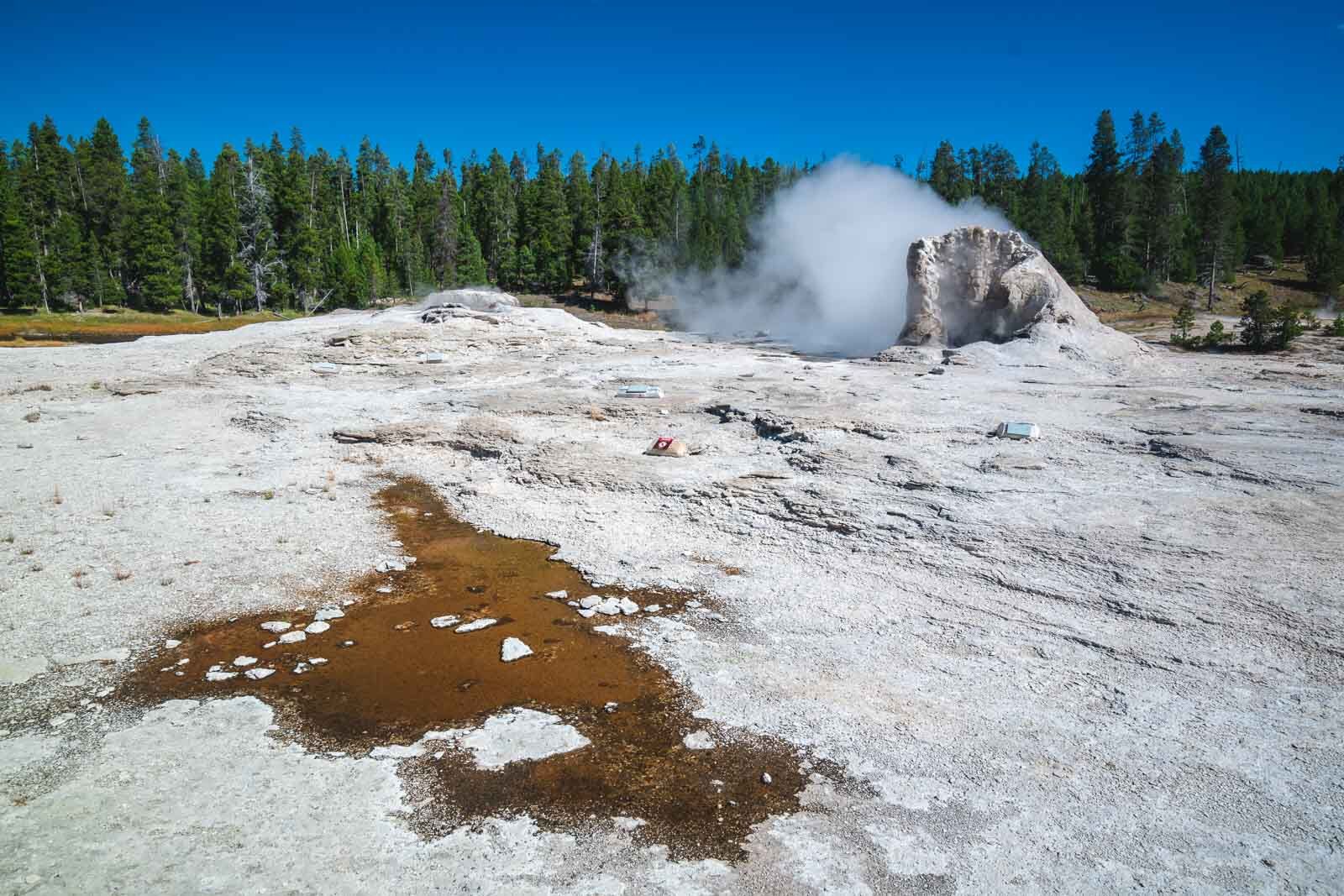
As you continue on toward Morning Glory, you’ll find the riverside geysers of Giant Geyser is a cone-type geyser that looks like the tip of a volcano. Steam seeps from its cone, but its last eruption was in 2019. Even though it hasn’t erupted in a while, it is fantastic to see. Grotto Geyser is nearby and is an incredible formation as well.
7. Morning Glory Pool
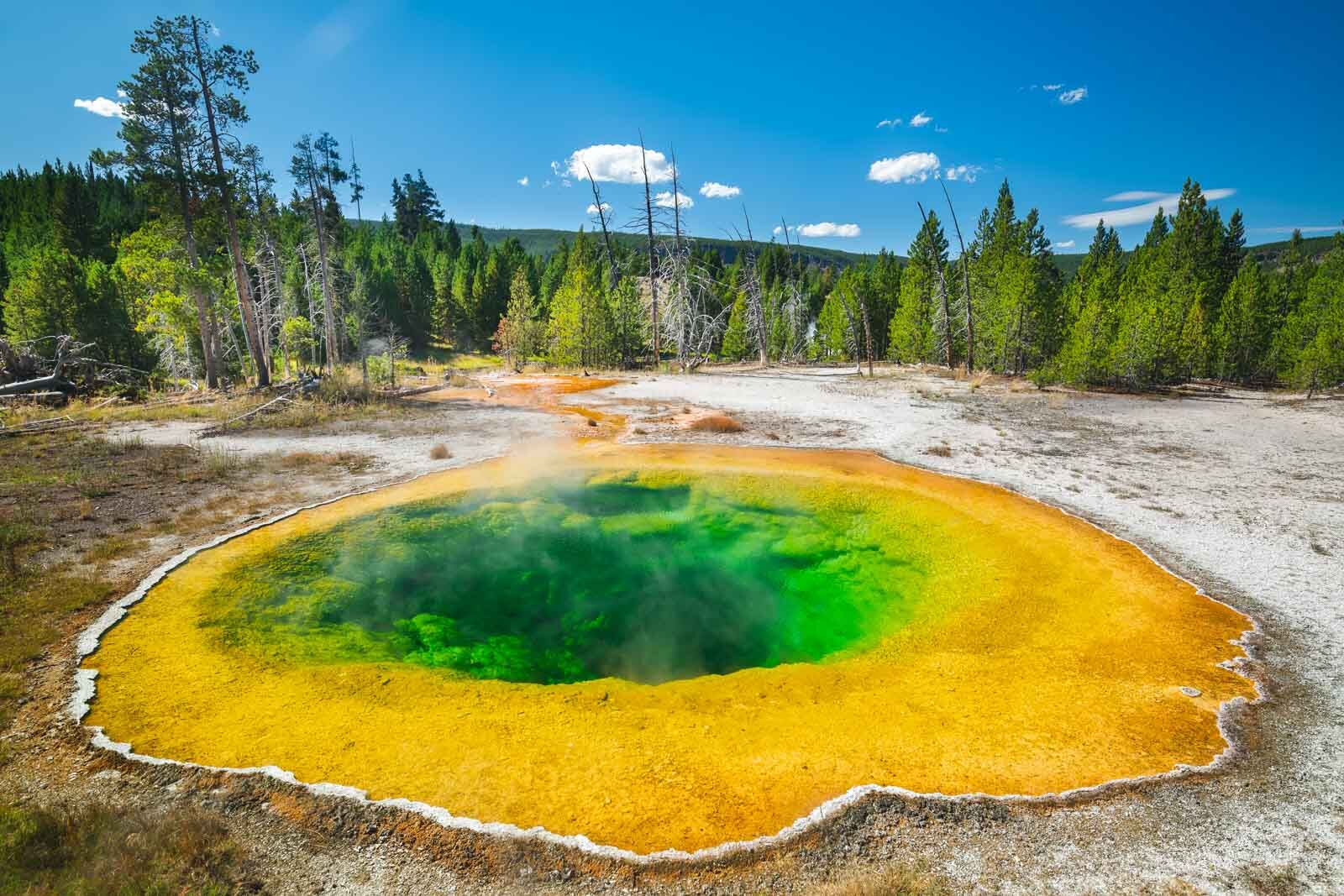
Without a doubt, the star attraction on this trail is the Morning Glory Pool. It is small, but the color is vivid, reminding us of a mini Grand Prismatic. Sadly, Morning Glory has been vandalized over the years, with people throwing coins and garbage into the pool, and clogging the bottom. The color faded as water circulation was limited, causing it to cool and killing the micro-organisms that thrive in the hot waters.
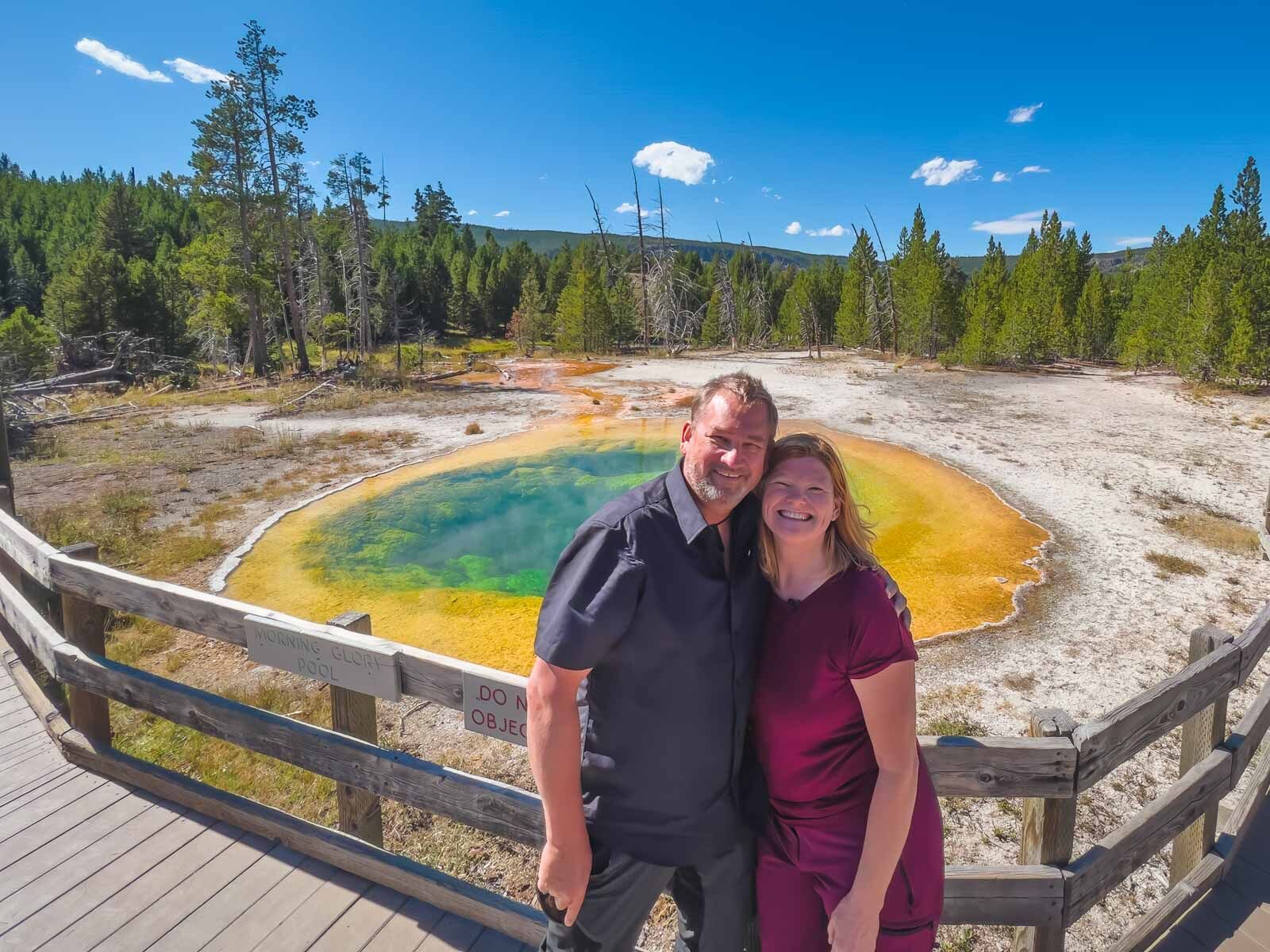
The microorganisms create the vivid colors of all the hot springs in Yellowstone. It’s hard to imagine that the deep yellows and oranges are billions of tiny microorganisms huddled together, thriving in the heat. And it’s incredible to think that Morning Glory had been even more vivid at one time because it is still bold and rich with color.
I am so glad we took the walk out to Morning Glory Pool; seriously, no trip to Yellowstone would be complete without seeing this beautiful geyser.
After walking around Upper Geyser Basin, you can visit the Visitor Center to learn more about Yellowstone National Park from a park ranger and its geothermal features and Hot Springs. Or you can pop into one of the hotels for a bite to eat.
Hot tip: Take water with you and wear sunscreen or a hat. we didn’t do this and we were parched by the time we finished our walk.
8. Old Faithful Inn
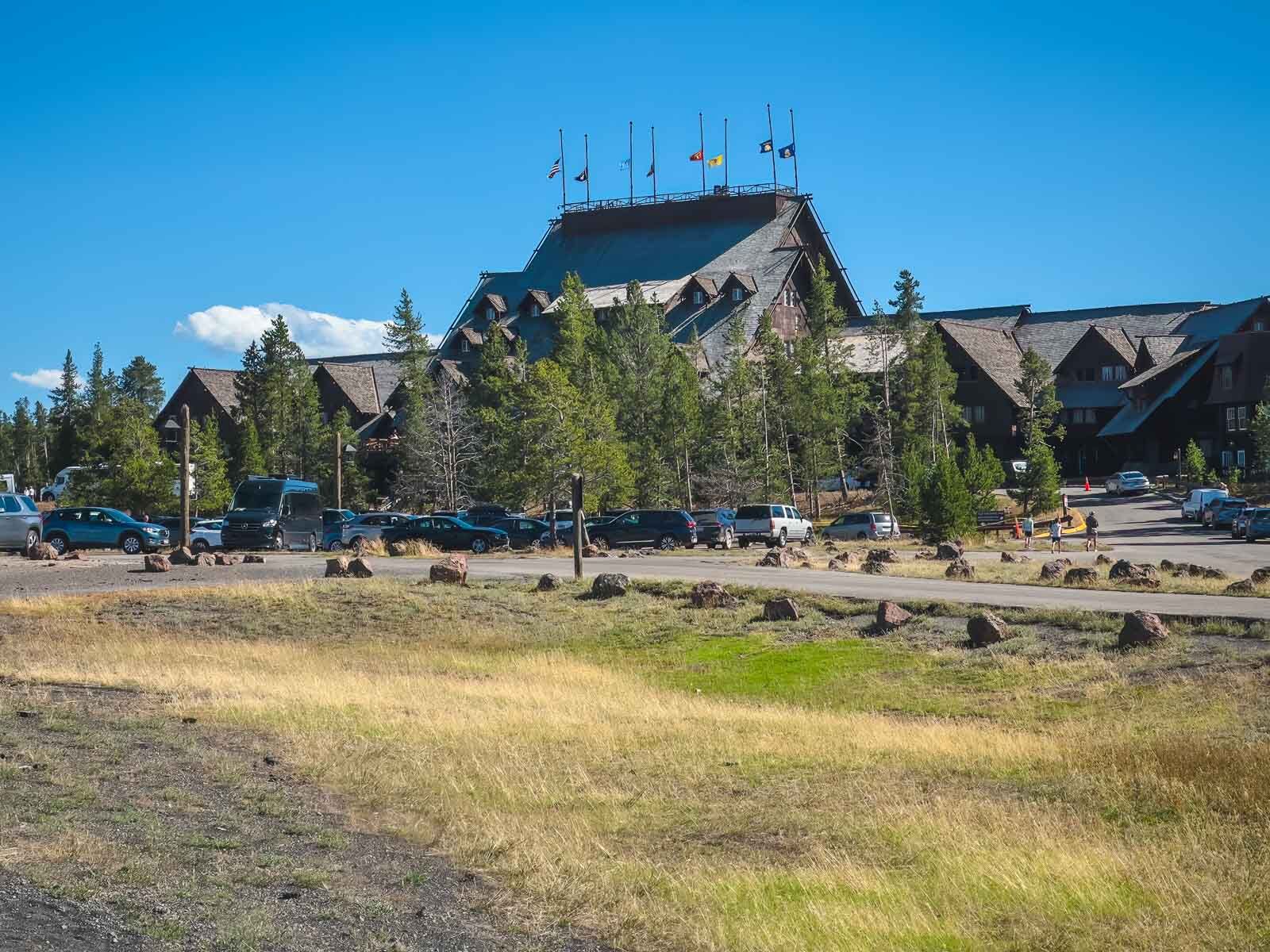
If you are looking for a more upscale place to stay in Yellowstone, the Old Faithful Inn is a national historic landmark and one of the most popular places to stay. It was built in 1904 and is considered the largest log structure in the world.
Even though it is old and historic, the rooms have been updated with a contemporary feel. But as a park ranger told us while visiting the Shoshone National Forest it is still rustic. There is no air conditioning or Internet. When booking here, you are paying for convenience, location, and staying in a slice of history. Plus, you’ll want to make reservations far in advance (up to a year). This place fills up quickly. Read more: Where to Stay in Yellowstone National Park – Guide to the Best Hotels
9. Hayden Valley
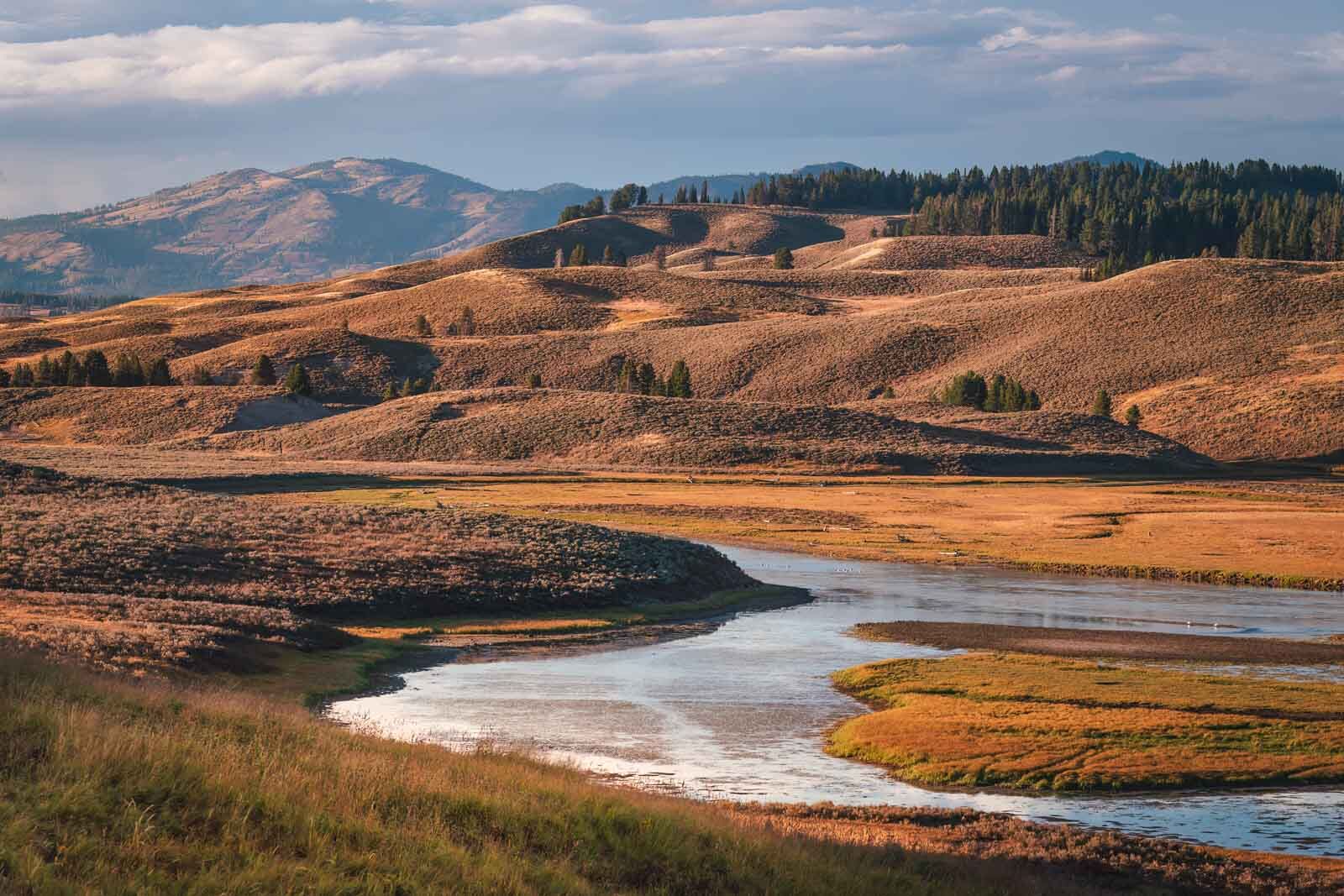
Hayden Valley is one of the best places in Yellowstone for wildlife viewing. It is here you’ll see bison herds and elk grazing against the backdrop of rolling hills and meandering rivers. If you are lucky, you may also spot a grizzly bear as well.
This vast, lush valley is sandwiched between Lake Yellowstone and the Grand Canyon of the Yellowstone. The Yellowstone River snakes through the valley, where you can pull over to see wildlife drinking, bison basking in the sun, or ducks floating in the water.
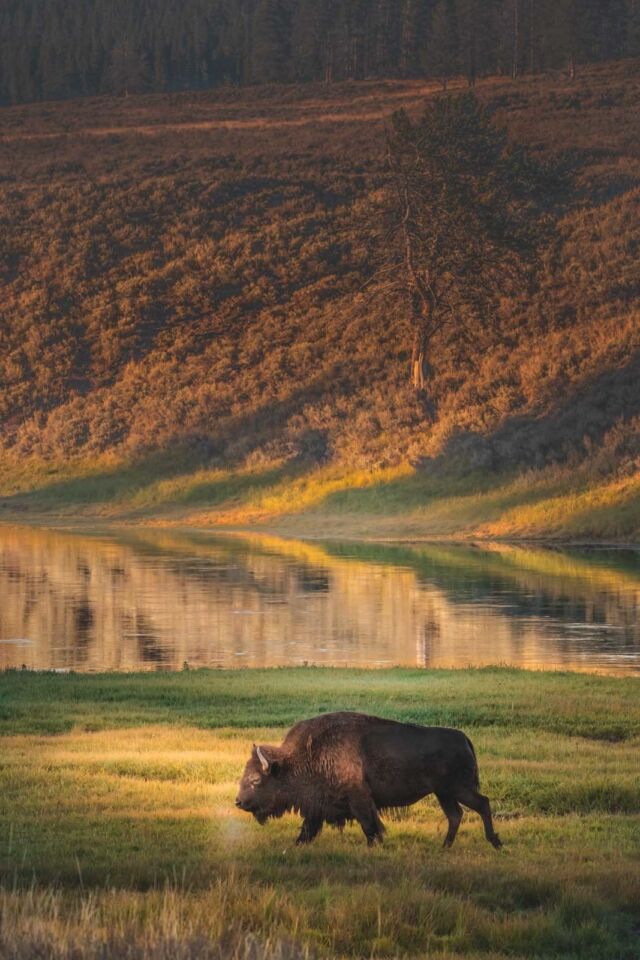
The best time to visit Hayden Valley is early morning or late afternoon when the sun is low and the shadows are deep. At this time, you’ll see many Yellowstone National Park Tours stopped along the side of the road with their scopes looking for wolves and bears.
We toured Hayden Valley as the sun was setting and it was beautiful and the wildlife was active. It’s easy to spot wildlife all you have to do is to look for the cluster of cars stopped at the pull-offs. We rolled down our windows to ask what people were looking at to see if we should stop.
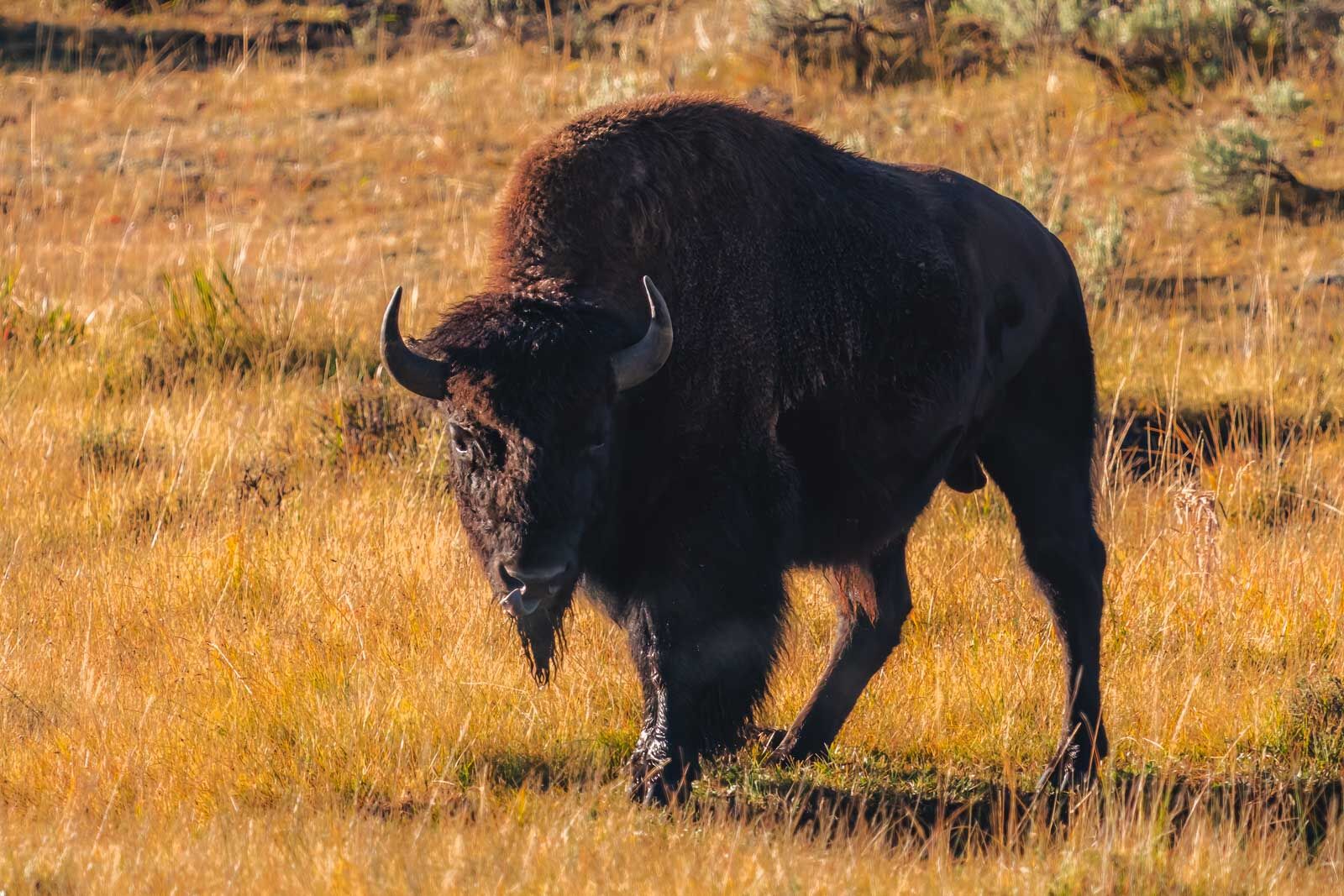
Bring your binoculars and witness the drama of nature unfold – from golden eagles, ospreys and bald eagles soaring in the sky to the occasional sighting of wolves and bears in their natural habitat.
We suggest packing binoculars to view the wildlife. A lot of it was even too far for our long cameras to see. If you want to invest in scope, it is also a great idea. Or you can take a wildlife tour.
Where is Hayden Valley: Hayden Valley is located in central Yellowstone and is just a short drive from our Canyon Village accommodation.
Things to do in Yellowstone National Park in Two Days
Can you believe we did all that in one day? By staying over at Canyon Village in the heart of Yellowstone, we were able to stay out until after sunset and get up the next morning for an early tour. If you can, we do suggest staying at least one night inside Yellowstone National Park.
10. Wake up to Wildlife Tour
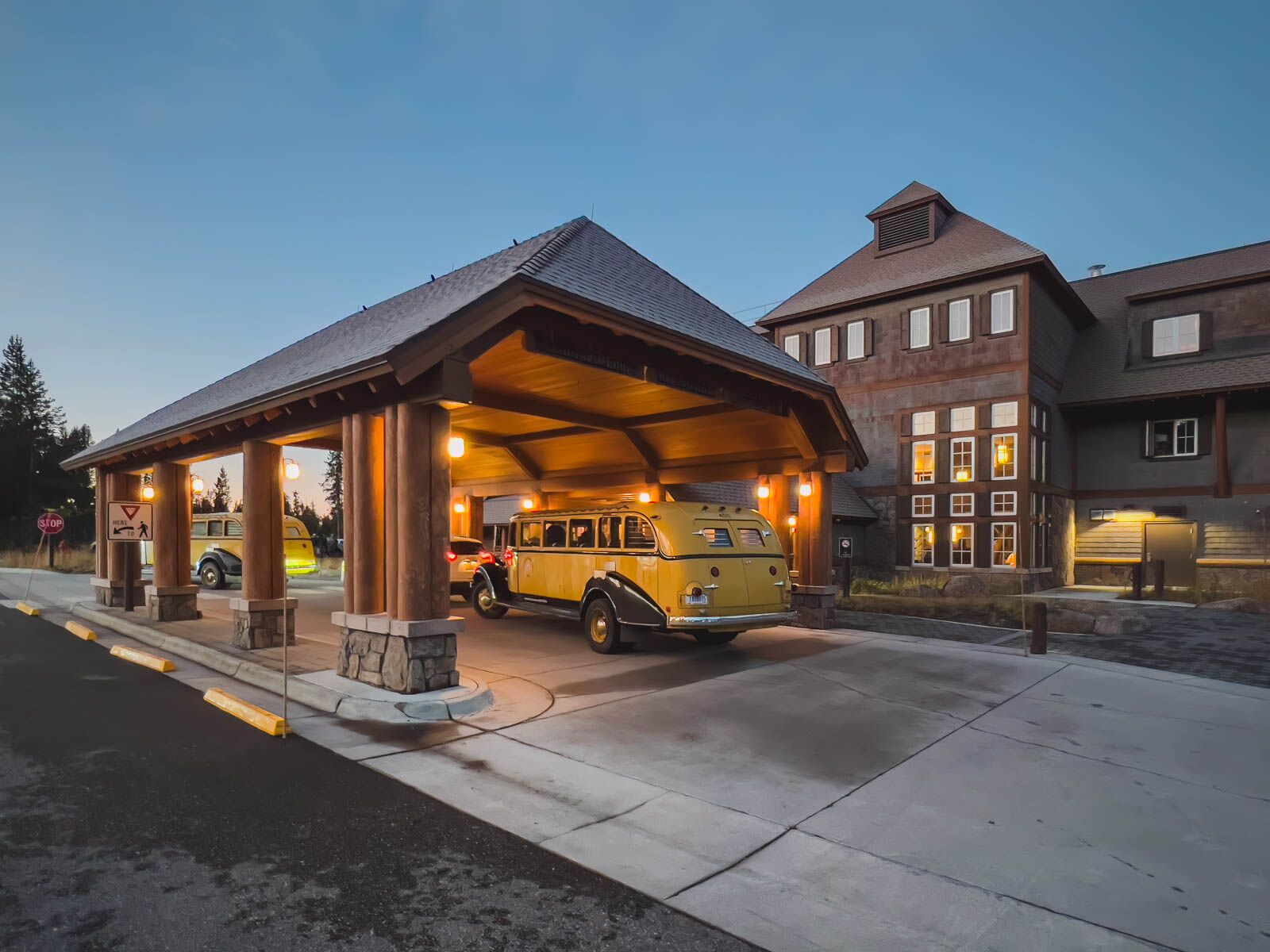
One of the most popular Yellowstone National Park Tours is the Wake up to Wildlife Tour. (They also do a wildlife sunset tour) This is an excellent guided tour through the most popular wildlife viewing areas in Yellowstone. Professional guides have years of experience finding wildlife and can spot grizzly bears and gray wolves far better than us amateurs.
They bring their scopes for up-close views with them, and when wildlife is spotted, passengers can get out of the bus to take a closer look. In the summer, the top pops up, and people can stand to see from the bus when it stops.
11. Visit Lamar Valley
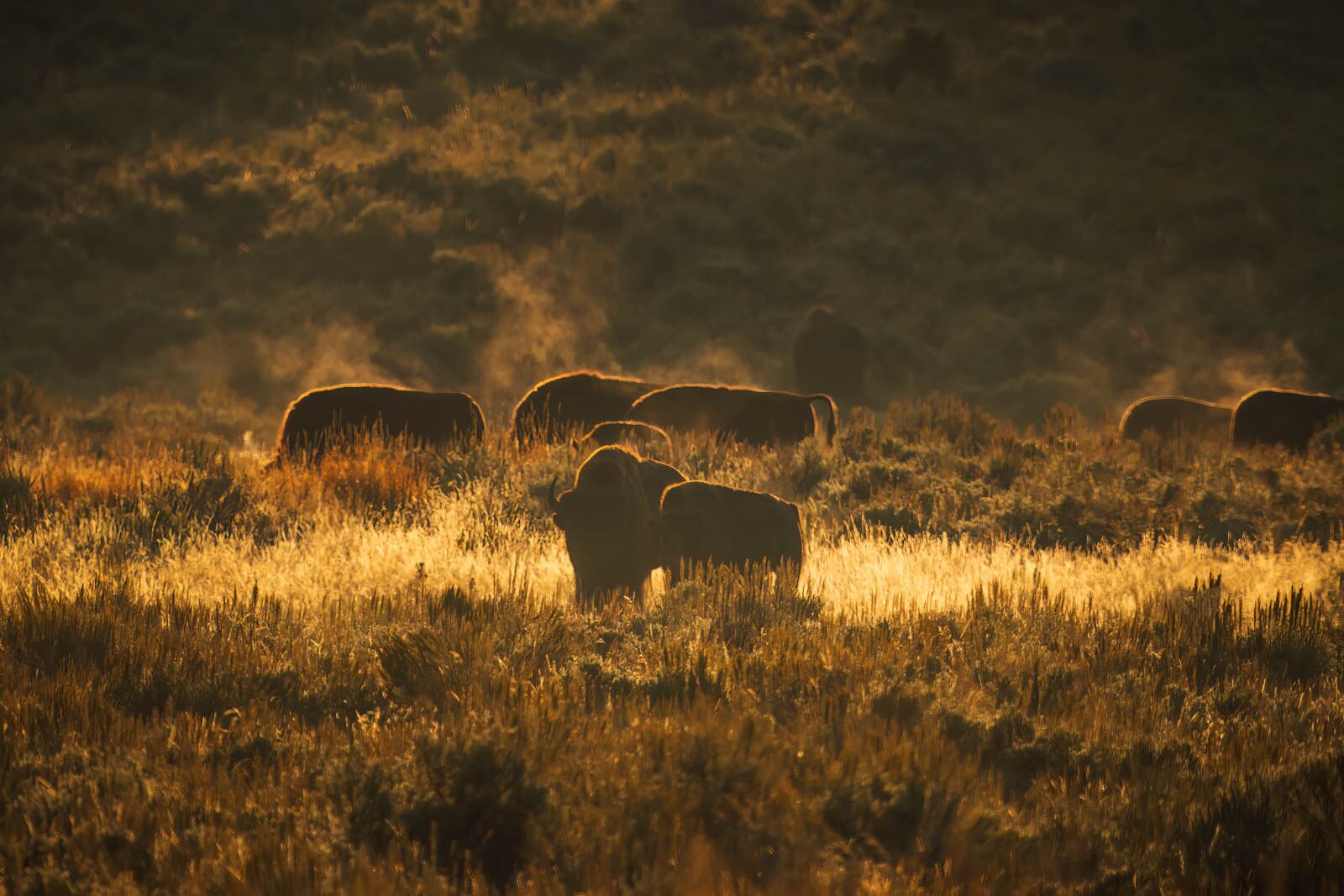
The Yellowstone Wake up to Wildlife Tour goes through Lamar Valley, and you’ll see plenty of wildlife tour operators with their scopes out in search of wolves and grizzly bears.
Located in Northern Yellowstone, we set off to the Lamar Valley before sunrise on our second day in Yellowstone. By leaving before the sun came up, we were treated to a fantastic scene of the sun peaking up to ignite the herds of bison.
The Lamar Valley is often touted as the Serengeti of America due to its wide open spaces and big game, and it lives up to the name. Like Hayden Valley, Lamar Valley is the premier place for wildlife viewing in Yellowstone National Park.
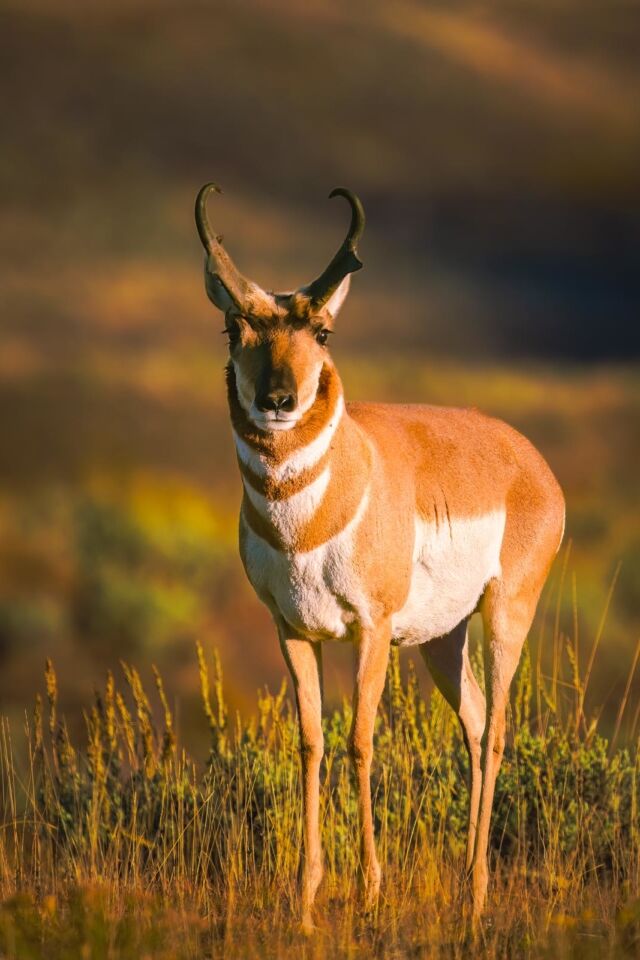
Early mornings are when wildlife is the most active, and it is the time when you will encounter fewer vehicles. The Lamar River snakes through the Lamar Valley, making it a good stop for wildlife watching as herds gather by the water.
This is where we had our best bison encounters in Yellowstone. It was along this road that we had the quintessential Yellowstone National Park experience with bison surrounding our car, leaving us stopped on the road. I swear the bison get a kick out of making tourists stop. It’s like one big Wild West standoff.
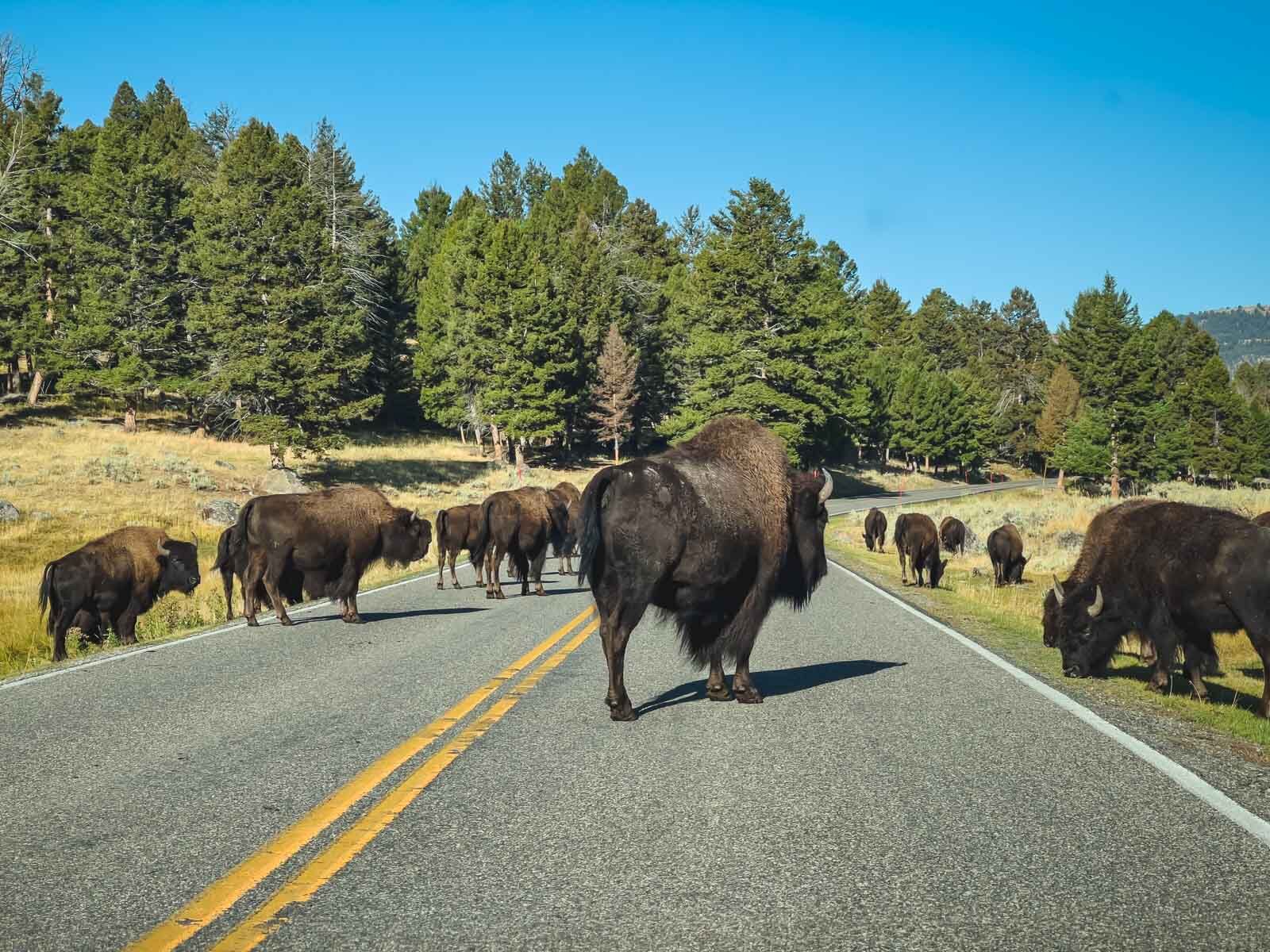
While in the Lamar Valley, if you are lucky, you may spy on the Junction Butte and Lamar Canyon wolf packs. The Junction Butte Wolf Pack den is within view of Slough Creek Road. This is a great road to drive along as it isn’t paved and sees fewer vehicles.
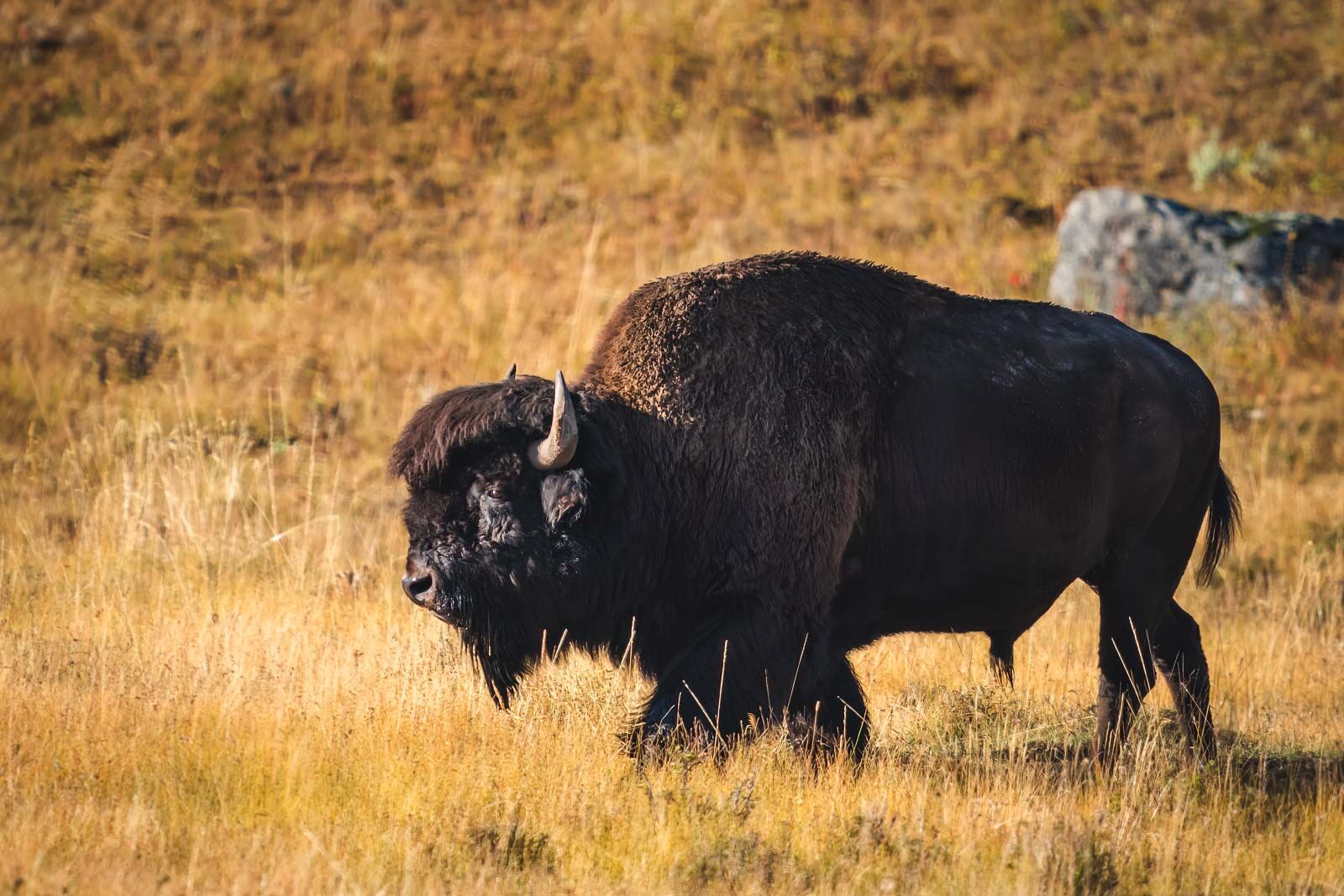
With its proximity to the Mammoth area, you would think that you should visit the Lamar Valley at the same time as Mammoth hot springs, but we did each on a different morning and found that it worked perfectly. You want to be in the Lamar Valley as early as possible and spend as long as possible. Wildlife moves quickly, and if you do one pass, you may miss it so it is worth driving back and forth along the road.
12. Grand Canyon of the Yellowstone
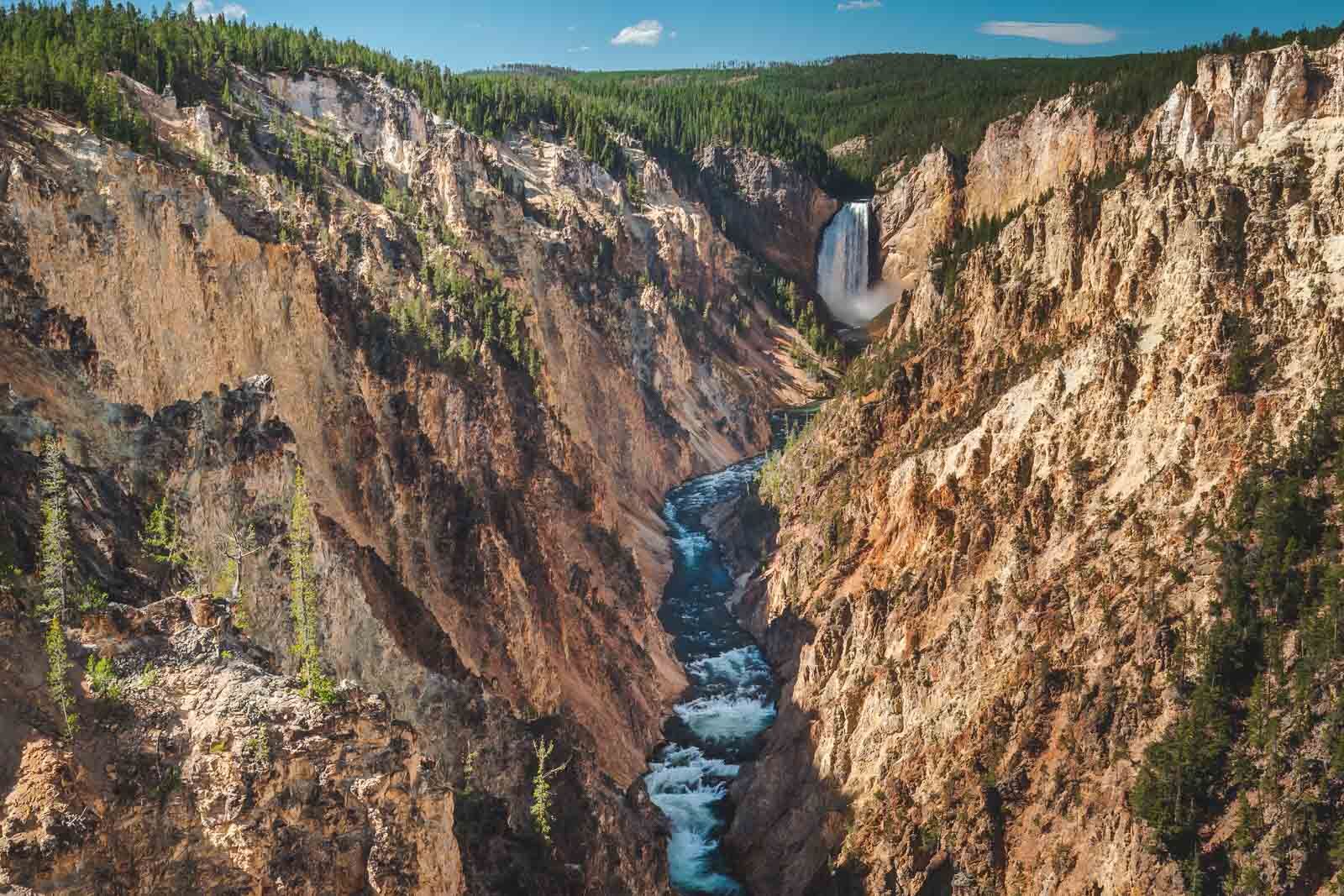
The Yellowstone Canyon, aka Grand Canyon of the Yellowstone is one of the best places to visit in Yellowstone for hiking and taking in gorgeous lookout views of the Yellowstone waterfalls. This beautiful Yellowstone canyon was created 630 thousand ago during a volcanic eruption.
For the next couple of hundred thousand years, lava flowed through the canyon, and about 150 thousand years ago, it was created. There are several places to experience the Grand Canyon of the Yellowstone, each with its unique appeal.
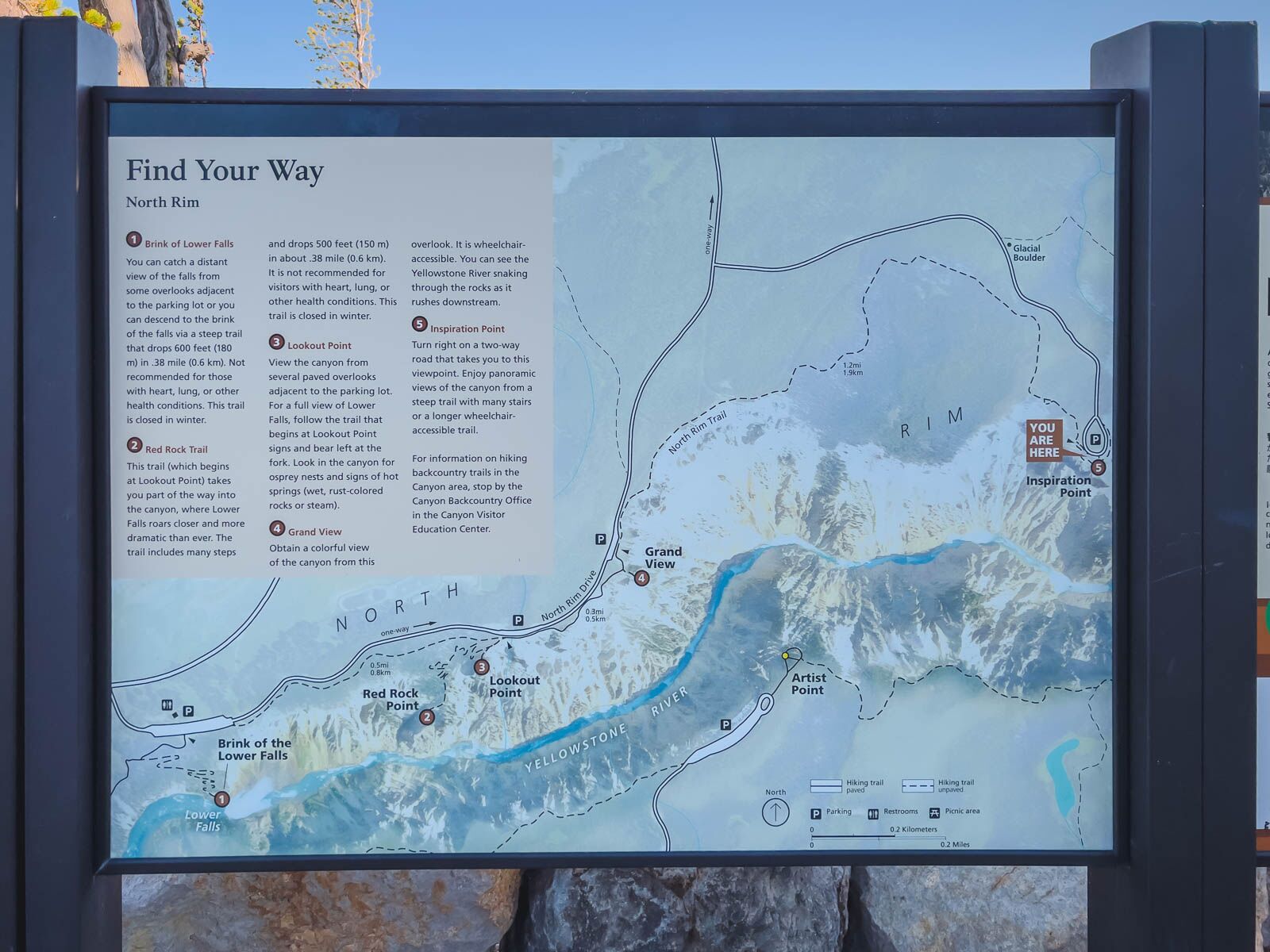
There are two sections to drive to see the Grand Canyon of the Yellowstone. The North Rime Drive is a one-way road that takes you to the Brink of the Lower Falls, Inspiration Point, and the hiking trails. South Rim Drive takes you to Upper Falls Viewpoint and Artists Point.
13. Brink of the Lower Falls
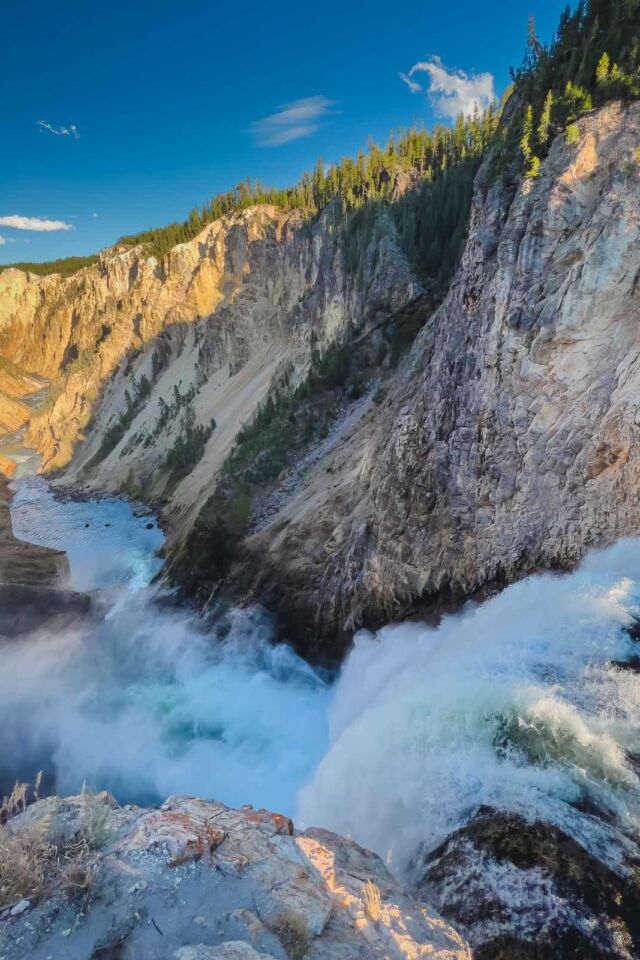
Brink of the Lower Falls is a steep downhill hike from the North Rim Drive parking lot of The Grand Canyon of the Yellowstone. It’s worth the hike to see an incredible lookout point.
Nobody seems to tell you that it is a straight downhill hike. While it is only half a mile long it is all downhill using switchbacks. We saw many people huffing and puffing their way back up, so just be prepared, as what goes down, but go back up.
When you get to the bottom, a viewing platform is located directly beside the top of the lower falls. The falls plunge into the Yellowstone River with great power, with deep canyon views on either side.
14. Inspiration Point
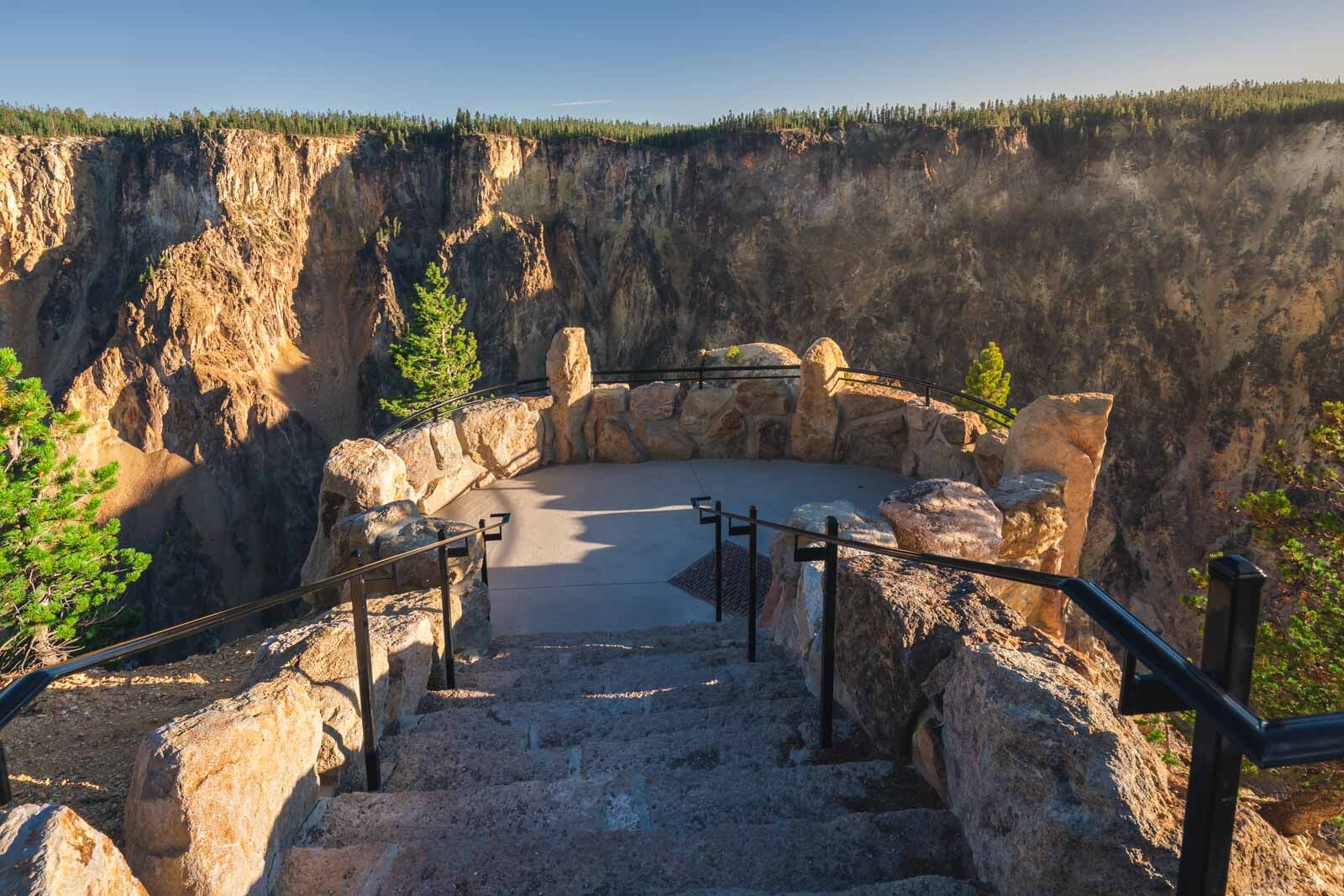
Inspiration Point is an easy hike from the parking lot for beautiful views of the Grand Canyon of Yellowstone. You cannot see the falls from Inspiration Point, but the views are still breathtaking.
If you are up for a challenging hike, you can reach Inspiration Point from the North Rim Trail hike. It takes about 2 1/2 hours, and you’ll see Yellowstone Falls, Crystal Falls, and Inspiration Point on this hike.
15. Artist Point
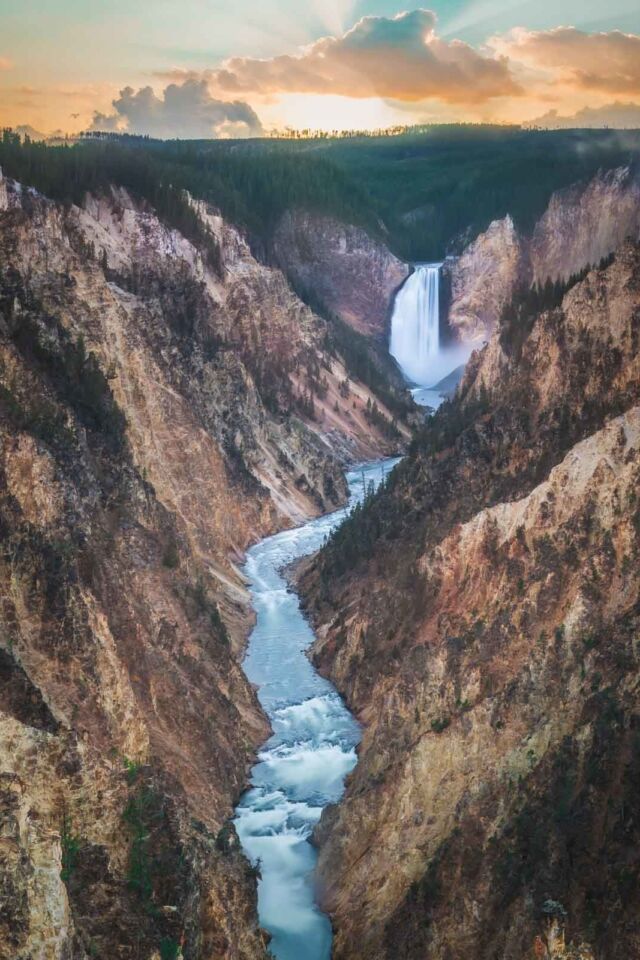
One of the top things to do in Yellowstone National Park at sunset is to make your way to Artist Point located on the south rim. It is the best view of the Grand Canyon of the Yellowstone and the 308-foot-high Lower Falls.
There are two levels of viewing platforms. The higher one is the best, with views of the Grand Canyon on either side.
The canyon is a thousand feet deep, with the mighty Yellowstone River snaking through its walls. Artist Point is one of the most beautiful places to visit in the National Park; the colors of the Grand Canyon were just as wonderful facing away from the falls as it is viewing the falls. It is just a short walk to Artist Point from the parking lot off South Rim Drive.
16. North Rim Trail Hike
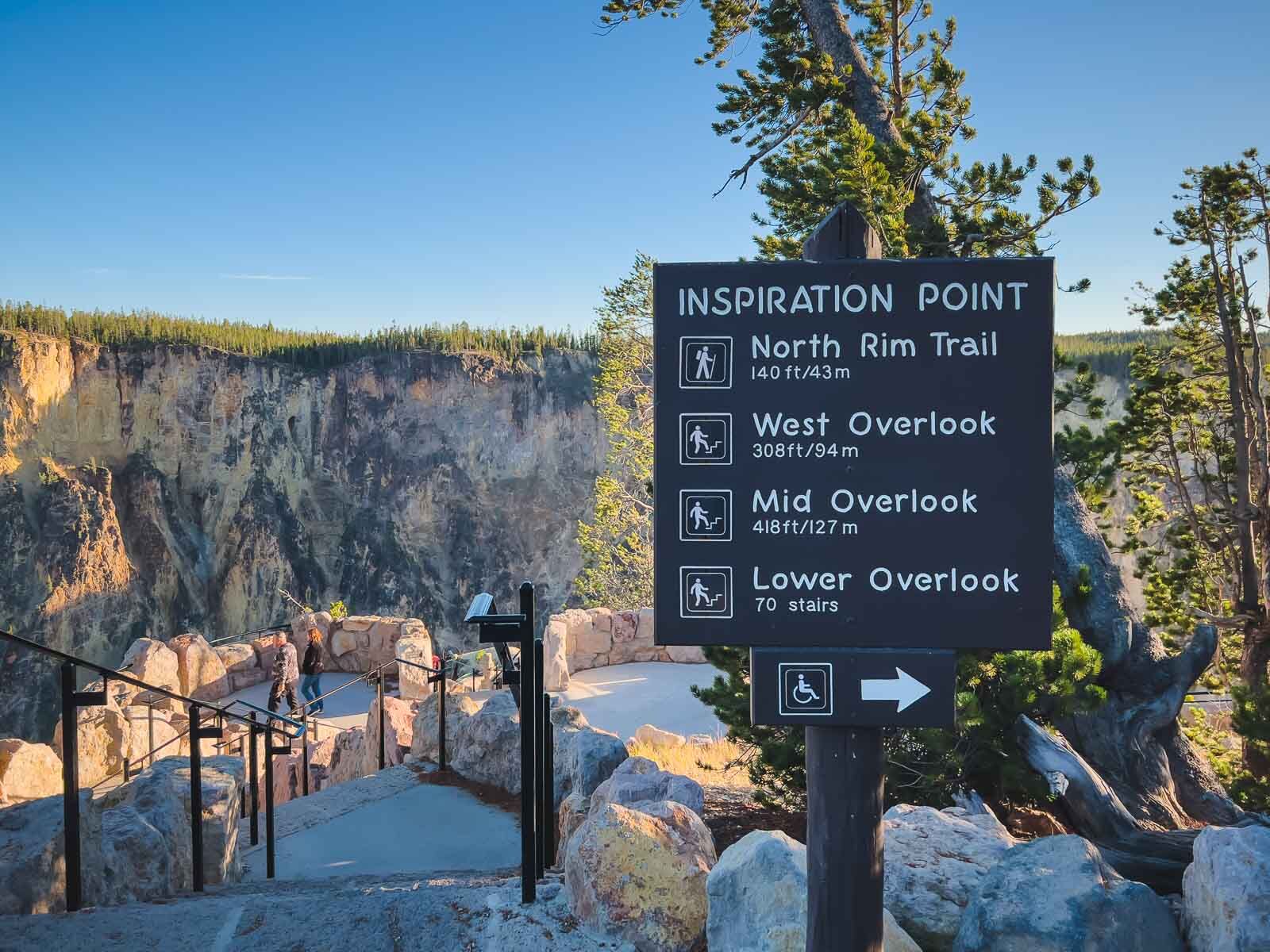
The North Rim Trail hike will give you incredible views and is pretty easy to boot. This is a 7.6-mile out-and-back trail with a 250 feet elevation gain. You can start your leisurely trek at Inspiration Point, where the trail starts.
As the name suggests, you get to walk along the north rim of what they call the Grand Canyon of the Yellowstone River to Lookout Point where you get to see the pounding Lower Falls. Continue on, and you’ll see Upper Geyser Basin Falls, Cascade Creek, and Crystal Falls, as well as Firehole River, which runs through Upper Geyser Basin. This is a great hike for families and comprises paved and unpaved sections.
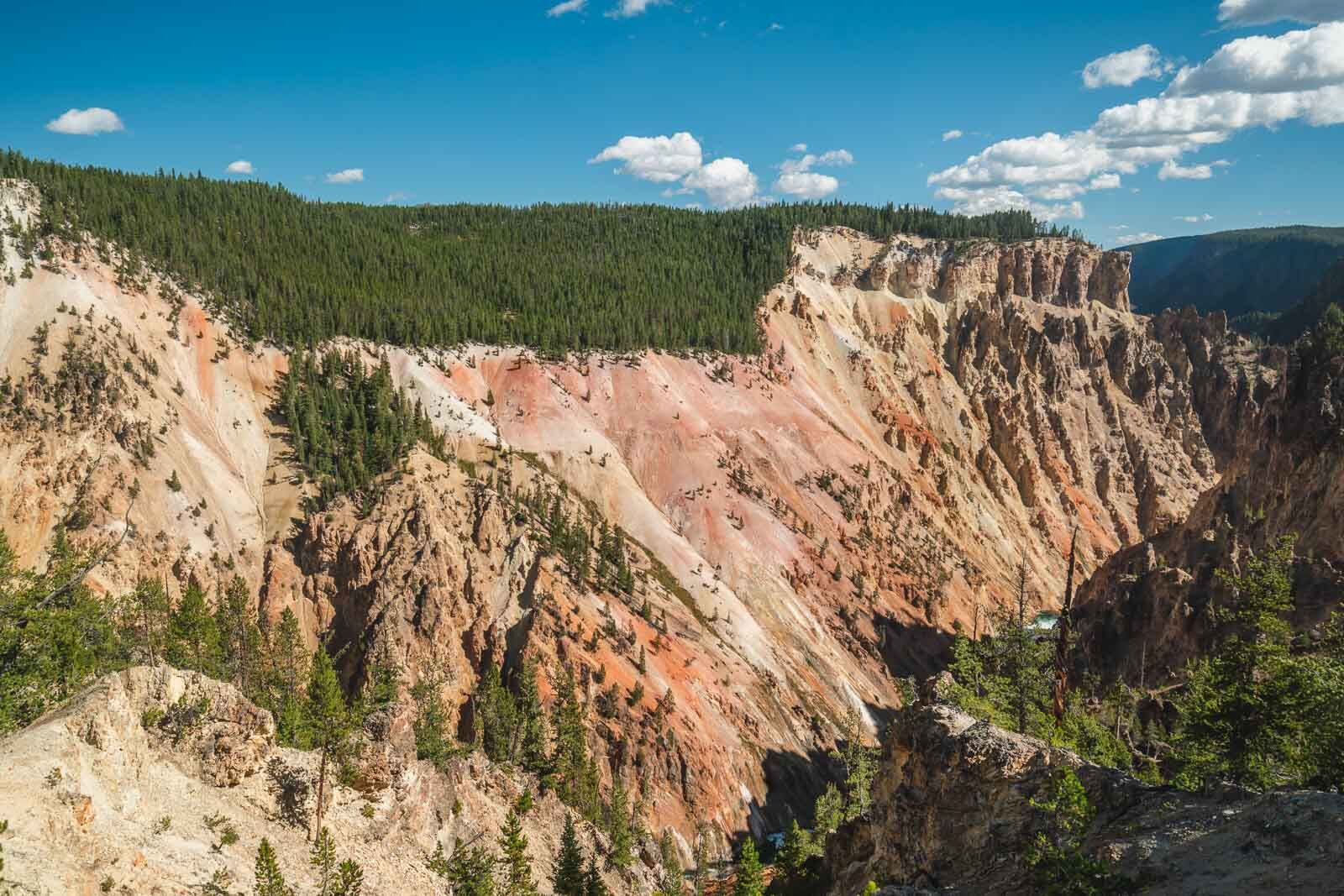
If you want to enjoy views of both the upper falls and you can hike the south rim trail following the Yellowstone River downstream. The South Rim Trail starts at Chittenden Bridge and continues to the Upper Falls Viewpoint.
It continues to Artist Point along the South Rim Trail, but as of now, Uncle Tom’s Trail is closed. It looks like Uncle Tom’s Trail will remain closed for some time, so this will just be a short out and back. Or you can easily park at the Upper Falls viewpoint parking lot and then continue on.
17. Uncle Tom’s Trail (Closed)
If Uncle Tom’s Trail reopens by the time you read this, here is some information about the trail. Uncle Tom’s Trail is a challenging stair climb offering views of the Lower Falls of the Yellowstone River. The trail is named after “Uncle Tom” Richardson, who, in the late 1800s, used to lead visitors down a series of rope ladders to a spot near the base of the Lower Falls. While the steel staircase has long replaced the rope ladders, the name remains in recognition of those early adventurous tours.
Historically, there were around 328 steps, but renovations and changes over time might have altered that number.
18. Tower Fall Overlook
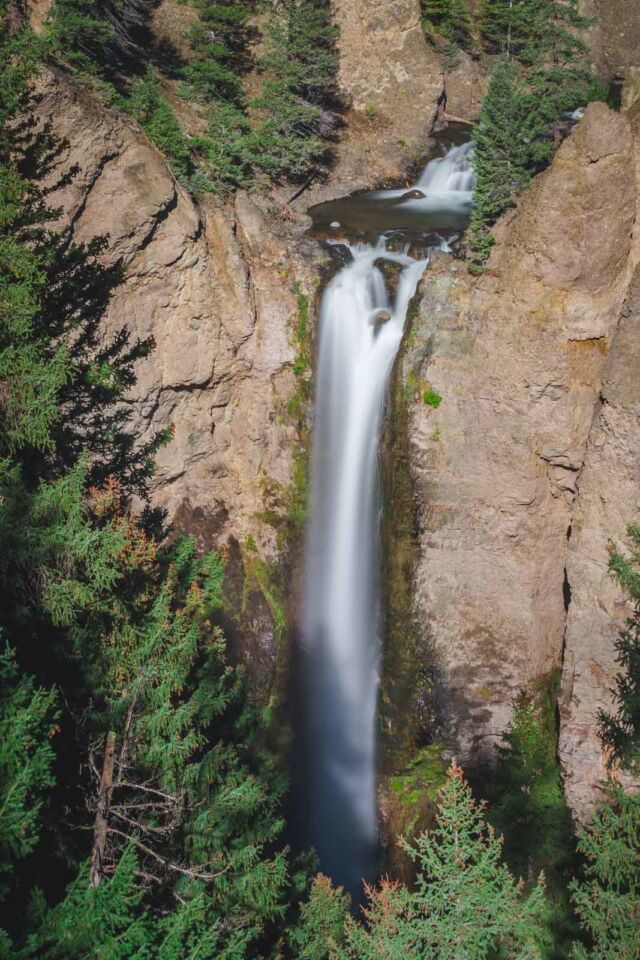
Another popular waterfall in Yellowstone is Tower Fall. Tower Fall plays an important part in history as well. It was this view that sparked the passion and excitement of Congress to create Yellowstone National Park in 1872.
Tower rocks frame the waterfall and plunge 132 feet into the valley below. It’s an easy waterfall to visit with a paved accessible trail to the Tower Fall lookout and is worth stopping as you return to West Yellowstone or Canyon Village from the Lamar Valley.
19. Yellowstone Lake
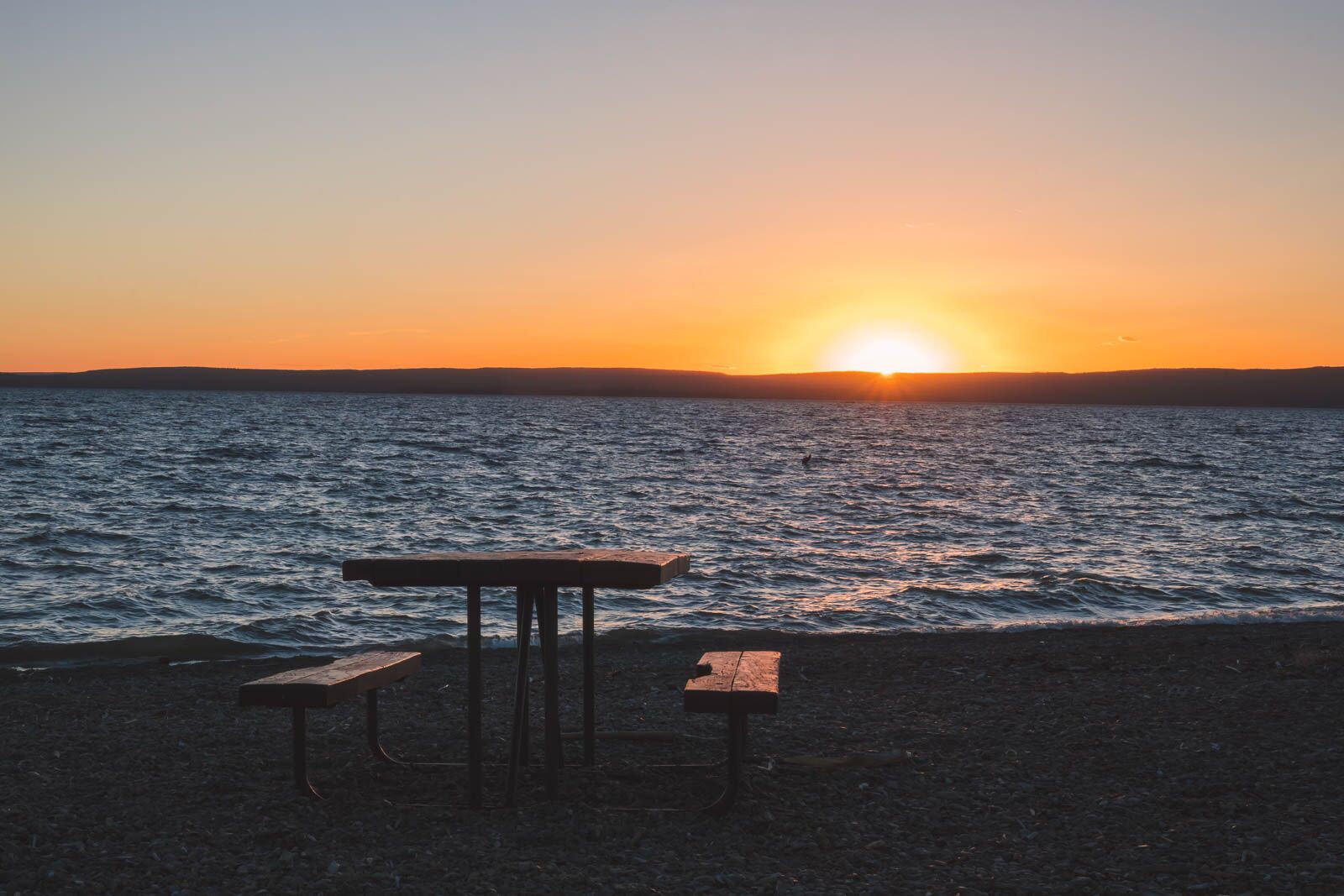
Yellowstone Lake is often overlooked in many Yellowstone National Park Itineraries, but it is not to be missed. An interesting fact that we didn’t even realize during our visit is that Yellowstone Lake is the largest high-elevation lake in North America.
We were surprised by the elevation of Yellowstone National Park. Yellowstone sits between 7,000 and 8,500 feet (2133 – 2438 meters) above sea level. Every time we stopped at a viewpoint, we said, “Are we really that high?”
20. Lake Butte Overlook
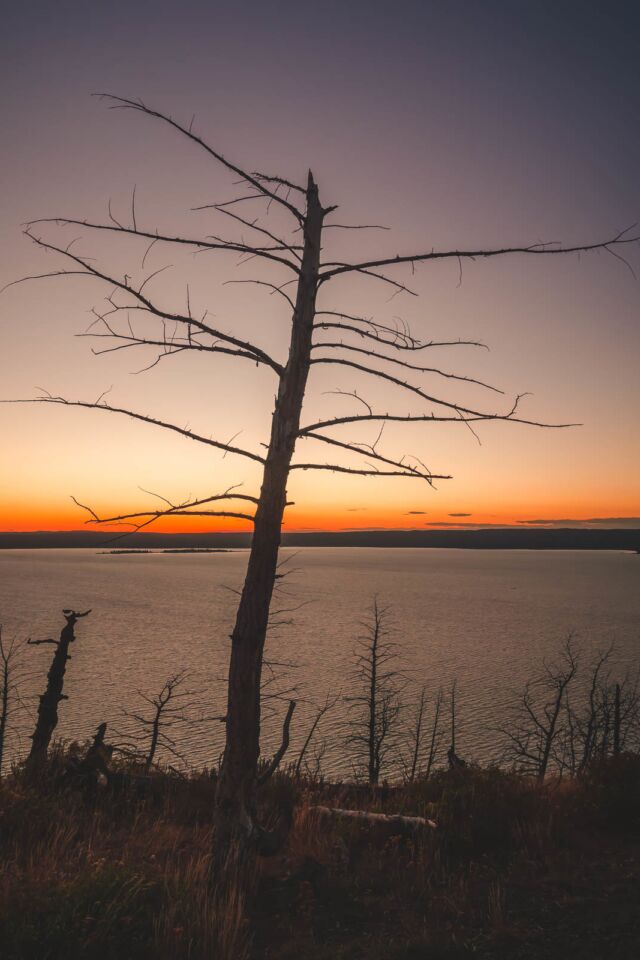
Lake Butte Overlook is a high viewpoint overlooking Yellowstone Lake. The small yellow Yellowstone Park Tour bus was leaving just as we arrived for blue hour, so we knew we made the right choice to see the sunset here from Lake Butte.
21. Roaring Mountain
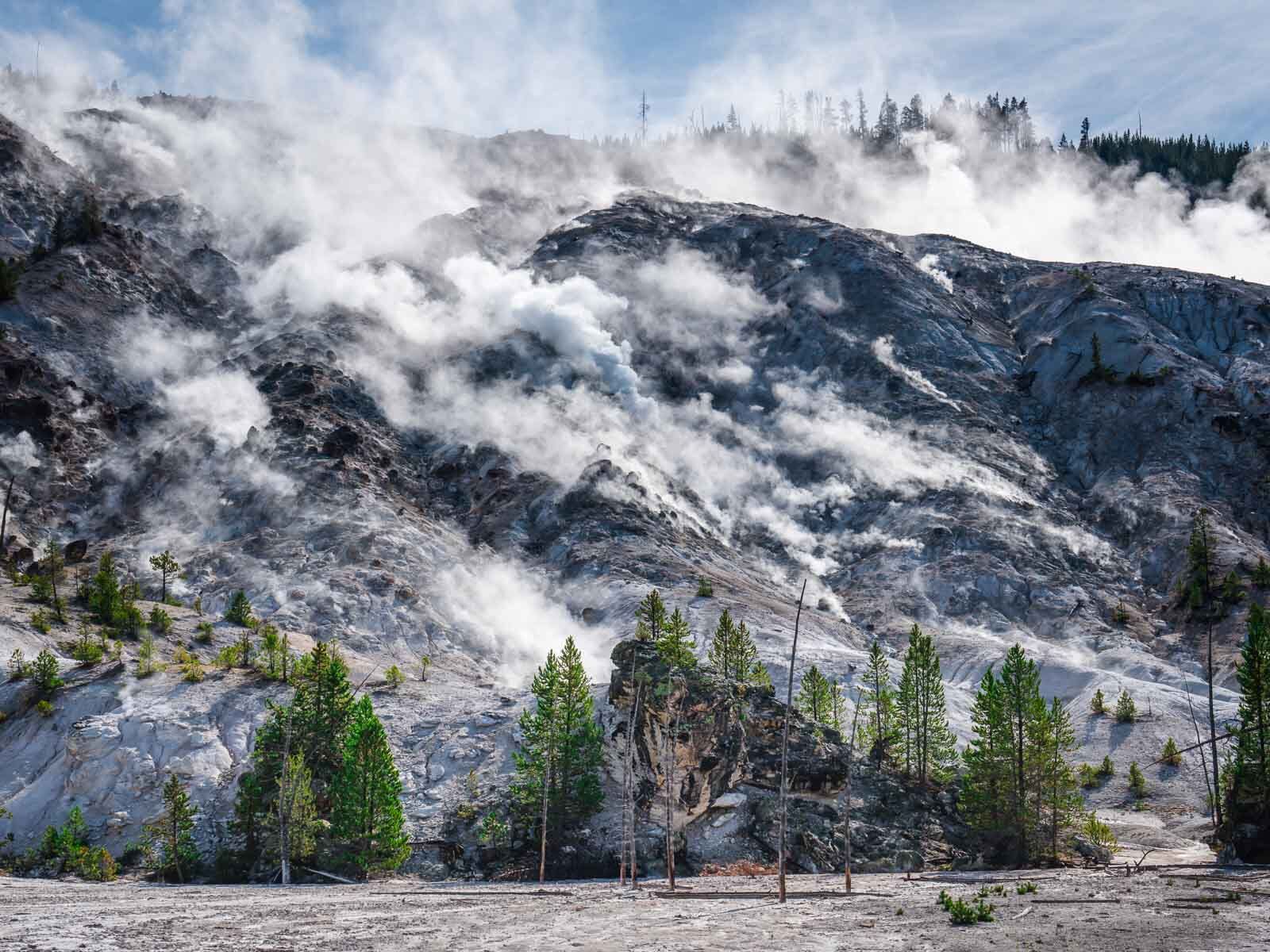
Roaring Mountain was a stop on the Grand Loop trail just north of Norris Geyser Basin that we didn’t even know existed until we saw it. And wow, this was amazing.
The mountain is alive with steam vents known as Fumaroles spewing from its slopes. Roaring Mountain hisses as the gas escapes from the mountain. In the 1800s, the mountain was much louder, giving it the name roaring mountain, but you can still hear it today, just not as intense.
22. Norris Geyser Basin
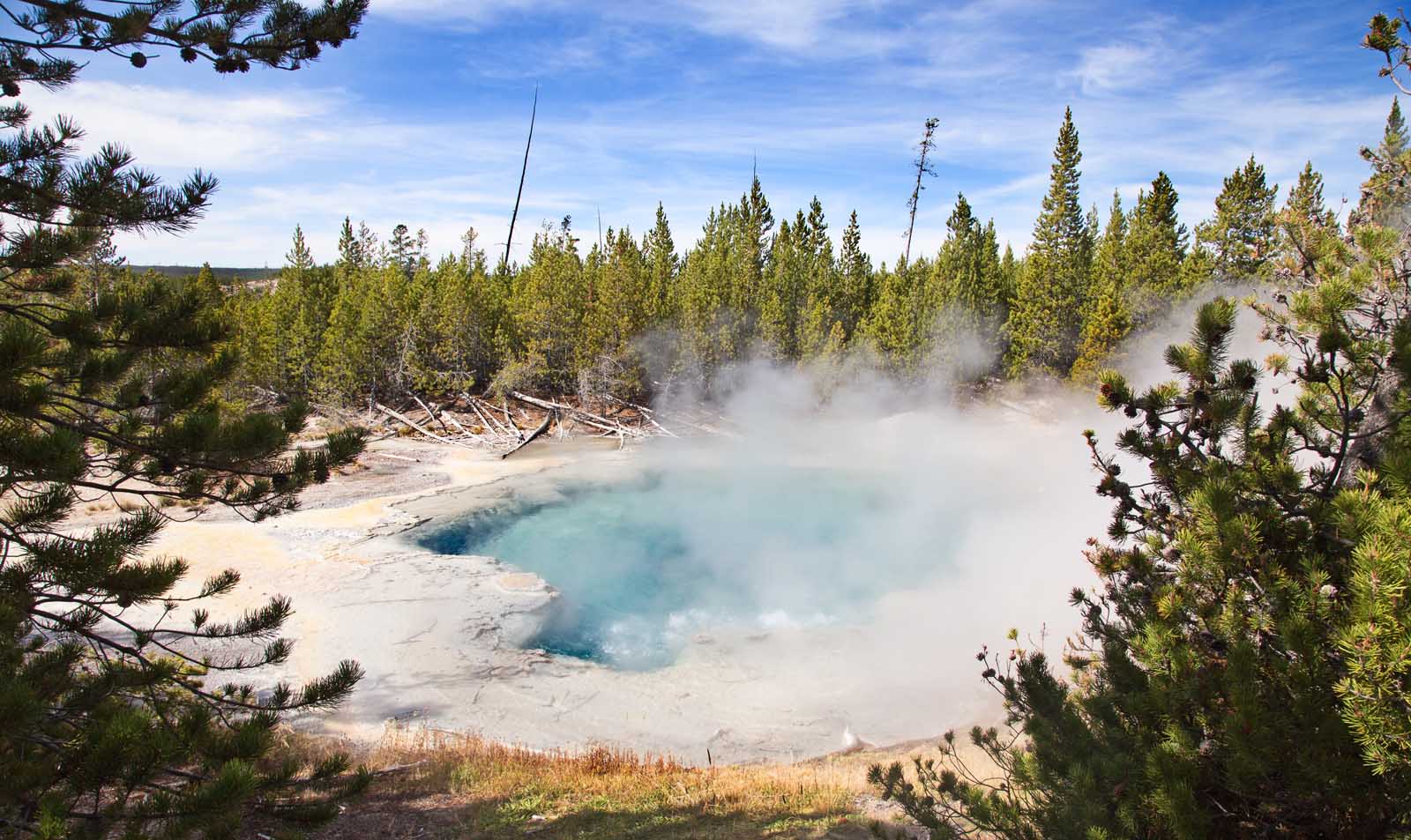
Another one of the great geyser basins in Yellowstone National Park is the Norris Geyser Basin. Cool fact.
Norris Geyser Basin is the hottest and oldest geyser basin in Yellowstone. Here, you’ll see colorful hot springs and some wild animals like bison and elk.
Walking through Norrish Geyser Basin toward Back Basin, you’ll pass the world’s tallest active geyser, Steamboat Geyser. Steamboat Geyser isn’t predictable like Old Faithful, but when it does erupt, steaming water and steam can reach 300 feet into the air.
23. Mount Washburn
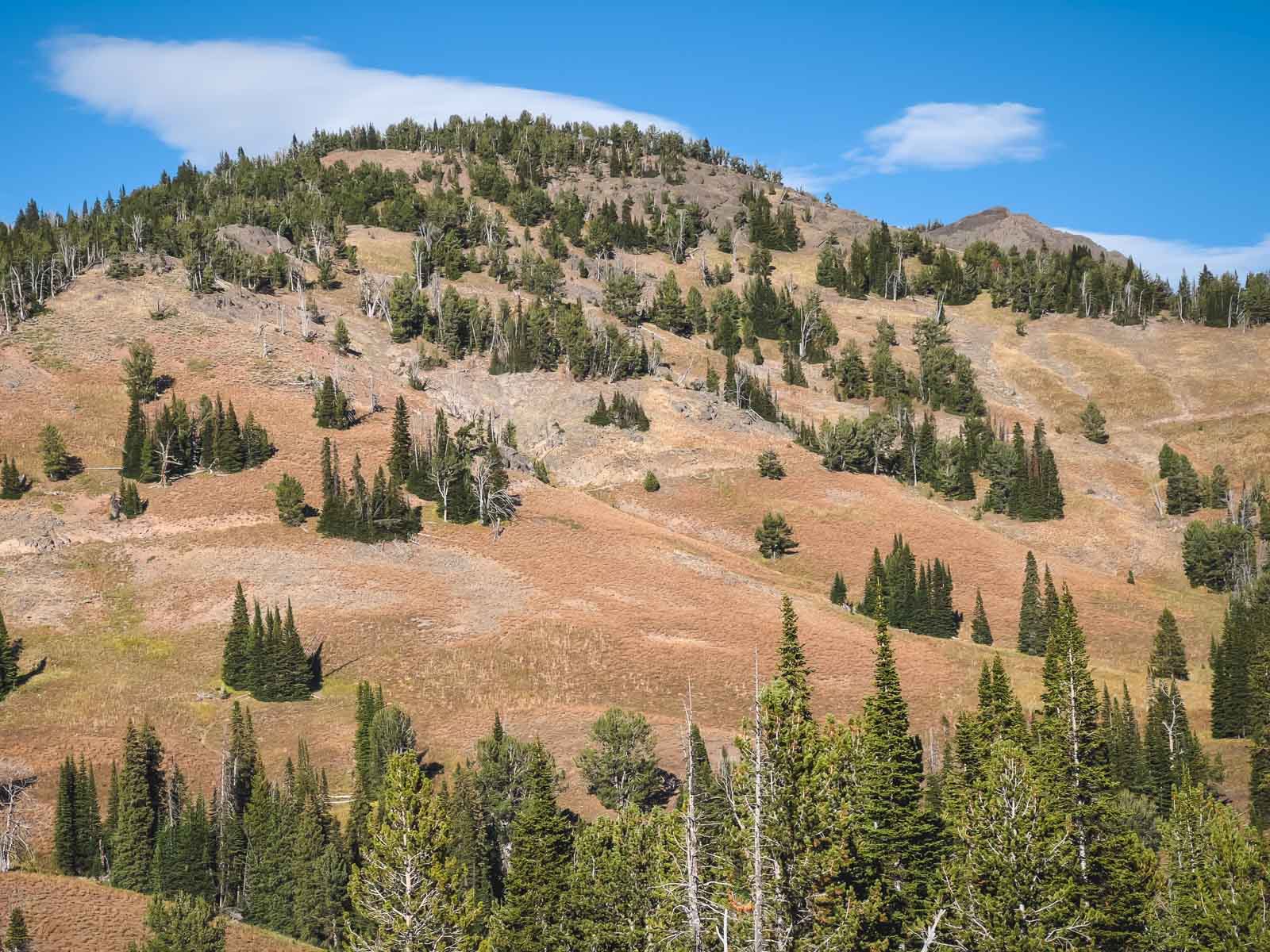
When driving from Canyon Village through Dunraven Pass to the Lamar Valley, you’ll pass Mount Washburn. There are great viewpoints here, and it is a popular place to go for a challenging hike.
If it’s your first visit to Yellowstone, you may not want to include this in your itinerary unless you have plenty of time, as it is a 6-mile hike that can take up to 6 hours. During this hike, you may encounter Bighorn Sheep, Grizzly Bears, and even wolves.
Make sure to keep your distance from all of them, including the Bighorn Sheep. When walking the trail, make plenty of noise to let the wildlife know you are there. They want to avoid you as much as you want to avoid them.
24. Mud Cauldron
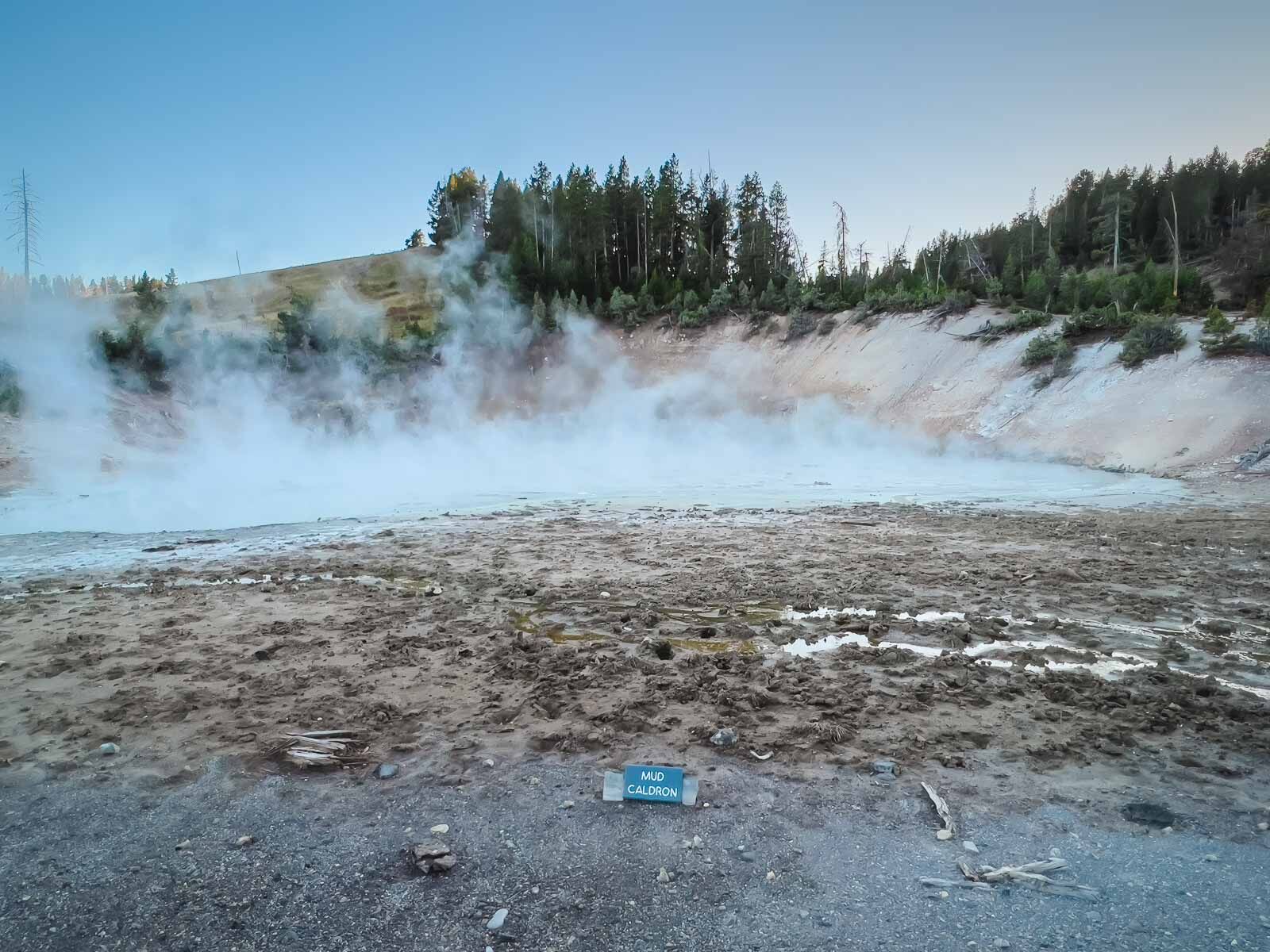
We had read about the mud volcano and mud pots before visiting Yellowstone, and it wasn’t until we were on our way out of the national park that we spotted the Mud Cauldron. The sun was setting, but we had to see this!
You can view Mud Cauldron right from the parking lot or walk through the grounds on the wooden paths. Mud Geyser was a popular Yellowstone attraction in the 1800s, with mud spewing 50 feet into the air. It has since settled but it is here that you will also see the Mud Volcano which is a crater filled with bubbling mud.
Things to do in Yellowstone in 3 Days
As you can see, you can do a lot in Yellowstone in two days. If you have more time, and want to spend another day in this incredible national park, keep reading!
25. West Thumb Geyser Basin
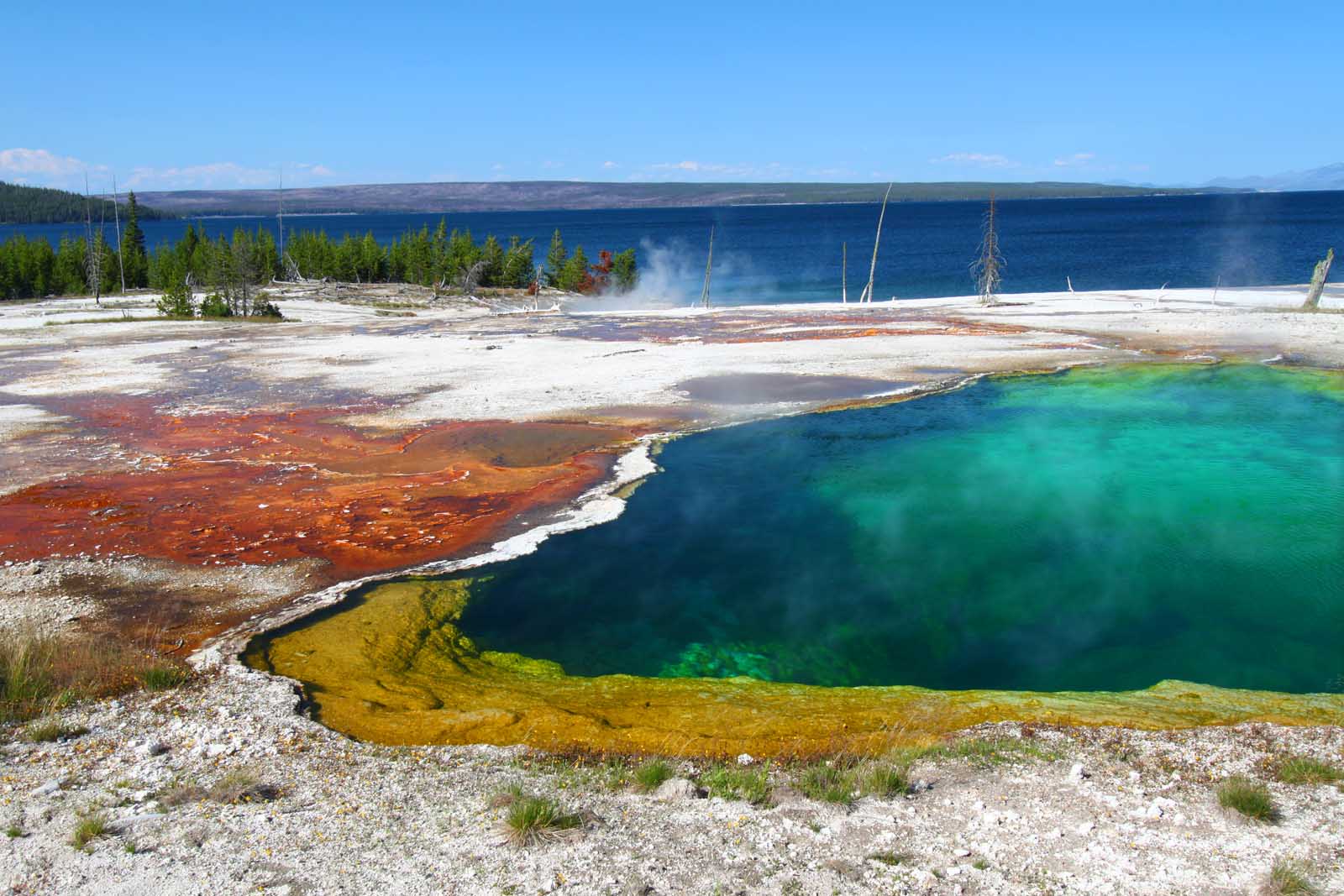
Nestled on the shores of Yellowstone Lake, West Thumb Geyser Basin is where geothermal features meet the tranquil waters, creating a landscape like no other. This unique basin is often overshadowed by Yellowstone’s more famous geysers as it is a serene and picturesque setting that’s perfect for both relaxation and exploration.
Stroll along the boardwalks and witness a stunning array of hot springs, mudpots, and geysers, including the famous Abyss Pool the deepest hot spring in Yellowstone, the colorful Thumb Paint Pots and the very cool fishing geyser, where a hot spring juts out from the lake.
Each step reveals a new marvel, from the deep blue hues of the hot springs to the vibrant oranges and greens of the microbial mats. The backdrop of Yellowstone Lake adds a calming presence, making it ideal for families and solo travelers alike.
West Thumb Geyser Basin combines the awe of Yellowstone’s geothermal activity with the tranquility of its largest lake, offering a quieter yet equally captivating experience.
26. Lower Geyser Basin / Fountain Paint Pots
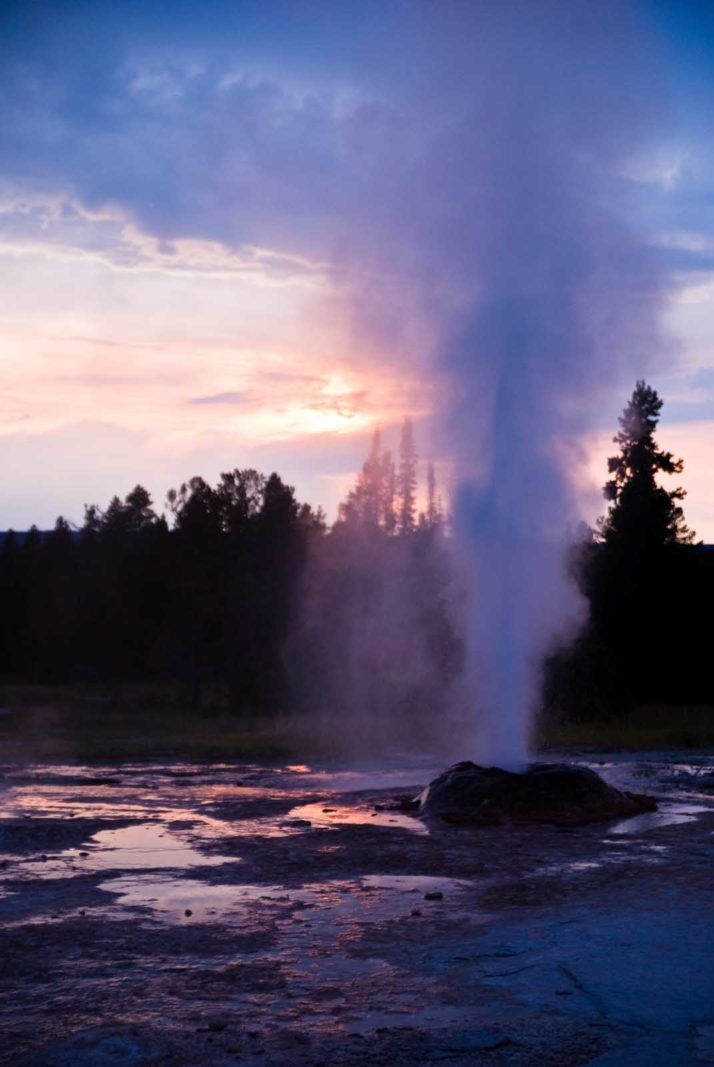
Lower Geyser Basin is Yellowstone’s largest geyser basin covering 11 square miles where an extraordinary tapestry of geothermal features awaits. This sprawling basin offers a diverse collection of hot springs, mud pots, fumaroles, and geysers.
Start at the Fountain Paint Pot, where you can observe colorful mudpots bubbling and hissing. A short walk away, the reliable Fountain Geyser offers regular eruptions, a thrilling spectacle of nature’s power. The Great Fountain Geyser is known for its high eruptions that occur approximately every 9 to 15 hours. The eruptions last up to 30 minutes and can reach up to 75 feet. Check eruption predictions for the best viewing times with the park reangers. .
Explore the Firehole Lake Drive, a one-way loop that takes you past several small geysers, including White Dome and Pink Cone Geysers, each offering unique photo opportunities. The area is also home to the Celestine Pool and Morning Geyser, providing a glimpse into the diverse range of thermal activity in Yellowstone.
Located in West Yellowstone there are accessible boardwalks to walk right through the hot springs and geysers.
27. Continental Divide
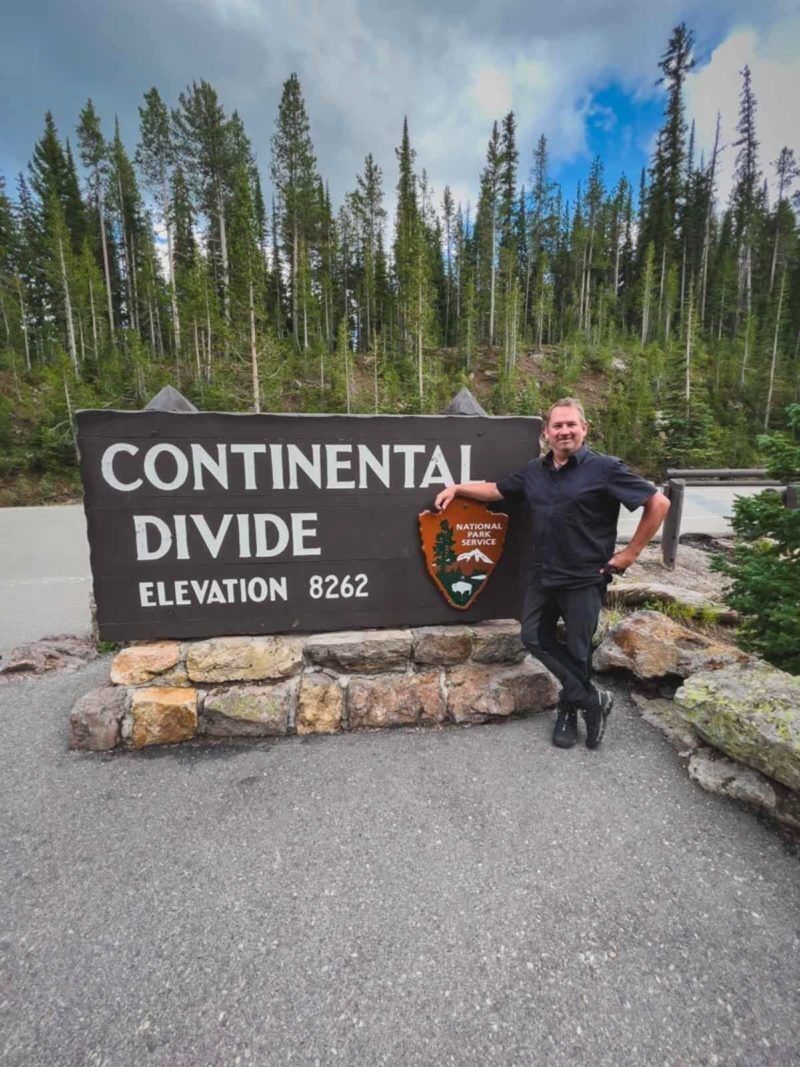
The Continental Divide runs through Yellowstone National Park and can be found at several locations within the park. This divide is a natural boundary that separates North America’s river systems, determining whether water flows towards the Atlantic Ocean or the Pacific Ocean.
In Yellowstone, the Continental Divide crosses through the park in a somewhat zigzag pattern.
Isa Lake on Craig Pass: This is one of the most unique spots along the Divide in Yellowstone. Located near the Old Faithful area, Isa Lake is famous for being one of the few natural lakes in the world that drains into two different oceans – east into the Atlantic and west into the Pacific.
Two Ocean Plateau: This area feeds two different watersheds that lead to different oceans. To the west, the waters flow into the Pacific, and to the east, they flow into the Atlantic.
Along the Park’s Southern Border: The Divide also runs along the park’s southern border, near the South Entrance.
Visitors to Yellowstone can see signs and markers indicating the location of the Continental Divide as they travel through these areas. It’s a fascinating geographical feature that adds to the park’s array of natural wonders.
28. Go Horseback Riding
We saw some people horseback riding during our early morning drives. A guided horseback riding tour is the easiest way for visitors to experience horseback riding in Yellowstone. The two areas that have horseback riding are to take a guided one- and two-hour rides are available through a concessionaire near the Canyon Village.
Roosevelt also has guided riding. Here, you’ll find various guided horseback rides, including short rides, all-day rides, and even a cookout experience where you ride to a cookout site for a meal.
29. Buffalo Bill Cody Scenic Byway
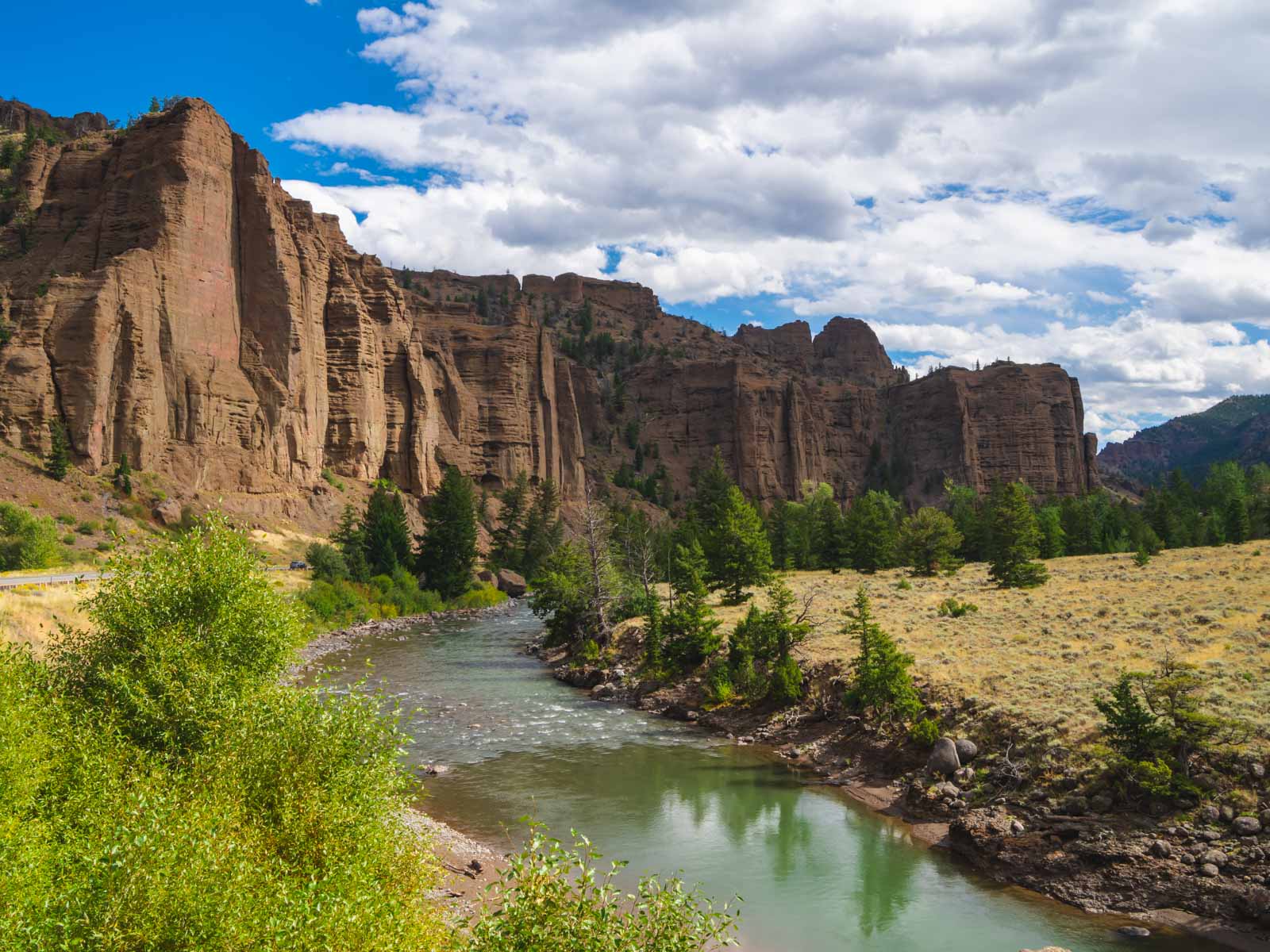
We drove to Yellowstone from Cody, Wyoming. Cody is 52 miles from the east entrance of Yellowstone and is a great place to visit before or after your time in Yellowstone. See our complete guide here: Things to do in Cody, Wyoming – Wild West Gateway to Yellowstone
We entered Yellowstone National Park from the East entrance after exploring Cody, Wyoming for a couple of days. During our drive to Yellowstone, we left at 4 in the morning so we missed it on our way in, but when we went back to Cody, we took half a day to enjoy this road that leads directly to the East Entrance.
It is worth driving in daylight! President Roosevelt called it the most beautiful scenic drive in the world and we can understand why. There are hoodoos and high canyon walls lining the highway. This road passes through Buffalo Bill Cody State Park, and the first National Forest in America, The Shoshone National Forest. Make sure to stop at the ranger’s station to see the original structure that has been in constant use for more than 100 years.
What are the most popular places to visit in Yellowstone?
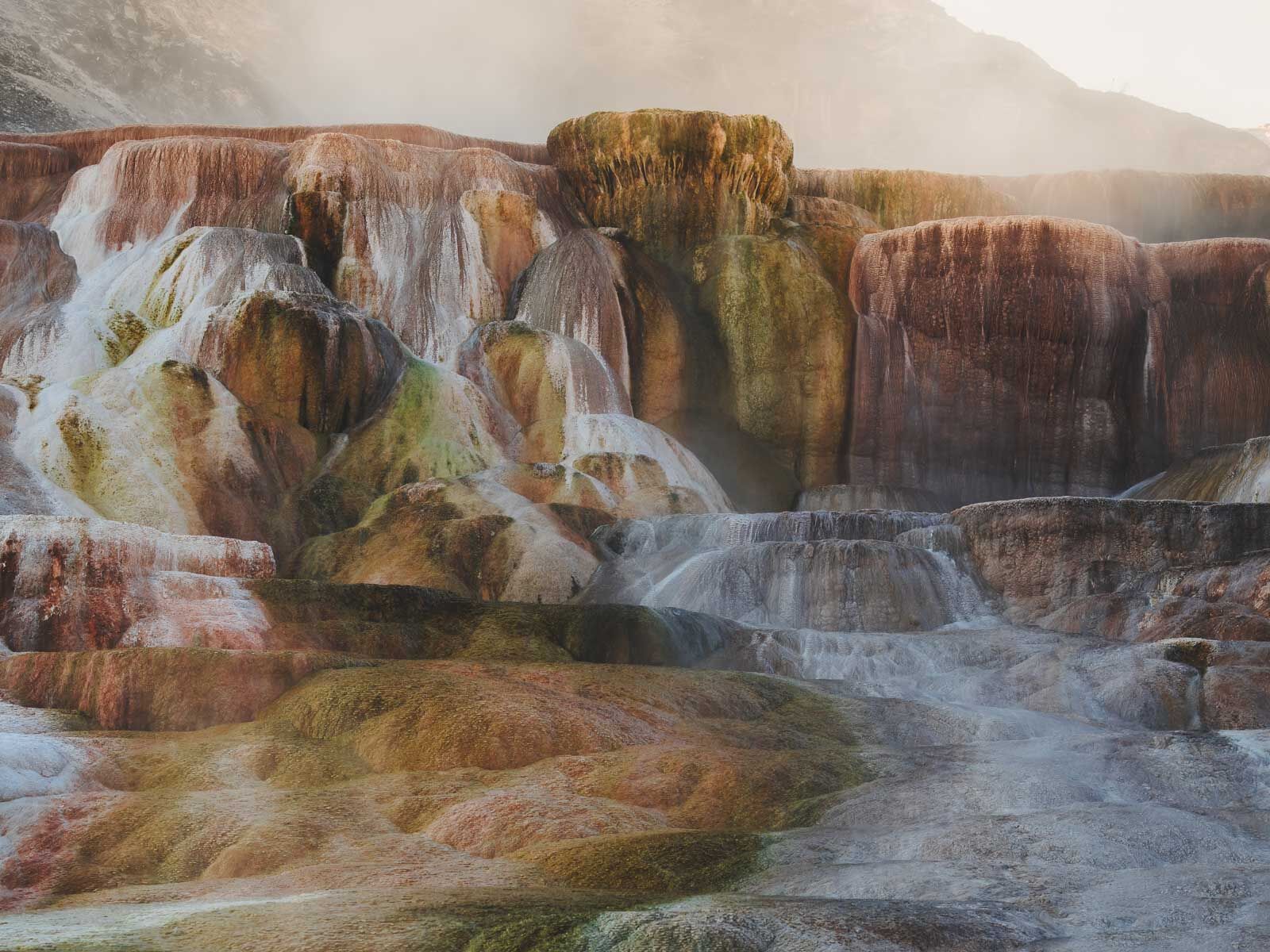
The post popular places to visit in Yellowstone are Midway Geyser Basin where you’ll find Grand Prismatic Hot Springs, Upper Geyser Basin which includes Old Faithful and Morning Glory Pool, Mammoth Hot Springs, and Norris Geyser Basin.
Besides the Geyser Basins, the Grand Canyon of The Yellowstone is worth visiting to see its waterfalls, and viewpoints. And Hayden Valley and the Lamar Valley are the best for spotting wildlife such as bison, grizzly bears, elk, and grey wolves.
When is the Best Time to Visit Yellowstone?
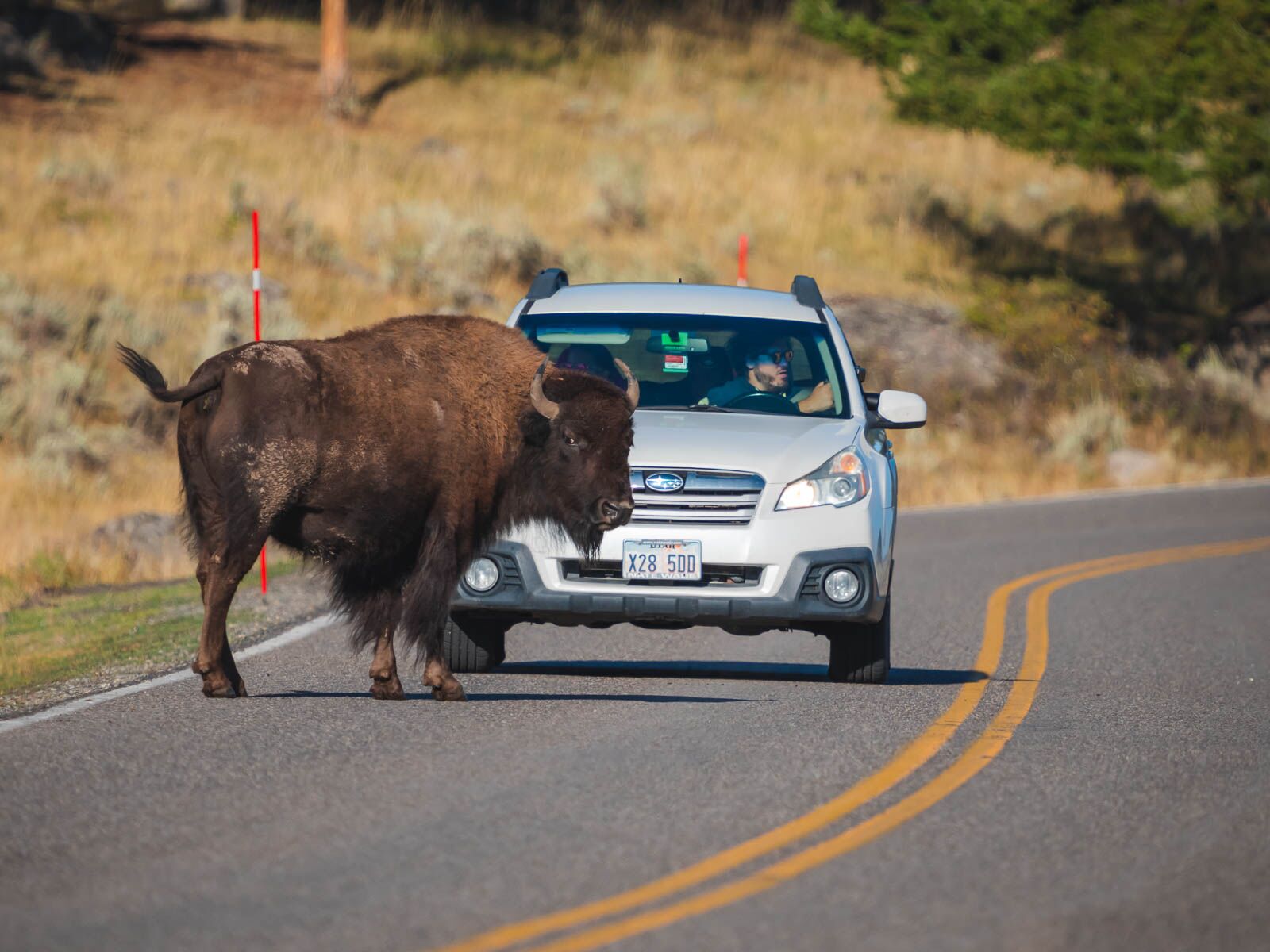
If you are looking for the best time to visit Yellowstone to avoid the crowds, go in the off-season. We went in September and it was nice and quiet. April and October are also good times to visit Yellowstone with fewer crowds and good weather.
The peak season in Yellowstone is June, July, and August. This is when you’ll experience the most crowds.
The best time to visit Yellowstone attractions is at sunrise and sunset. You’ll see fewer crowds and this is when wildlife is most active.
Tips for Visiting Yellowstone National Park
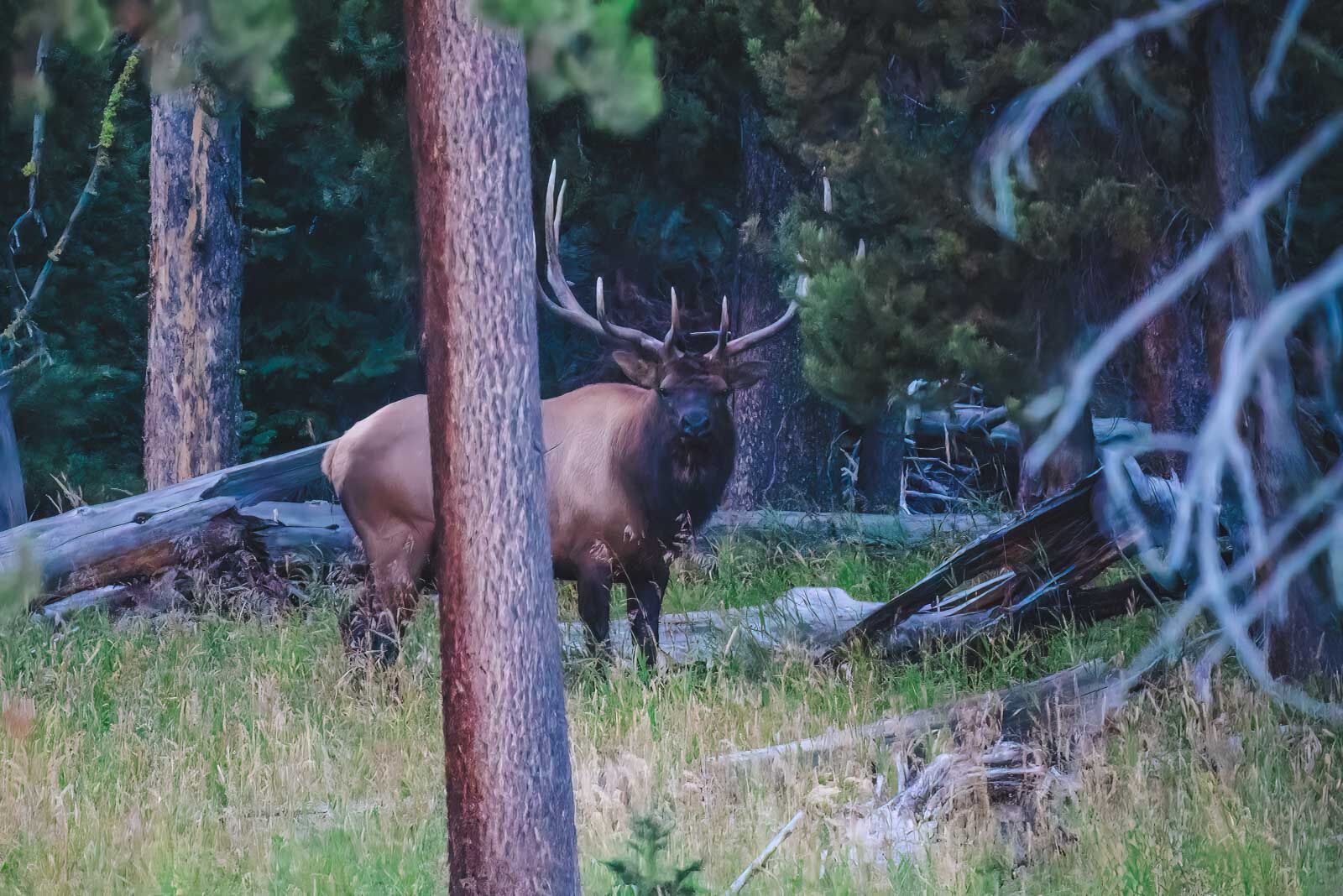
When you visit Yellowstone, there is a $35 enterance fee. But we recommend getting a National Parks Pass if you plan on visiting any other National Parks within the year. You can get a National Parks Pass from the National Park Service online here.
Driving distances are long in Yellowstone. It is a very large national park, so we suggest getting up well before sunrise to be at your first destination the moment the sun comes up. This is the best way to avoid crowds. We also stayed out until after sunset and managed to fit plenty of the top things to do in Yellowstone into each day.
Be very careful after dark as the animals are most active at sunrise and sunset and we saw plenty of elk and deer standing on the side of the road ready to bolt out in front of our car.
If you want to know when Geysers will erupt including Old Faithful, go into the visitor center for a schedule. Even though Old Faithful Geyser is the most predictable, there are still other geysers that they can make predictions about within two to several hours.
Safety In Yellowstone National Park
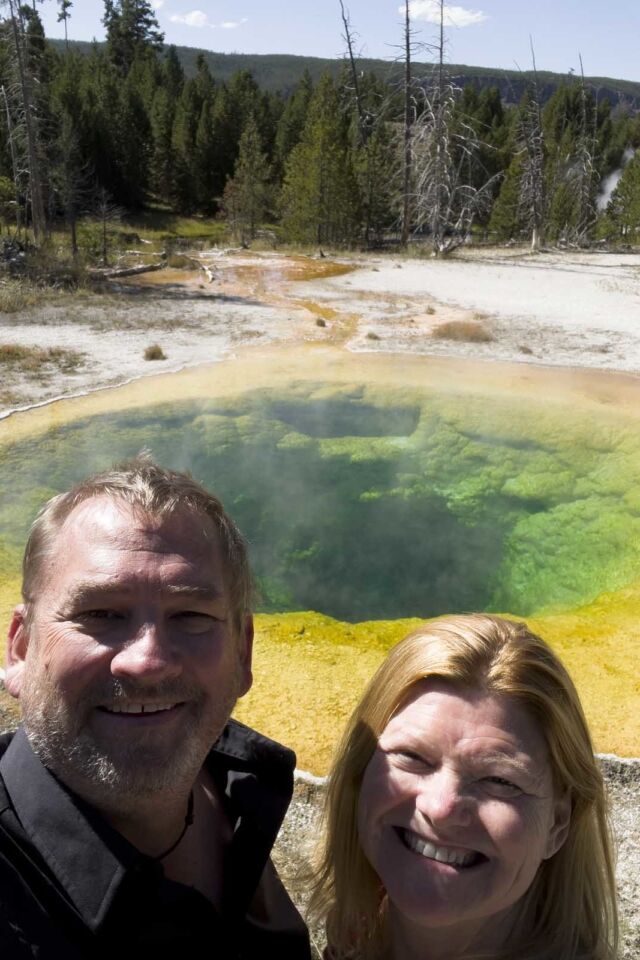
It is very important to stick to the trails and boardwalks in Yellowstone. It can be very dangerous to go off the designated paths in Yellowstone.
Do not walk on any of the geothermal areas. Stay on the boardwalks. Falling into a hot spring can cause death in mere minutes and it is illegal. There ha ve been deaths in Yellowstone when people illegally left the boardwalk.
Deaths have been as recent as 2022 when a 70 year old man fell into the Abyss hot spring and in 2016 when a 23 year old man walked more than 200 yards in the Norris Geyser Basin and fell into a hot spring.
Some springs are not only scalding hot but highly acidic, so death or severe injuries can happen if you slip or fall into them. Staying on the boardwalk is essential. These deaths occured when people ventured off the designated walking areas.
Where to Stay in Yellowstone National Park
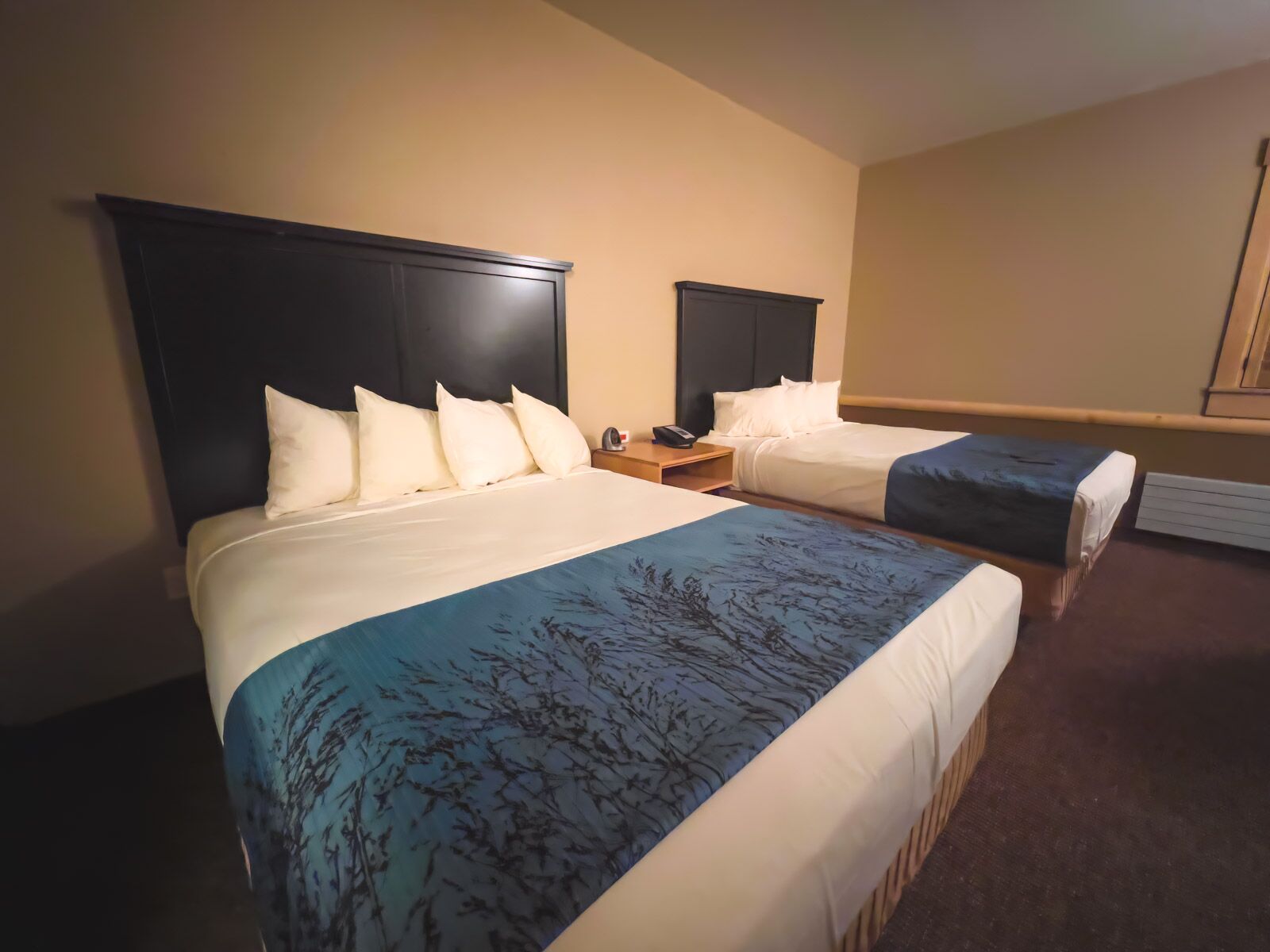
We stayed at the Canyon Lodge & Cabins at Canyon Village and found it to be a great base to explore Yellowstone. The Canyon Lodge has a cafeteria-style restaurant and there is a coffee shop at reception. This is an excellent location that is nice and central for sightseeing.
We stayed in a Deluxe New Lodge Room with a refrigerator, coffee maker, and two queen beds. There are no TVs and we couldn’t make the Internet work, but we had data on our phones so it didn’t matter. Remember, you are not here to watch TV or surf the Internet anyway.
You can also catch the Wake Up to Wildlife and Evening Wildlife Tours from here.
Other areas to stay in Yellowstone are around Old Faithful. Old Faithful Inn is a national landmark but there is also the Old Faithful Lodge and Old Faithful Snow Lodge and Cabins.
Hiking in Yellowstone National Park
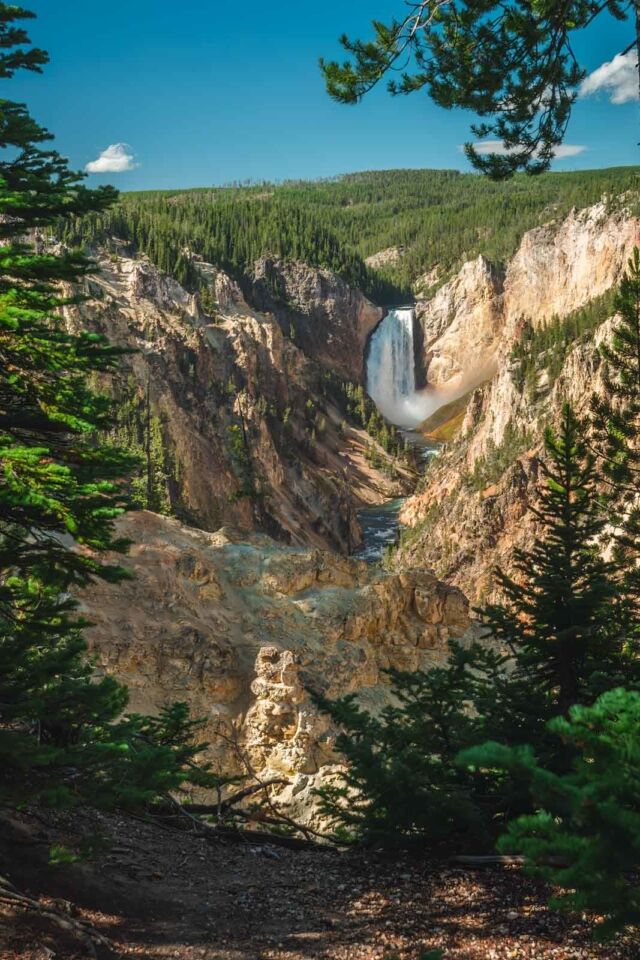
There are plenty of hiking trails in Yellowstone, but if you are going make sure to keep an eye out for wildlife. You are allowed to hike to hills and better vantage points in places like the Lamar Valley, but you need to be aware of wildlife.
Yellowstone National Park services suggest carrying bear spray if you go hiking. We have never understood this recommendation as the experts that we have talked to say that it can cause more harm than good. If you are going to carry bear spray, make sure to know how to use it.
We have learned from our backcountry hiking that hiking in numbers and making a lot of noise is the best best. That way you won’t surprise any animals. Keep talking and keep your eyes peeled. We have a complete guide to the best hikes in Yellowstone National Park
How to Get to Yellowstone National Park
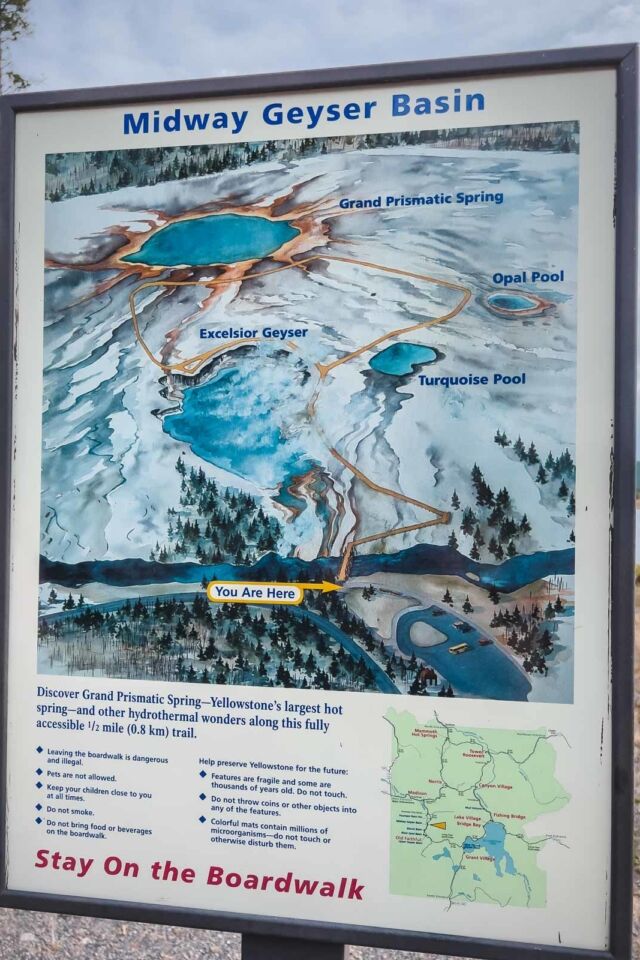
We flew into Cody Wyoming and feel that it is a fantastic place to start your Yellowstone road trip. Cody is located 50 miles from Yellowstone and is a place that you should spend at least two days exploring. You can rent a car and then drive into Yellowstone through the East Entrance. The East Entrance is the closest entrance to Yellowstone Lake.
But there are five entrances to Yellowstone Park and you can fly into airports near all of them.
Cody Yellowstone Regional Airport is located in Cody which is an excellent gateway to Yellowstone National Park at one hour from Yellowstone East Entrance. Yellowstone Airport is the closest airport to Yellowstone located just outside the West Entrance Jackson Hole is 1 hour from the South Entrance. Bozeman Yellowstone International Airport is 1.5 hours from the North Entrance.
Yellowstone National Park Map
Most of the Yellowstone attractions are located directly off Grand Loop Road. Many are accessible and easy to walk to. Once you see how easy it is to see its many landmarks, you’ll understand why it attracts nearly 5 million visitors each year. So, are you ready to see the most beautiful places in Yellowstone? Let’s get started.
Yellowstone National Park Entrances
There are five entrances to Yellowstone National Park. The North Entrance, Northeast Entrance, East Entrance, South Entrance and West Entrance.
The North Entrance
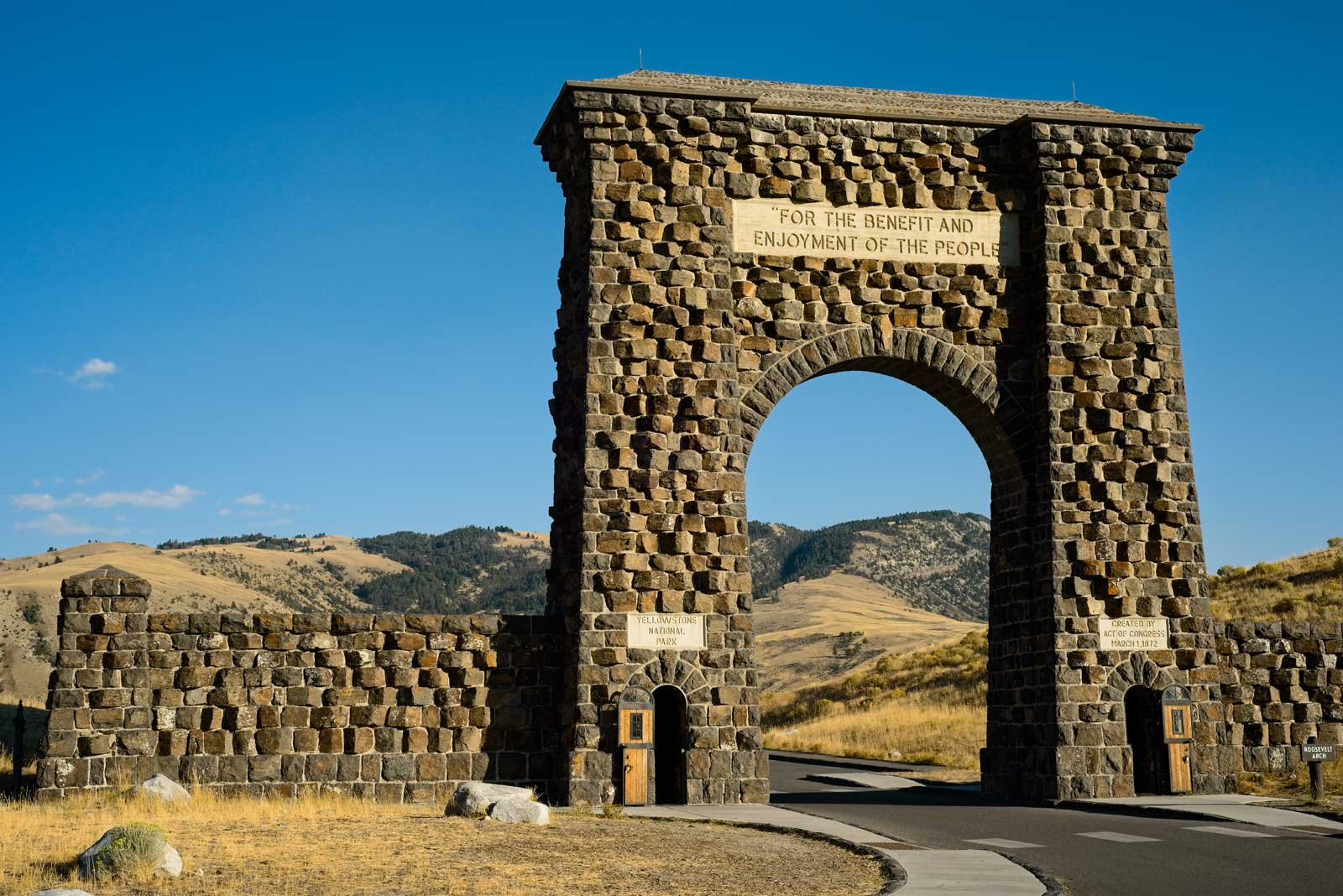
The North Entrance is the only entrance to Yellowstone that is open year-round. Located between Cooke City and Mammoth, this entrance has the famous Roosevelt Arch. The historic stone archway marking the North Entrance of Yellowstone National Park is located in Gardiner, Montana, it has become an iconic symbol of the park.
The arch was constructed in 1903 and named in honor of President Theodore Roosevelt, who laid its cornerstone during a visit to the park. Roosevelt played a significant role in the conservation movement in the United States and was a staunch advocate for the preservation of the nation’s natural wonders.
The arch is inscribed with the words, “For the Benefit and Enjoyment of the People,” which is taken from the Organic Act of 1872, the legislation that established Yellowstone as the world’s first national park.
East Entrance
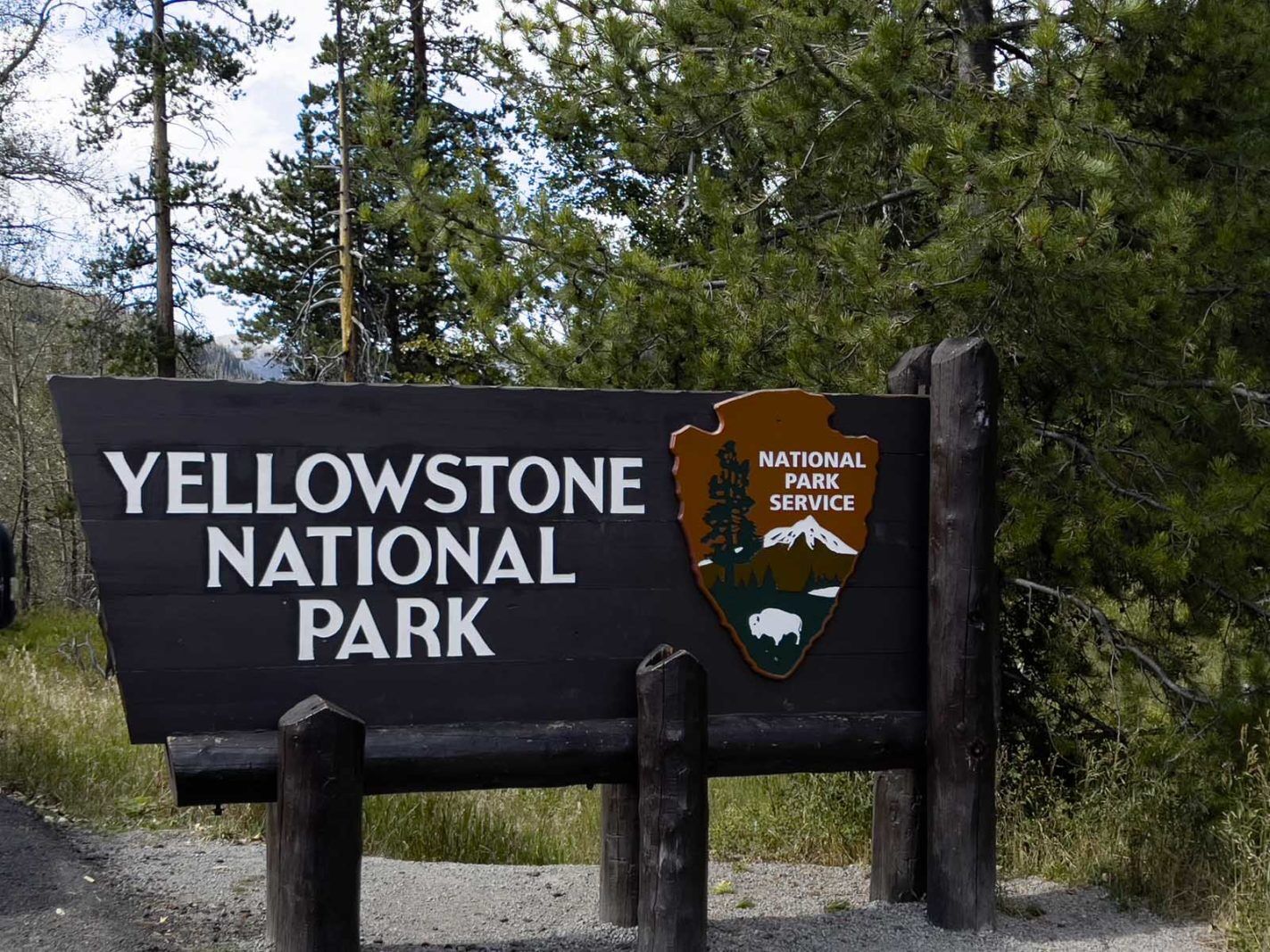
We entered from Cody, Wyoming which took us to the East Entrance. The East Entrance is the closest to Yellowstone Lake and you will take the Buffalo Bill Scenic Byway to get there from Cody.
West Entrance
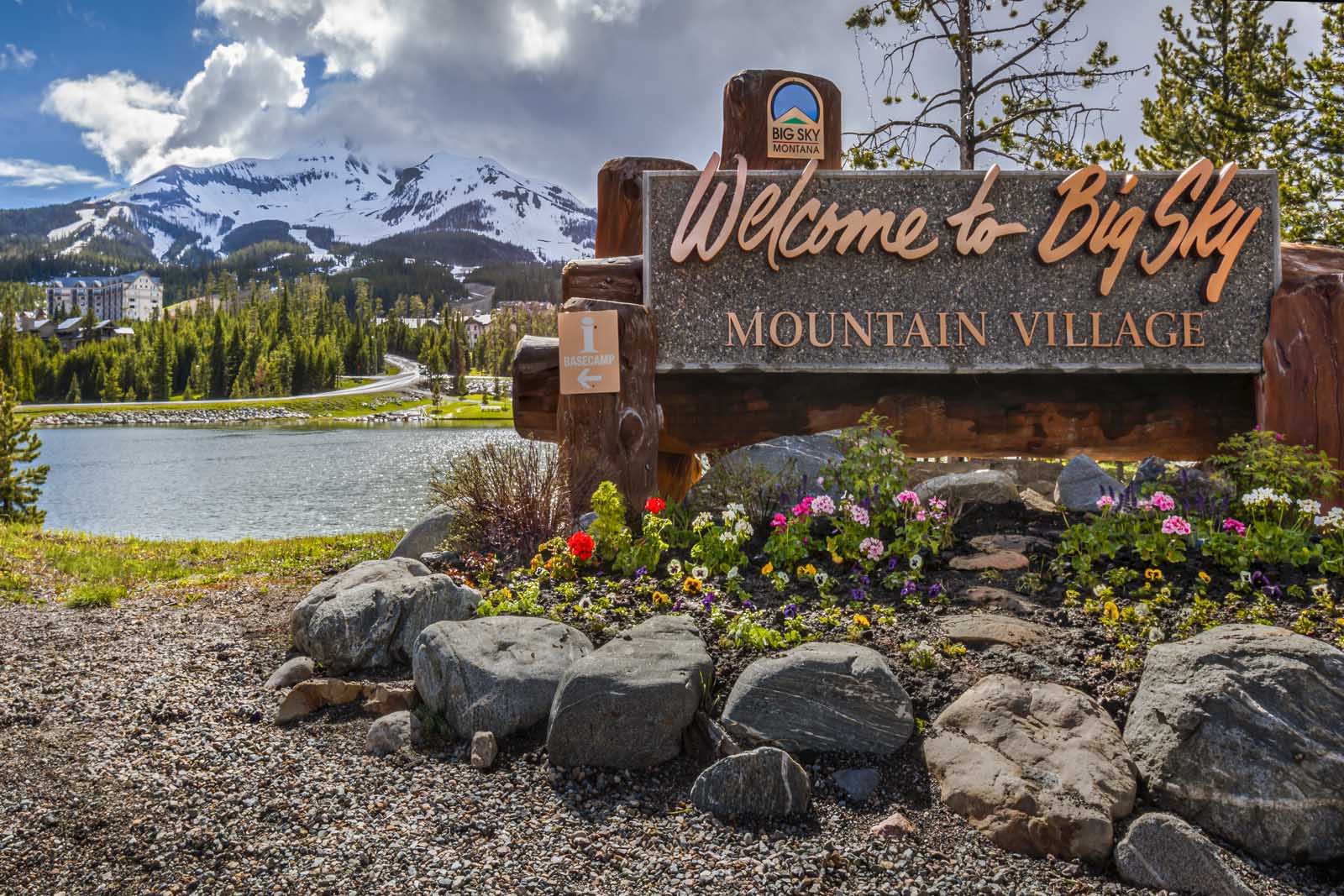
The West Entrance is located in Montana and has plenty of accommodation outside West Yellowstone. This is a good option if you don’t want to pay the extra money to stay in Yellowstone Park or if accommodations are booked up.
Hotels here are only about 15 minutes from the West entrance. The West Entrance is the closest to Old Faithful making it the busiest entrance in the park. When we were leaving the upper geyser basin, we were happy to be turning right rather than joining the traffic turning left toward West Yellowstone at the end of the day.
The Grizzley and Wolf Discovery Center is located just outside the West Entrance, so if you didn’t see grizzlies or wolves, the Wolf Discovery Center is a place where you can see rescued animals living in. There are plenty of things to do in West Yellowstone, including the Zipline Adventure in Montana.
Northeast Entrance
The northeast entrance to Yellowstone Park is the fastest way to the Lamar Valley. The northeast entrance is located in Montana.
South Entrance
The South Entrance is located in Wyoming and is often combined with a visit to Grand Teton National Park.
The Grand Loop Road is shaped like a figure 8 and connects all the best things to do in Yellowstone National Park. We suggest tackling one loop at a time, depending on how many days you have.
The Grand Loop is genius! It was created in 1915 to connect most of the best attractions in Yellowstone National Park. The road is 140 miles long (230 km) and you’ll spend a lot of time driving this route from West Yellowstone to East and North Yellowstone to South.
Can You Swim in Yellowstone?
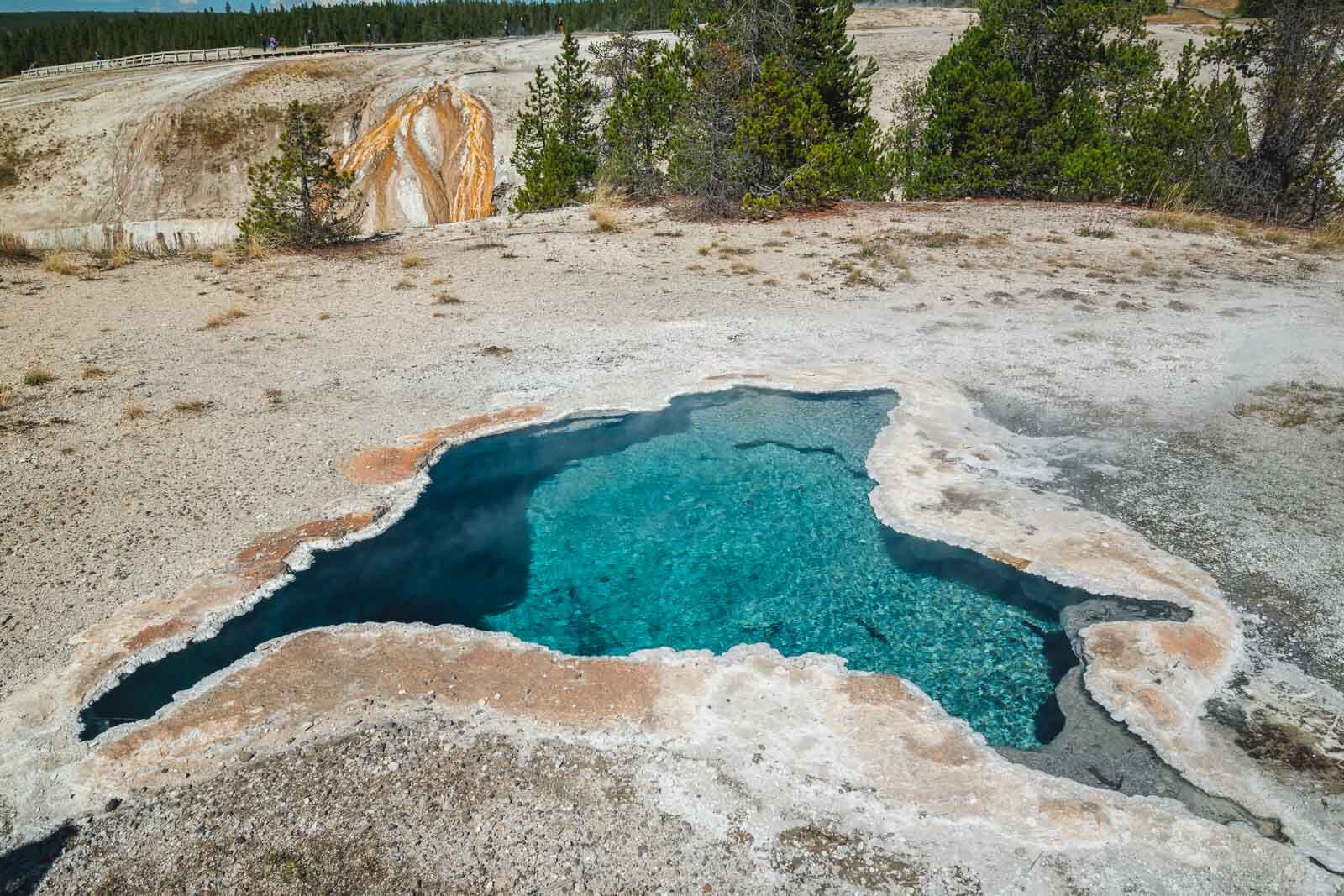
There are only two designated swimming areas in Yellowstone National Park, Boiling River, and Firehole River Swim Areas. It can be dangerous to swim in Yellowstone Lake and its rivers due to cold temperatures. However, with boiling water and hot springs scattered throughout the park, you can also run the risk of scalding. It is forbidden to swim in geothermal areas.
Therefore stick to the two places that are designated for swimming. Boiling River is located near the Mammoth area in the Gardiner River. Firehole River is located on Firehole Canyon Drive south of Madison Junction. Read the signs and watch for warnings as they are not open all of the time.
How many days are needed in Yellowstone?
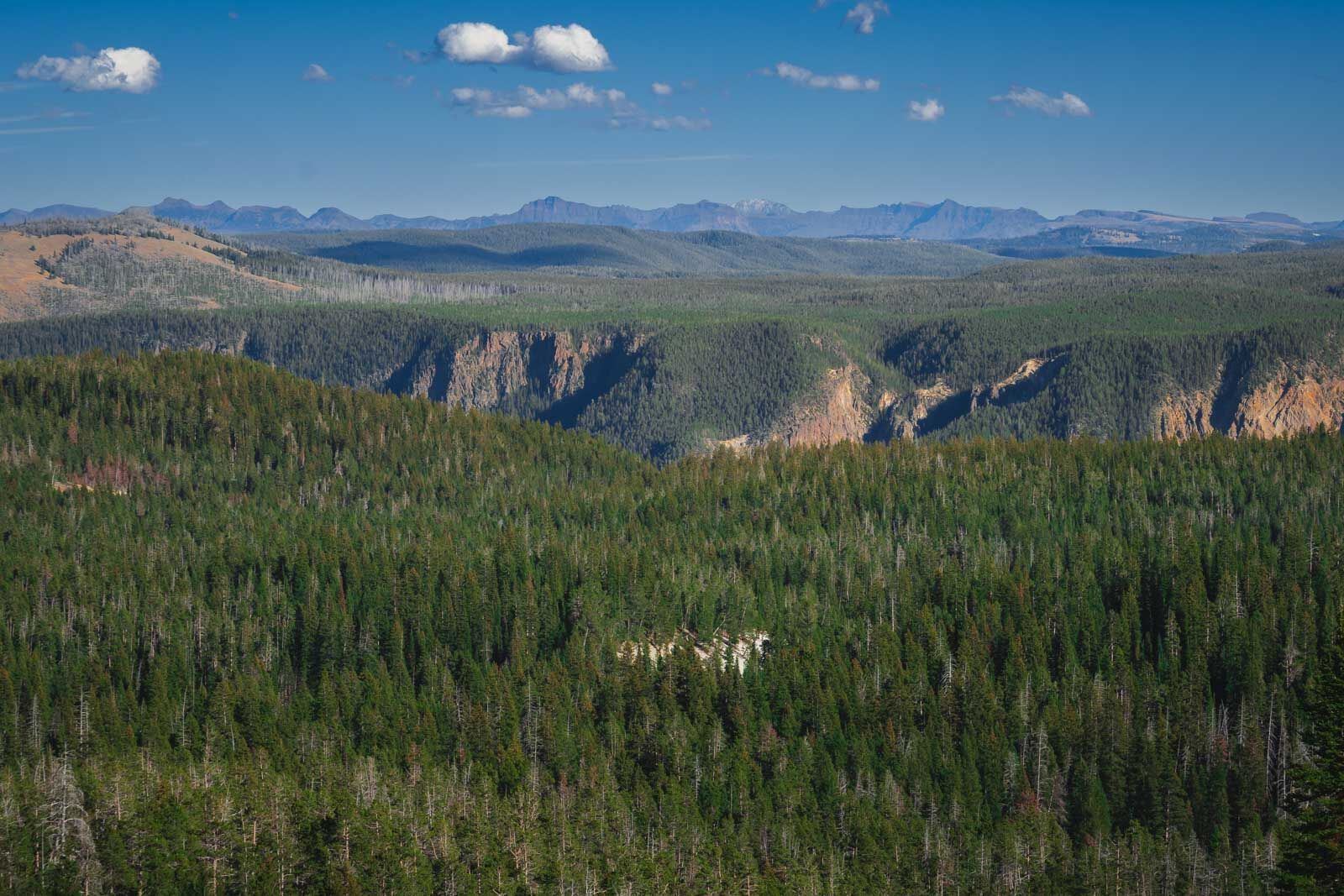
While you can get a glimpse of the park’s highlights in a day or two, ideally, you should spend at least 3-5 days to experience a significant portion of what Yellowstone has to offer.
How do you spend 4 days in Yellowstone?
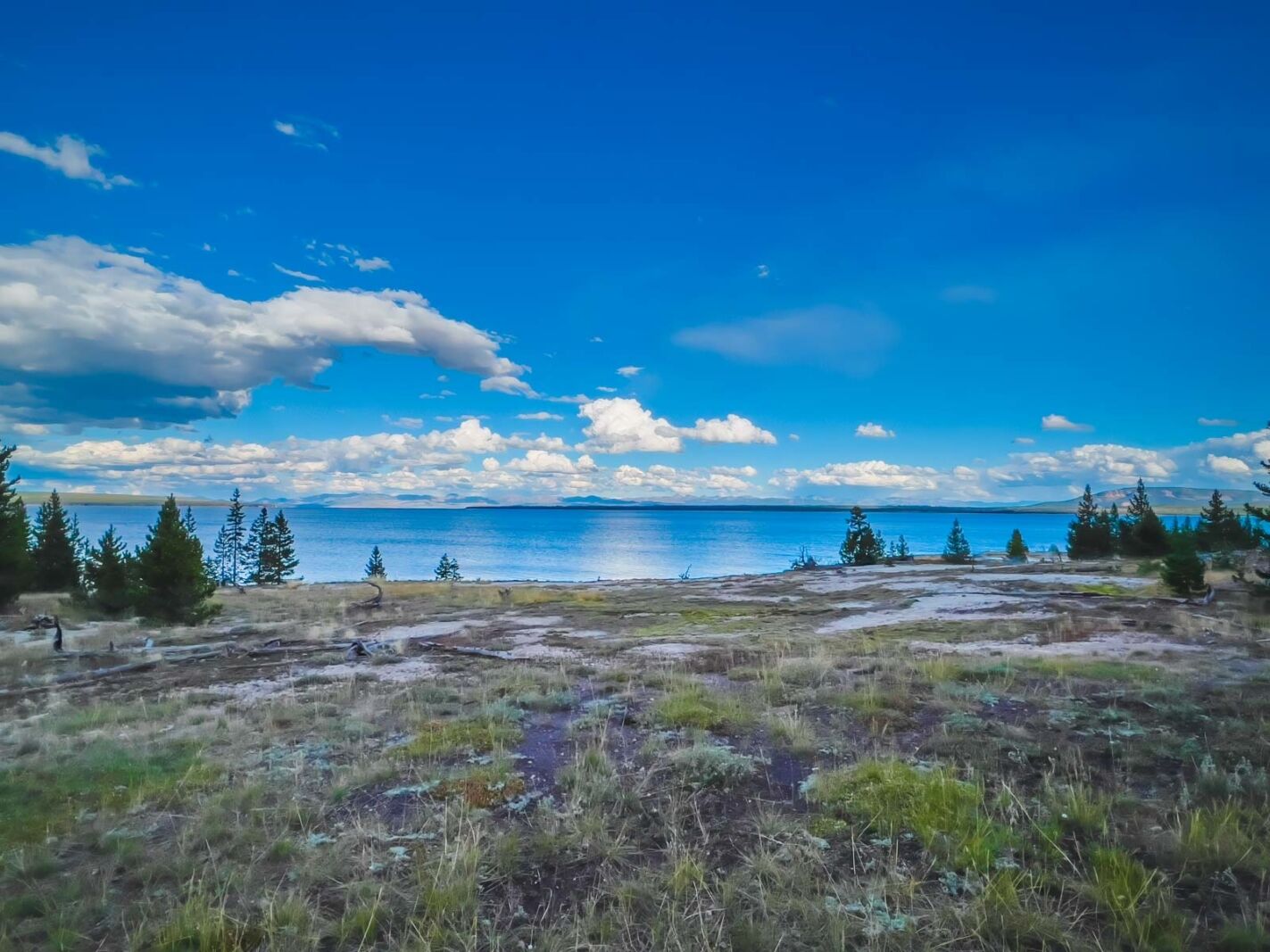
Three to Five days is ideal to visit Yellowstone. Here is a potential 4-day itinerary that you can follow to see the most of Yellowstone National Park. We have already outlined a three days in Yellowstone itinerary. If you have time for four days in Yellowstone, here is an itinerary to get you started.
Day 1: Begin with the Lower Loop: Visit Old Faithful, Grand Prismatic Spring, and the Grand Canyon of the Yellowstone. Day 2: Explore the Upper Loop: Visit Mammoth Hot Springs, Tower Fall, and Lamar Valley for wildlife watching. Day 3: Spend the day hiking some trails, such as the Mount Washburn hike or the Mystic Falls trail. Optionally, partake in a ranger-led program in the evening. Day 4: Visit West Thumb Geyser Basin and spend some time at Yellowstone Lake. You can also choose to explore areas or attractions you may have missed or revisit favorites.
What is the number one attraction at Yellowstone?
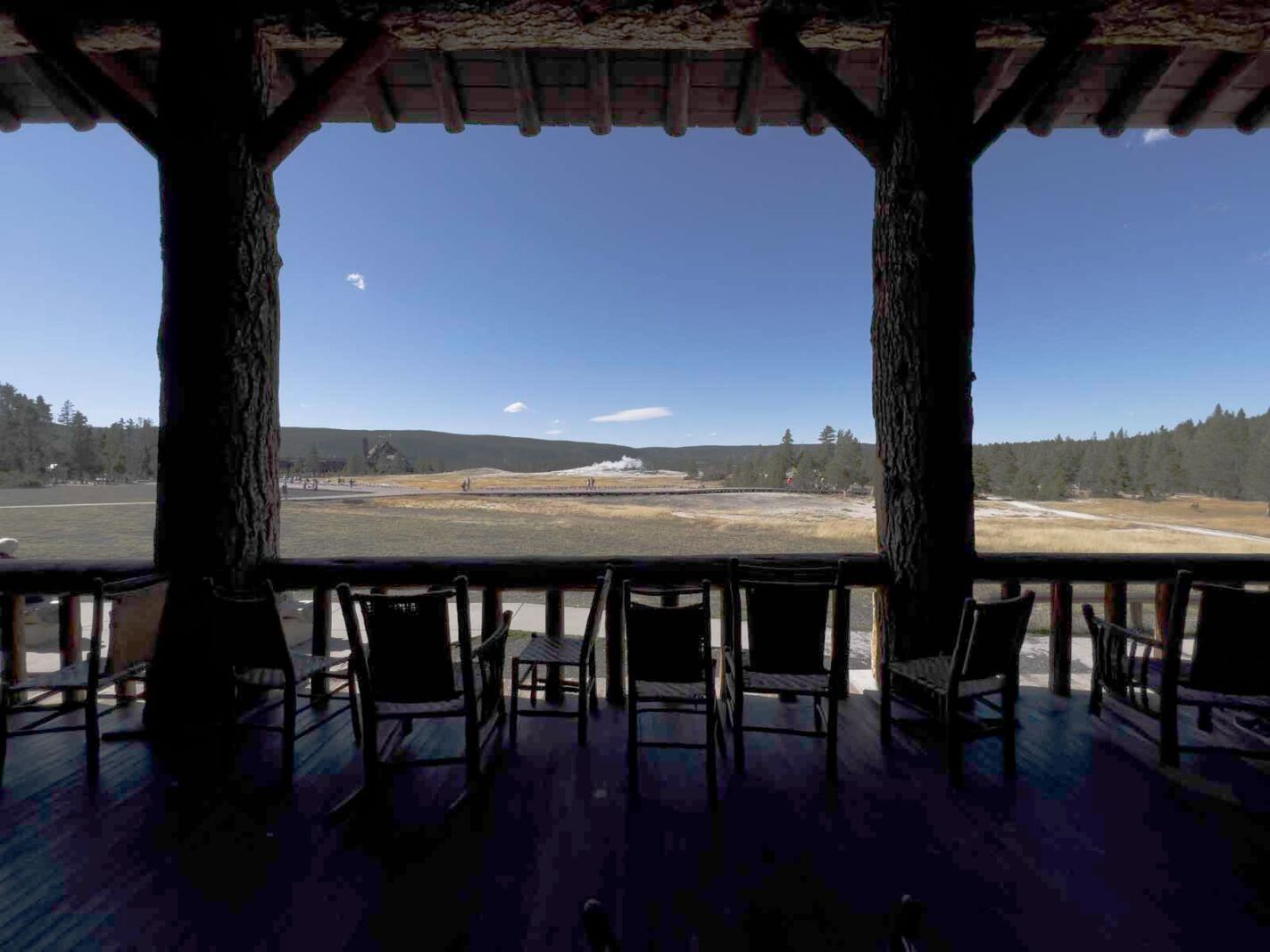
The most iconic attraction in Yellowstone national park is arguably Old Faithful, the world-famous geyser that erupts on a predictable schedule. Almost every organized tour will visit Old Faithful and even if someone has other items on their Yellowstone bucket list, they will always stop at Old Faithful. However, the park boasts many other equally impressive sights.
Yellowstone NP is one of the best national parks on earth. We were truly surprised and impressed with how beautiful this national park is. We knew we were going to see beautuiful landscapes, but the amount of impressive geysers, geothermal formations and wildlife went far beyond our expecations. If you are going to add one national park in the United States to your travel list, make it Yellowstone.
Read more National Parks in the USA
[ad_2]
Source link

